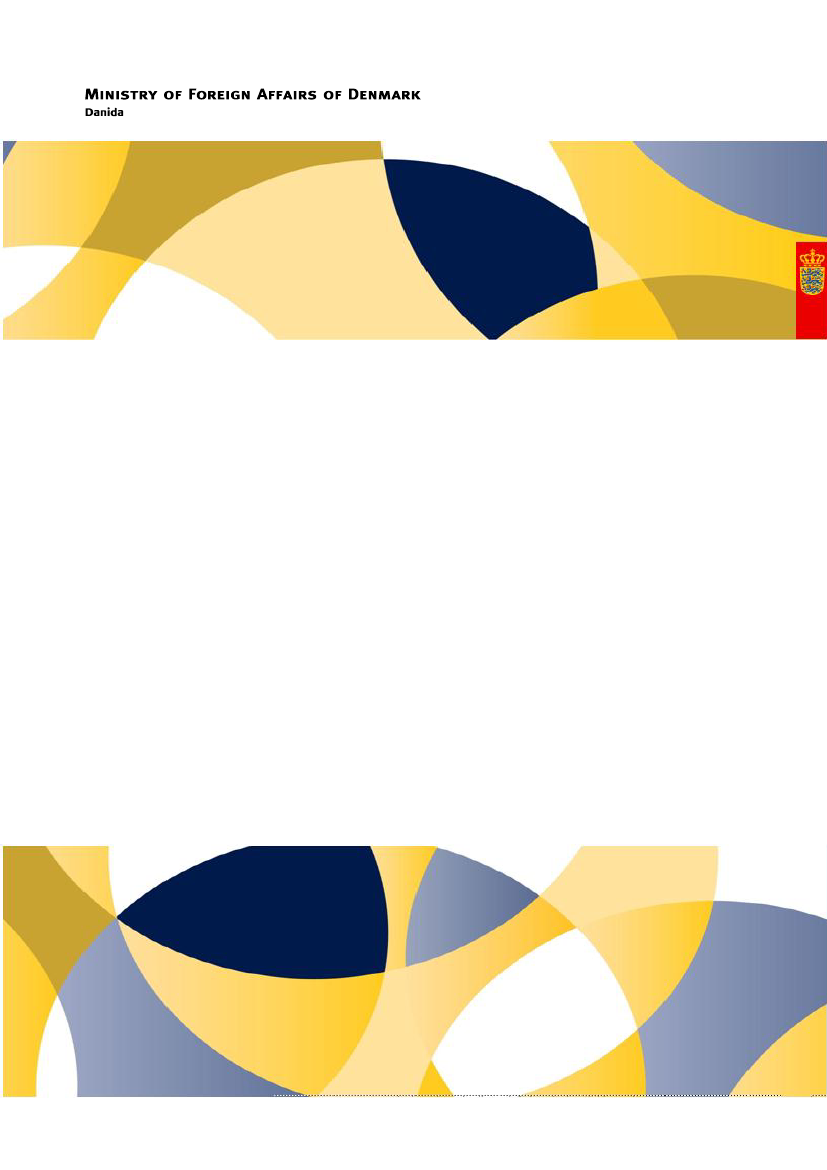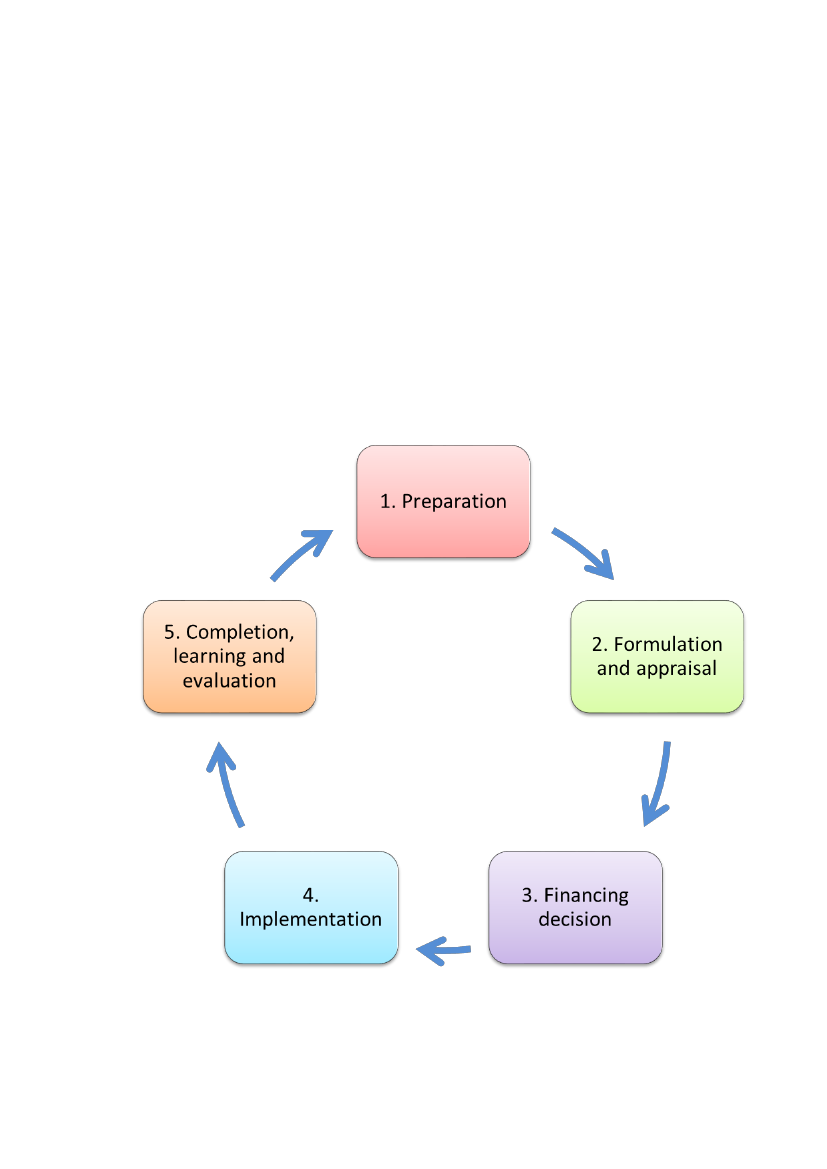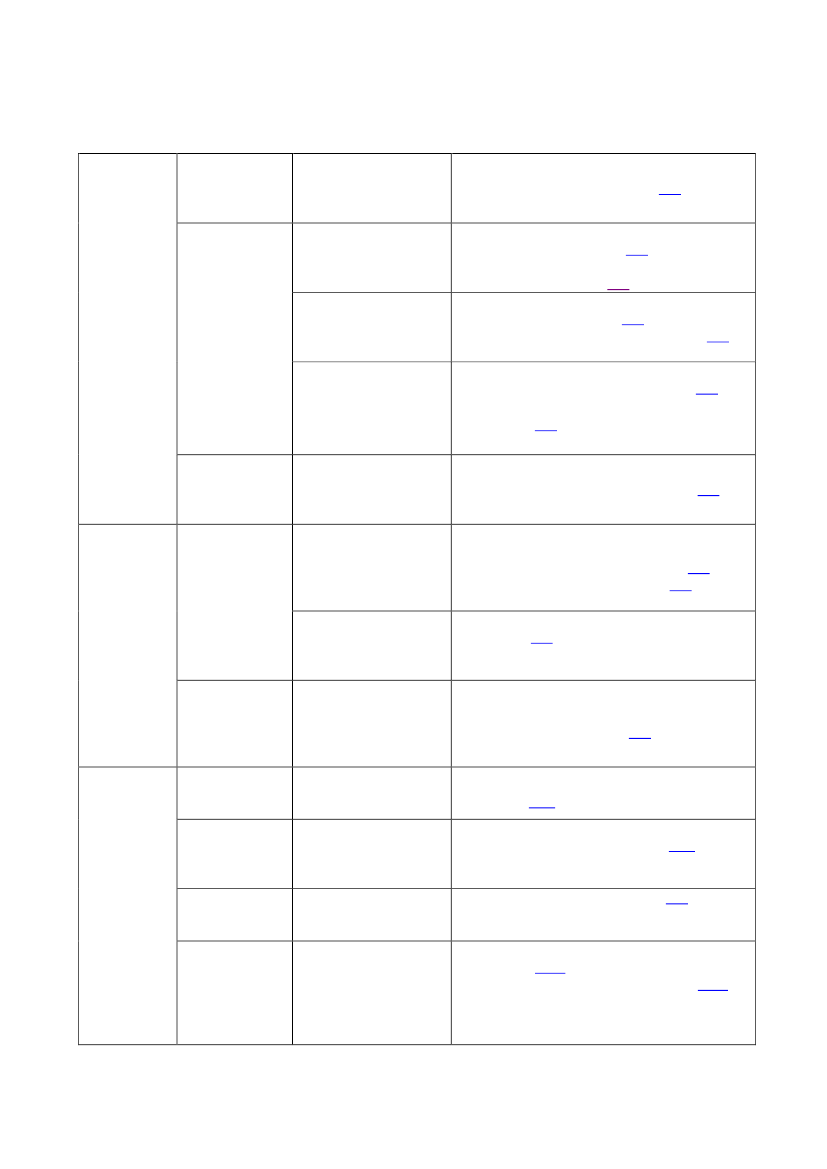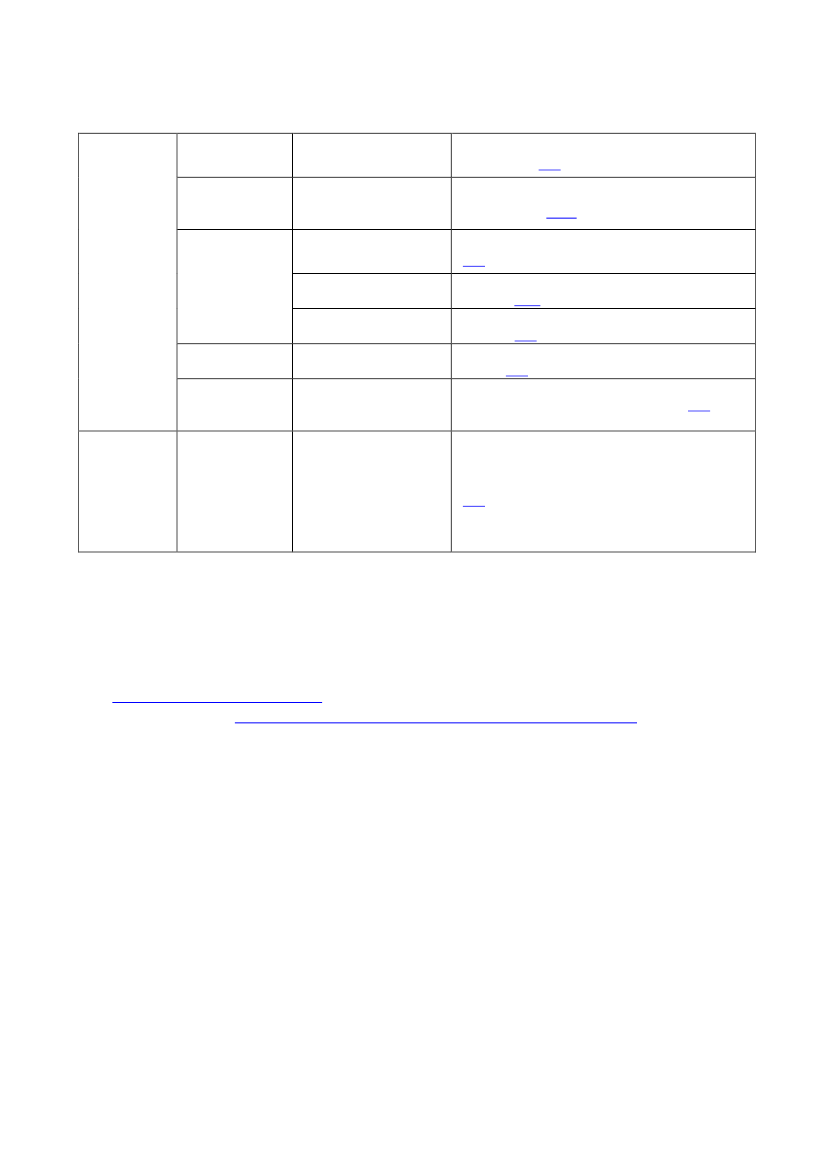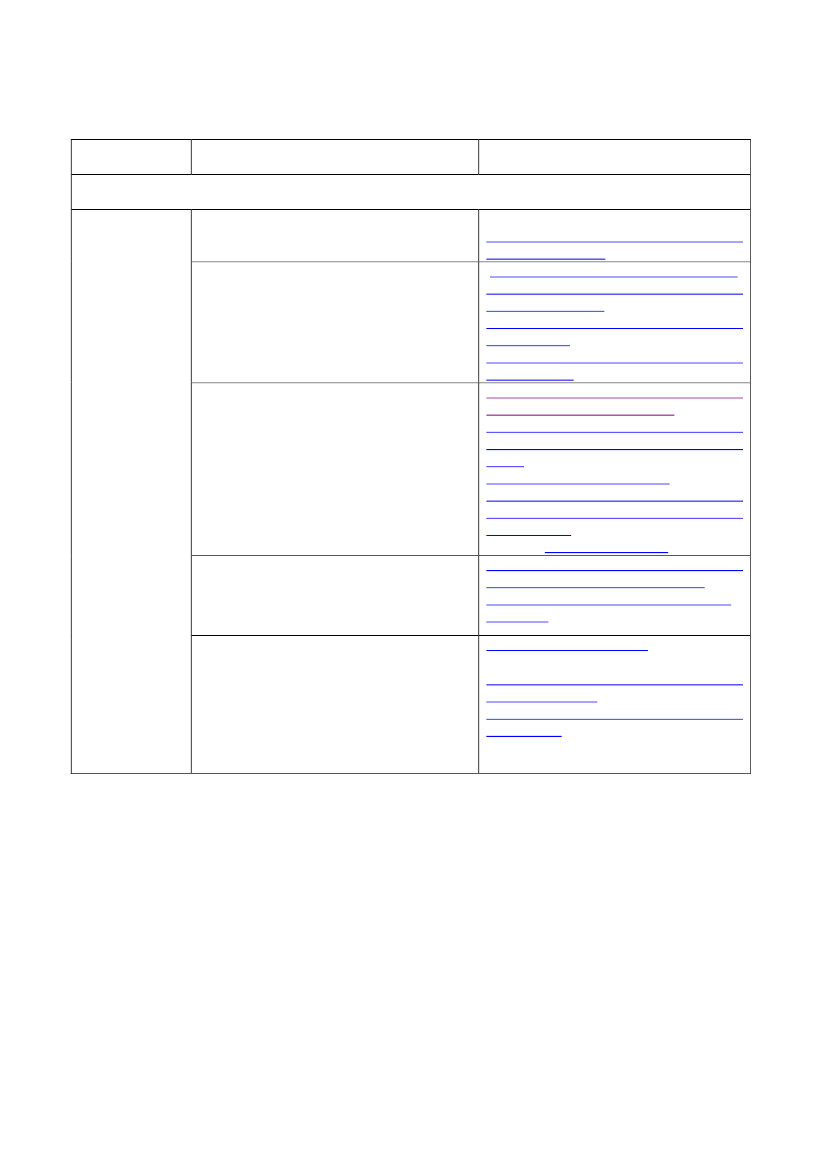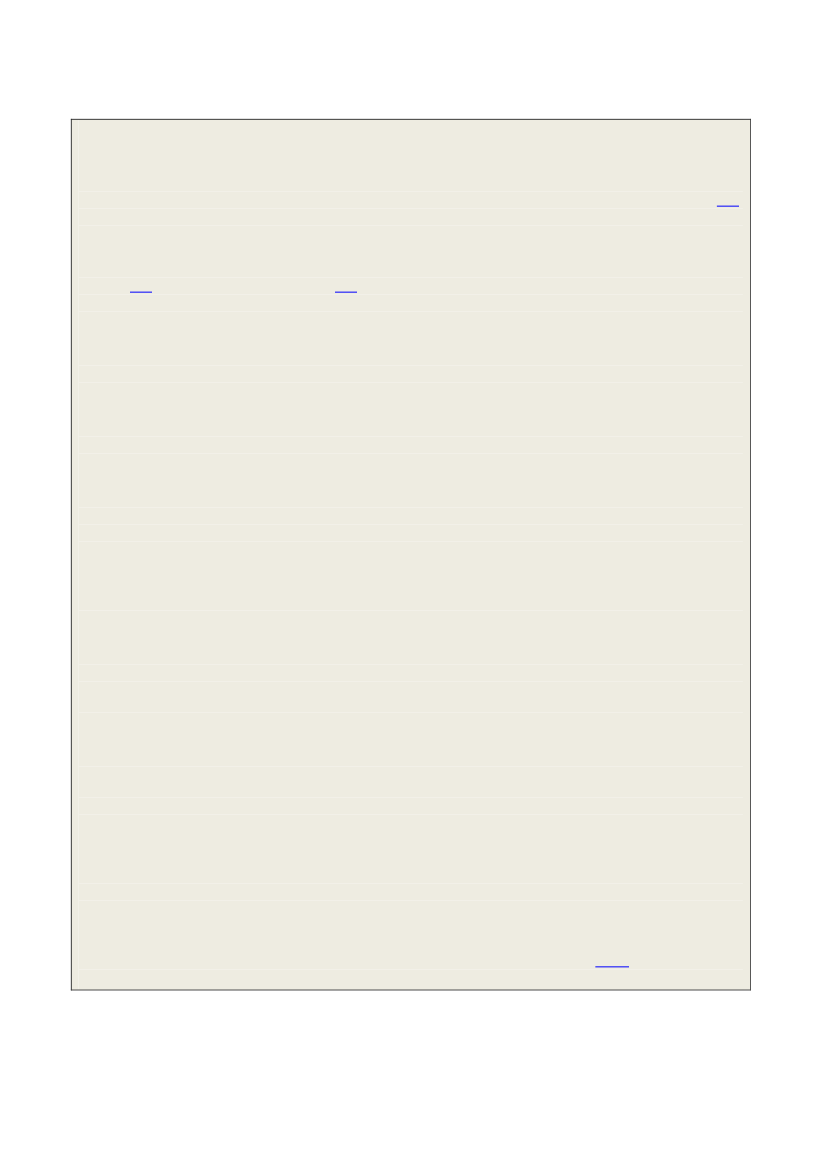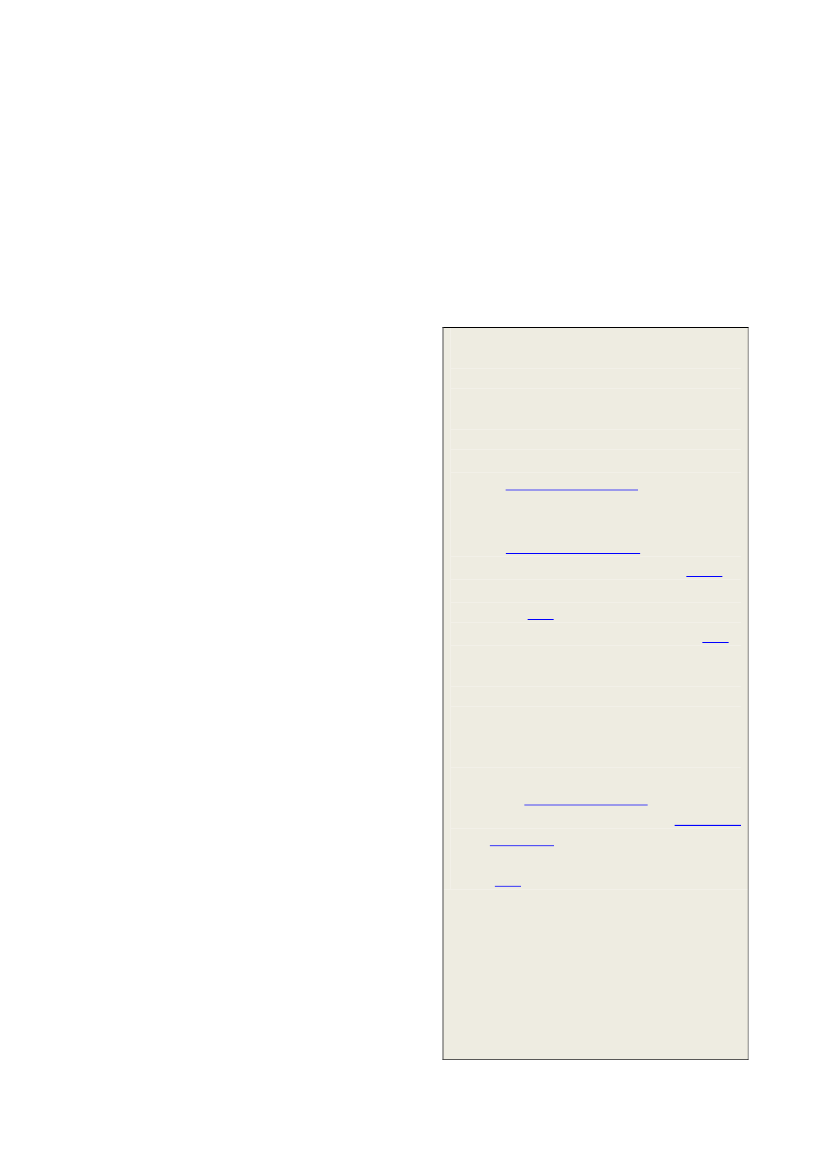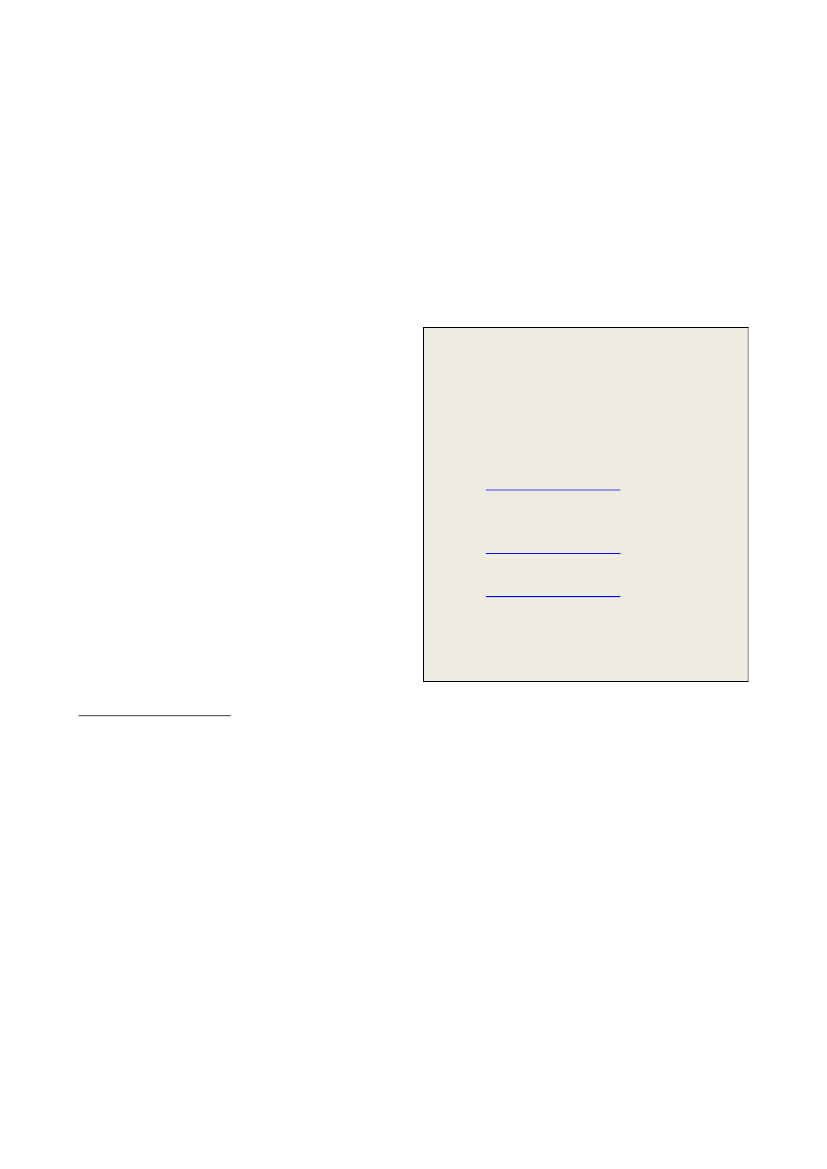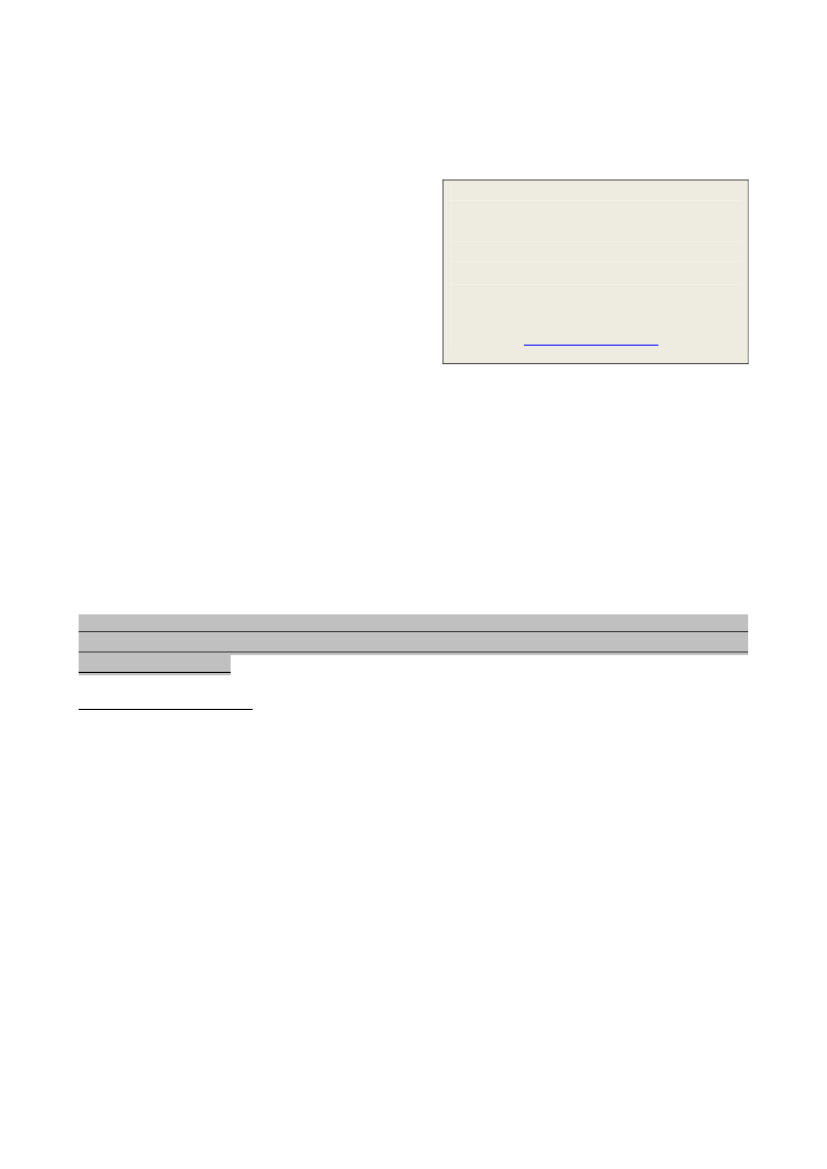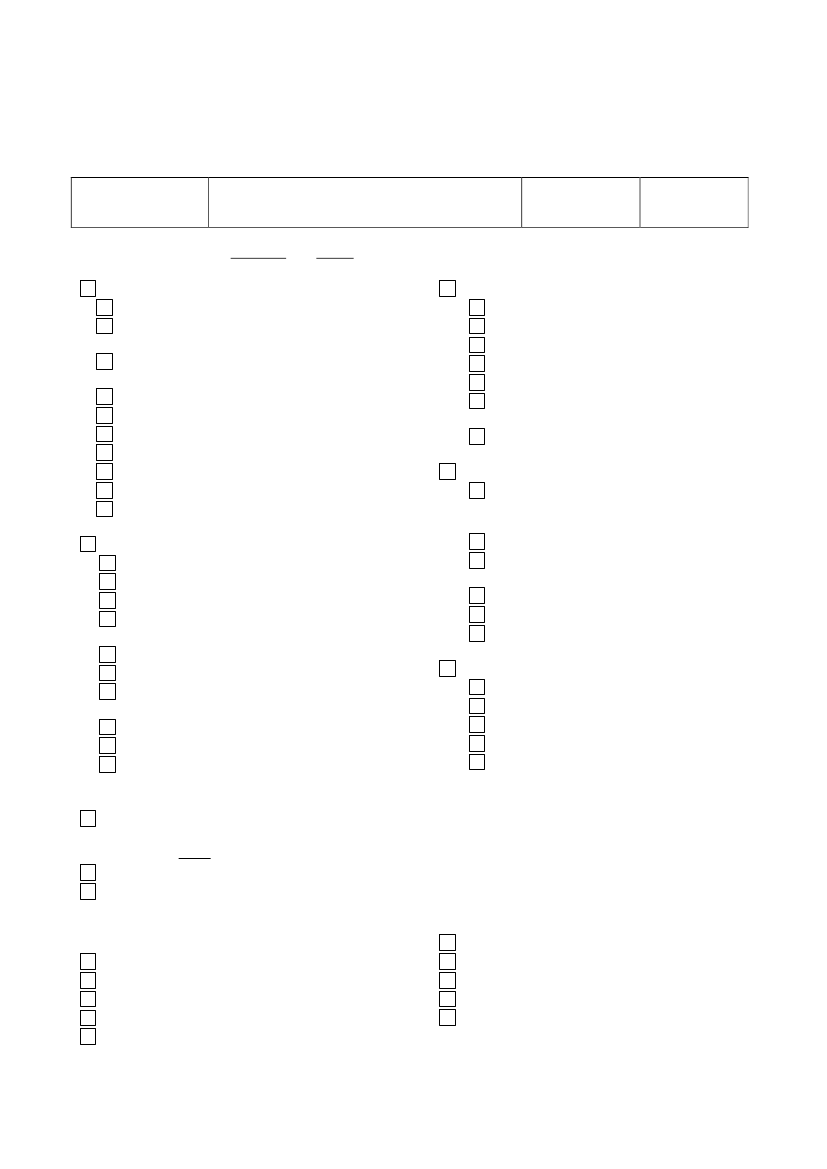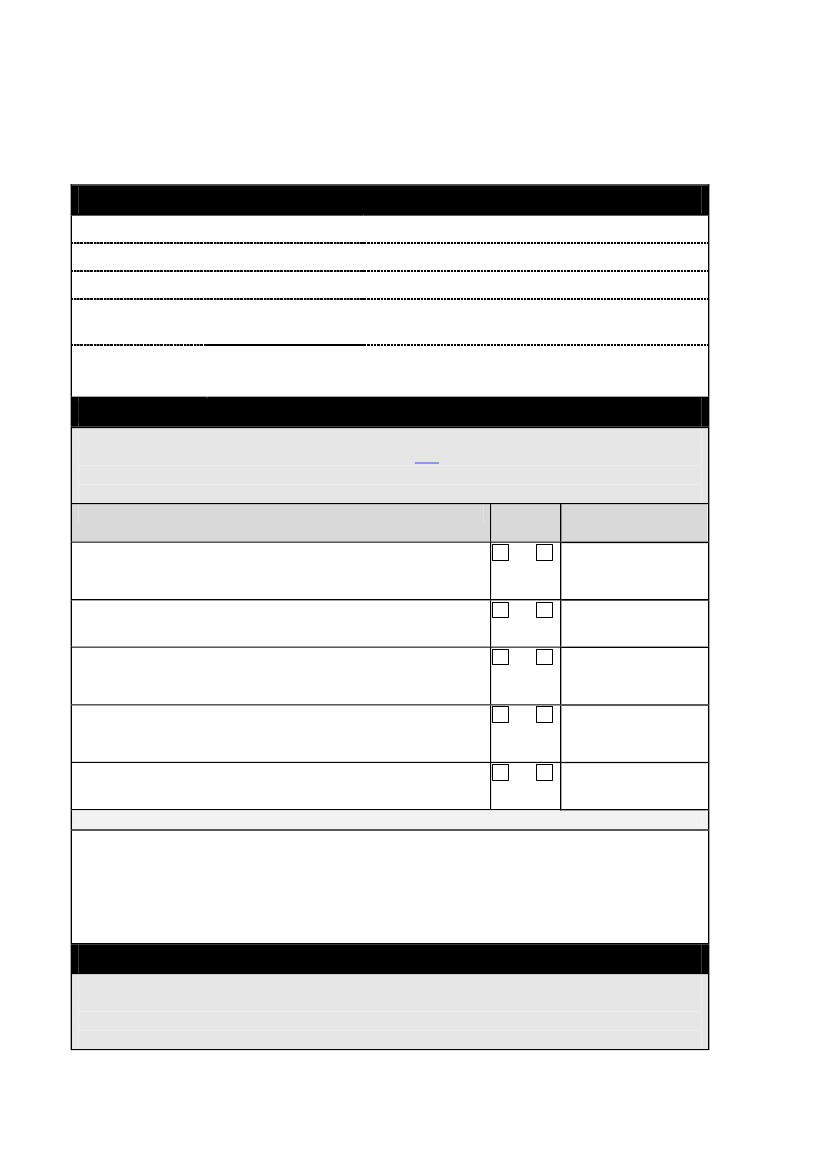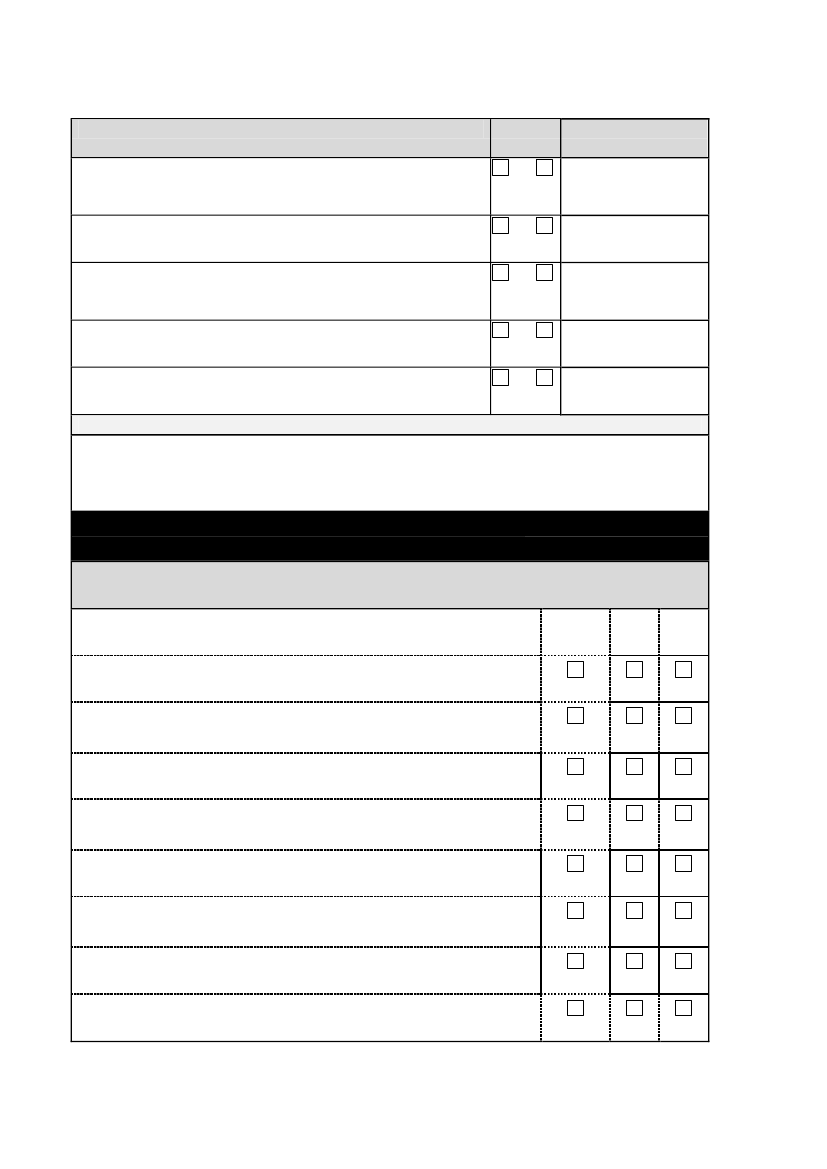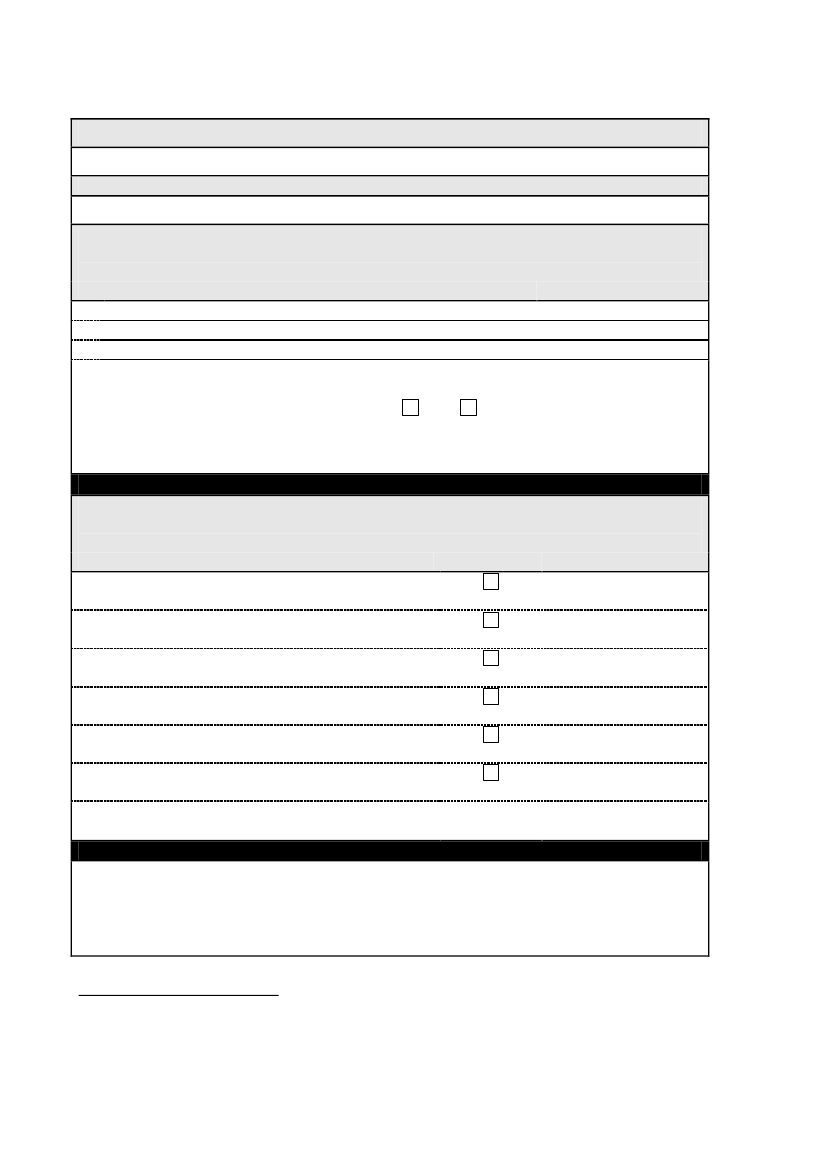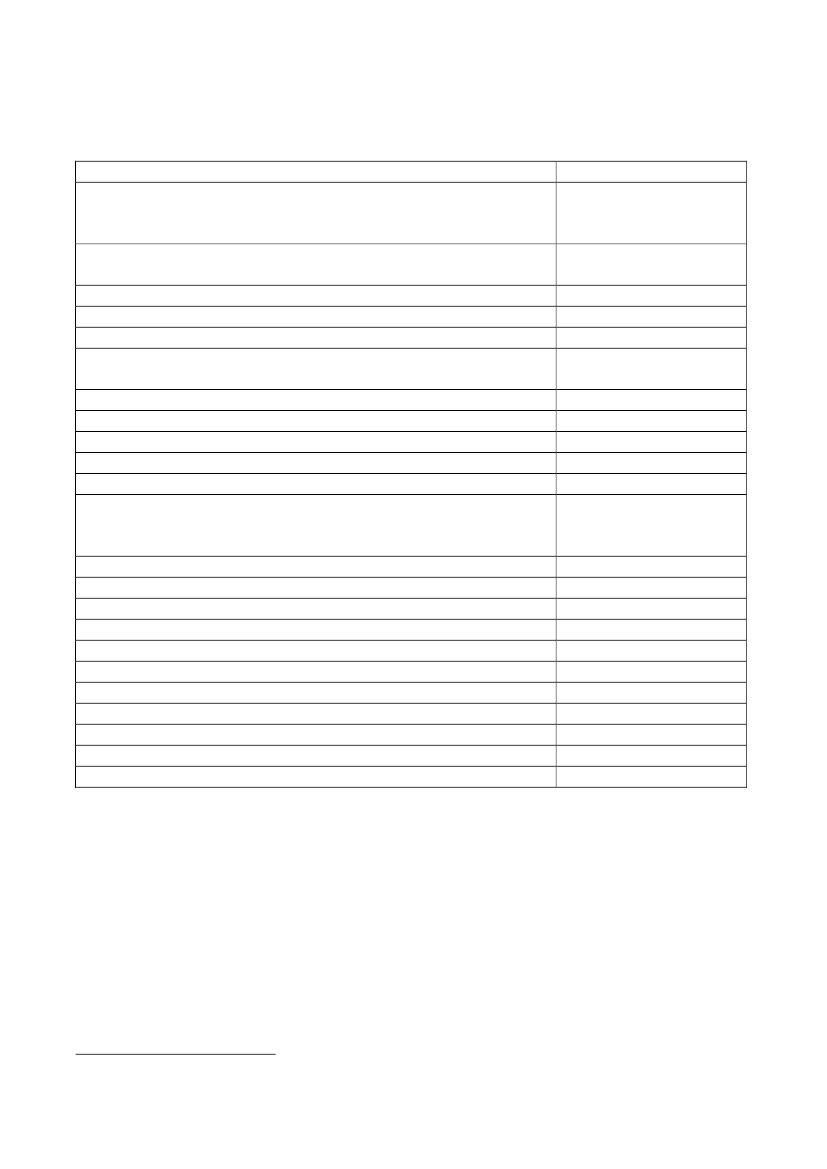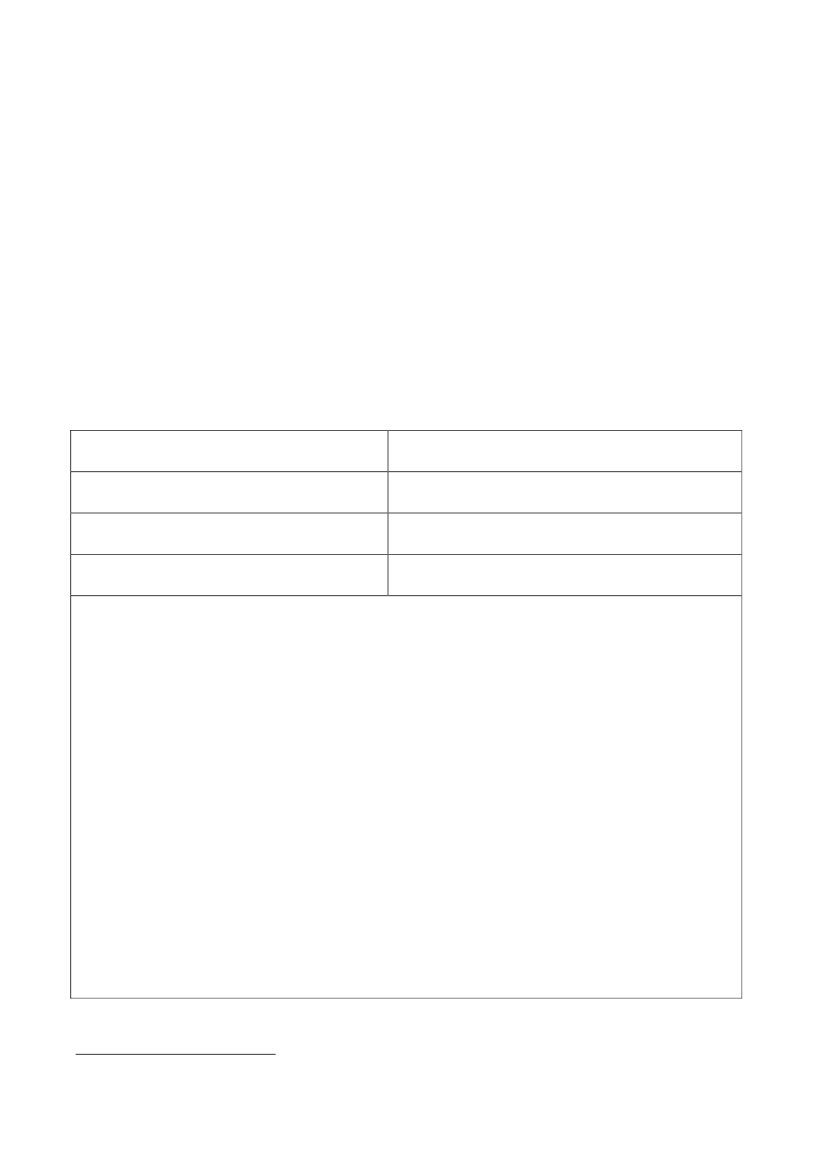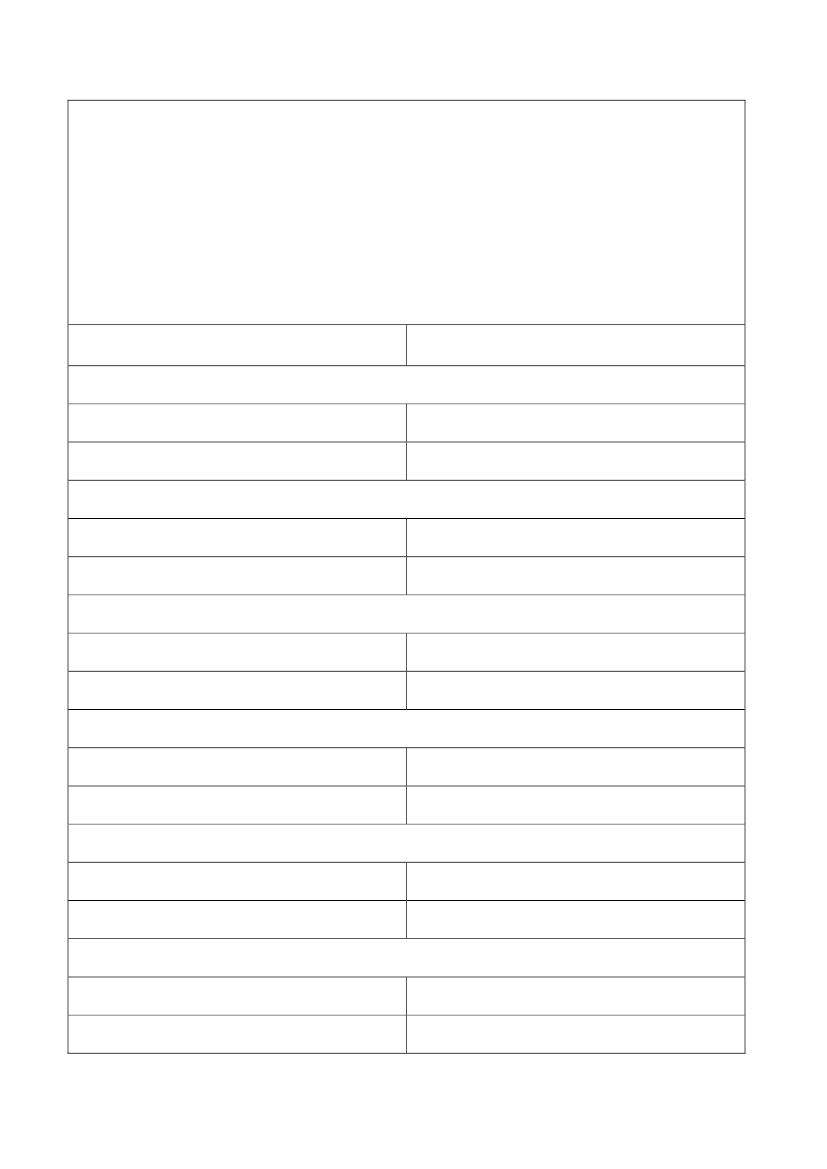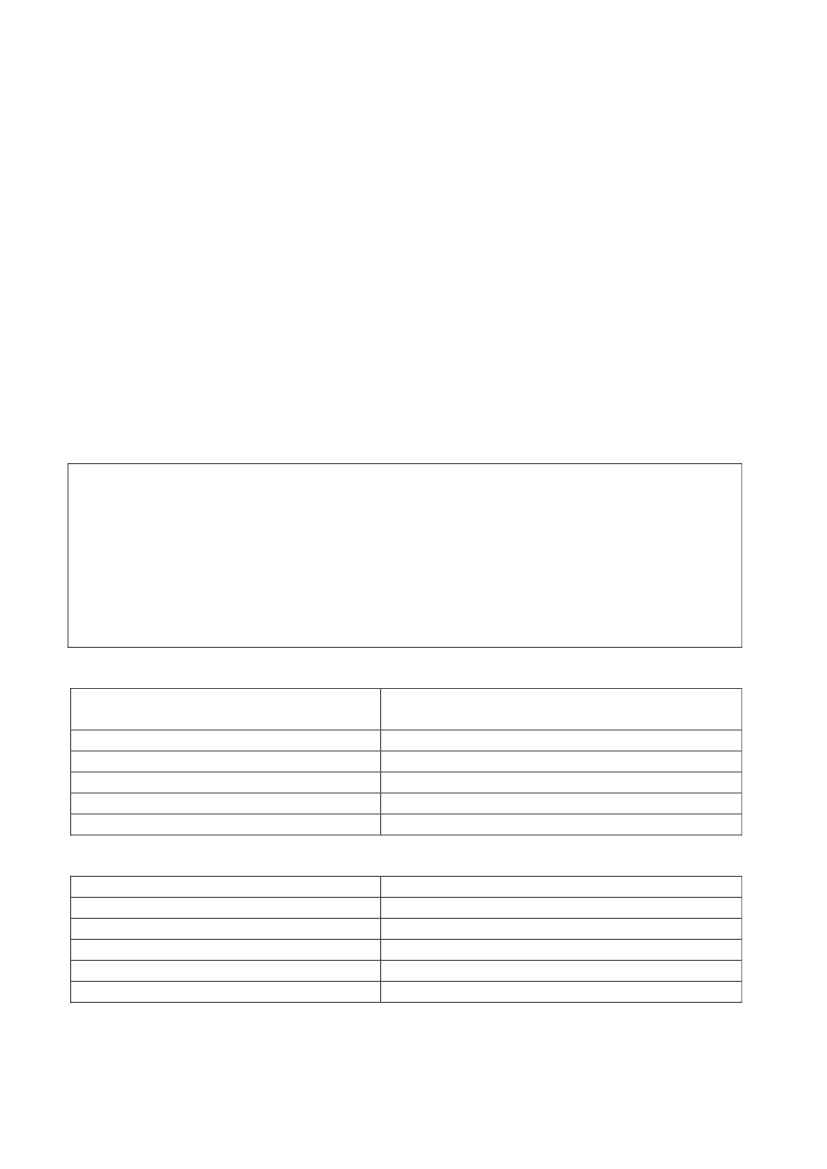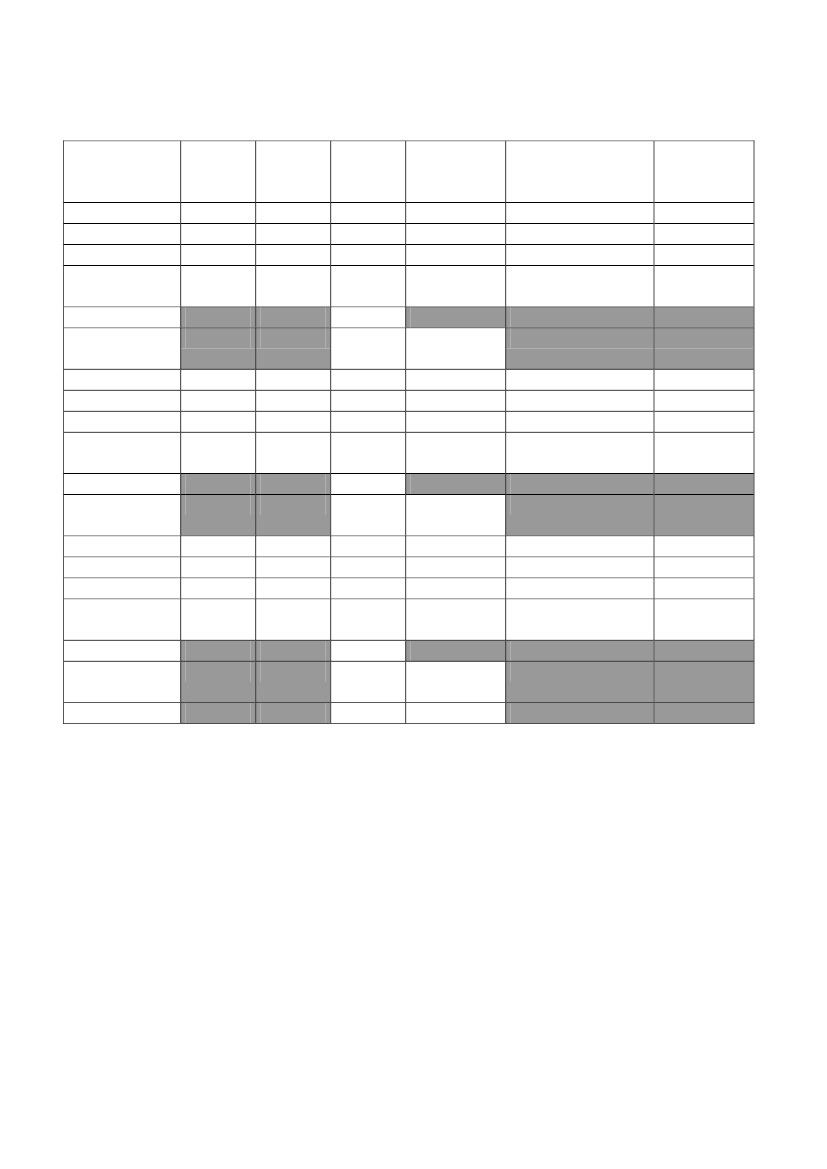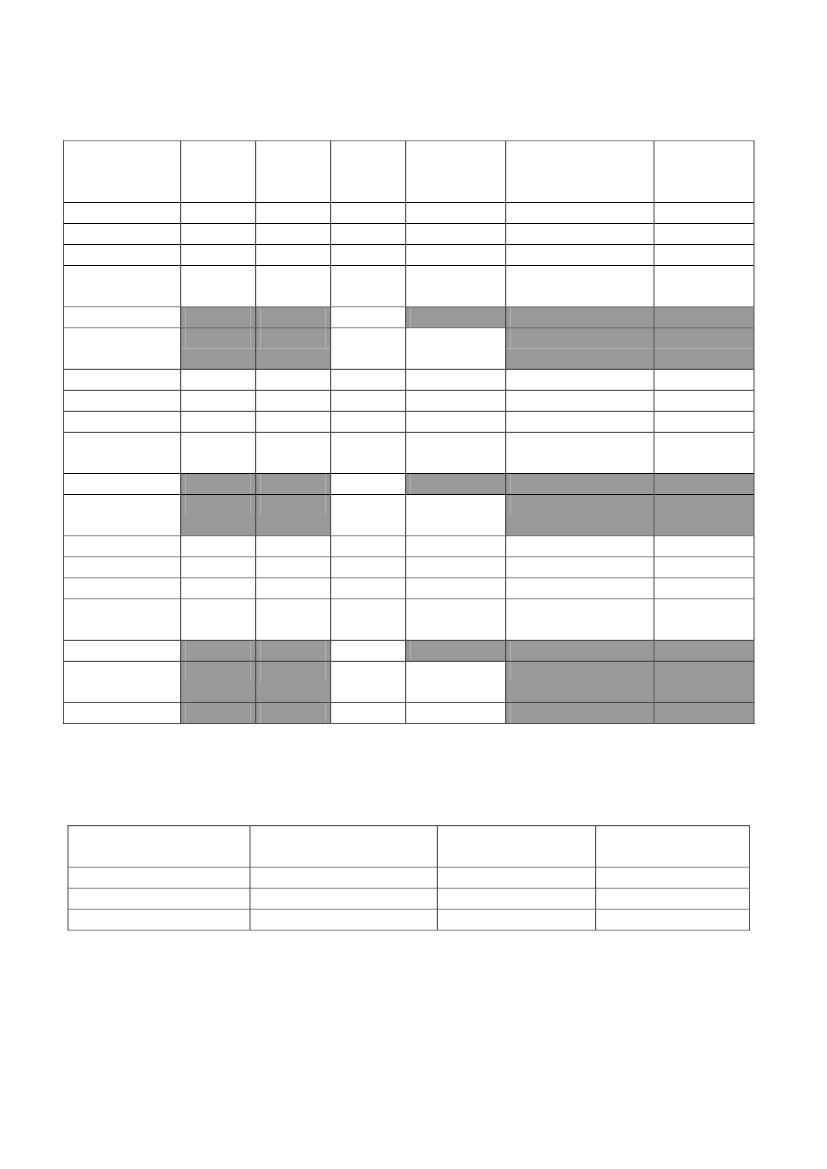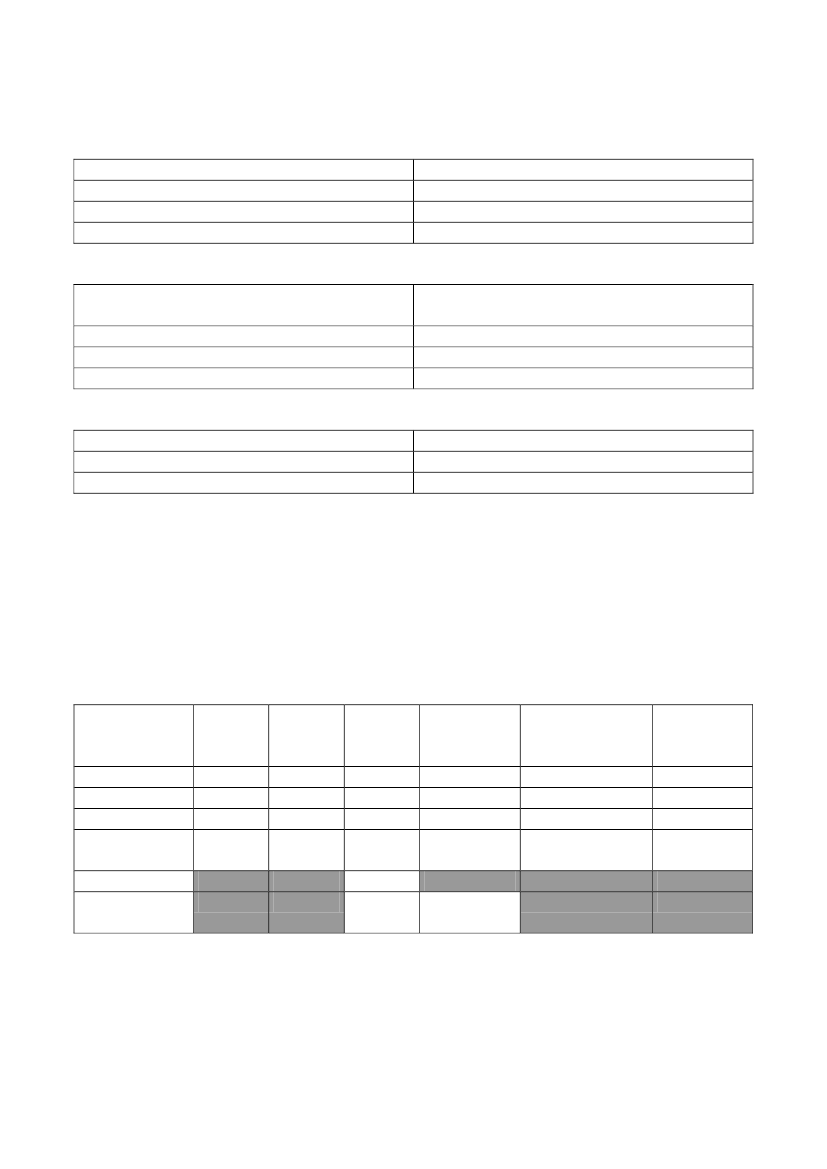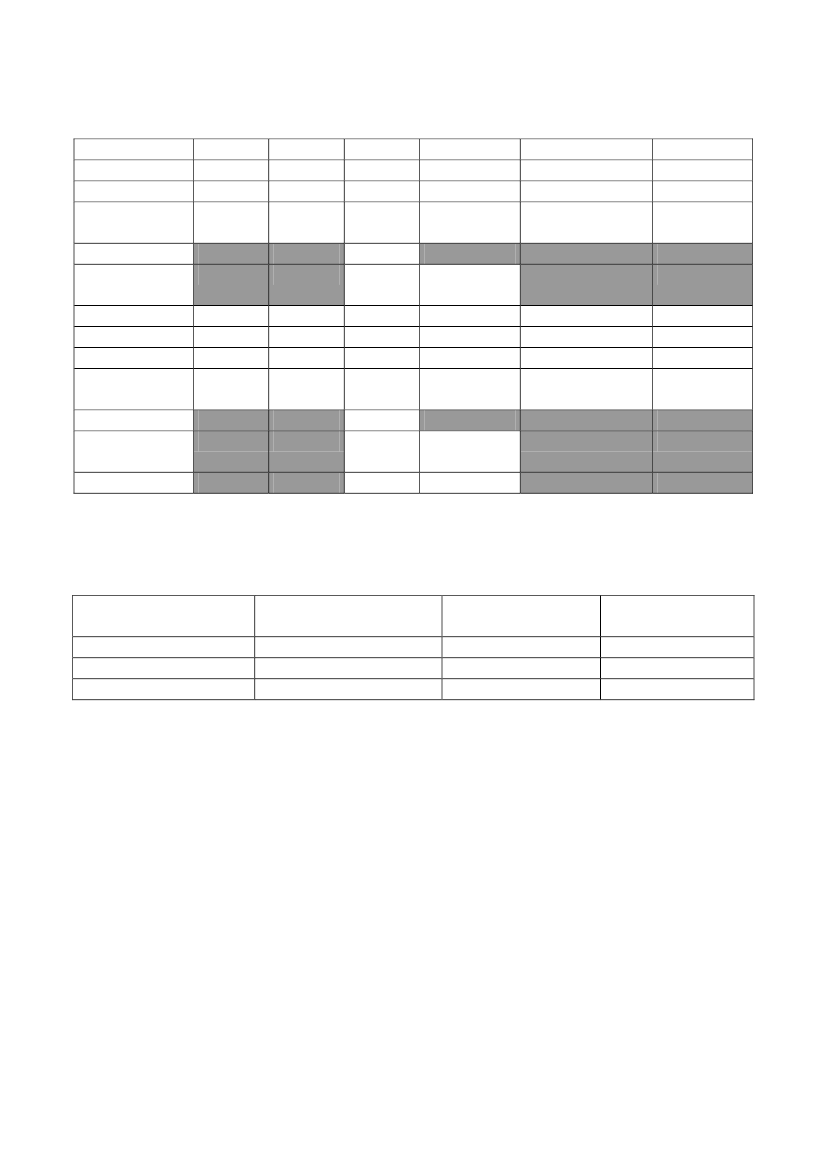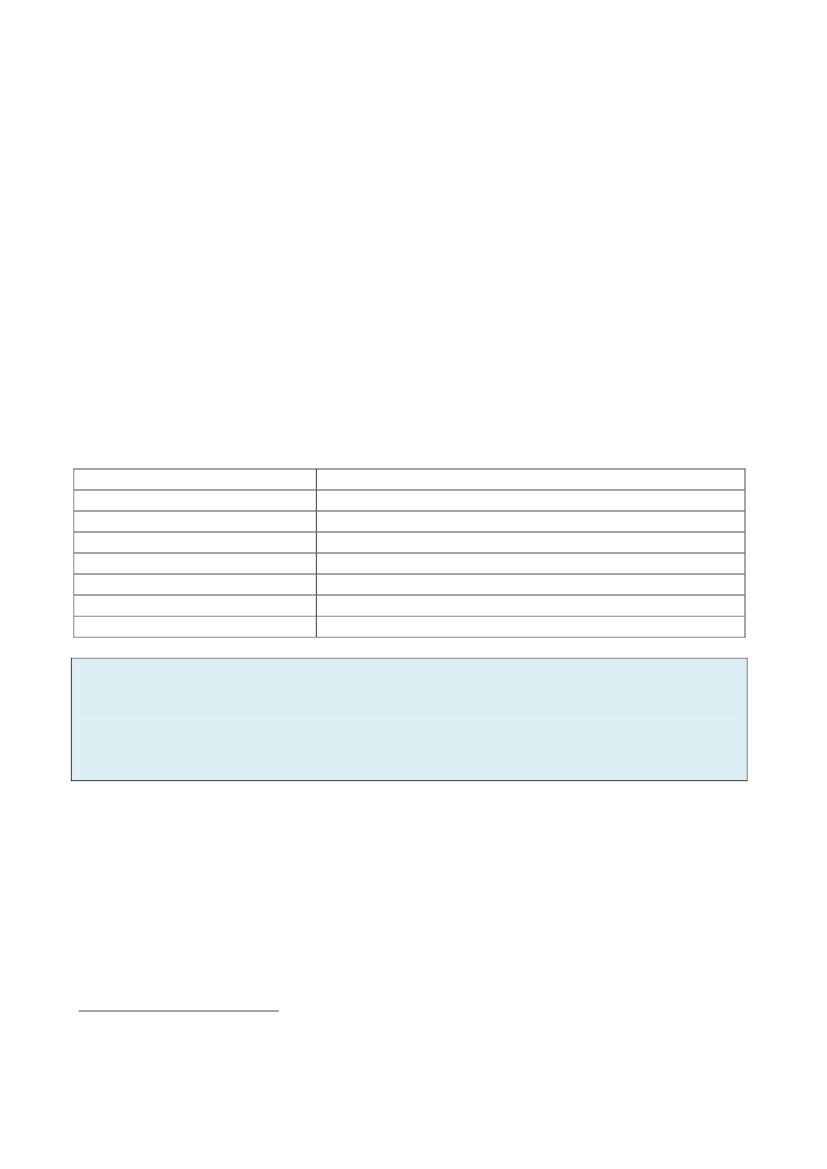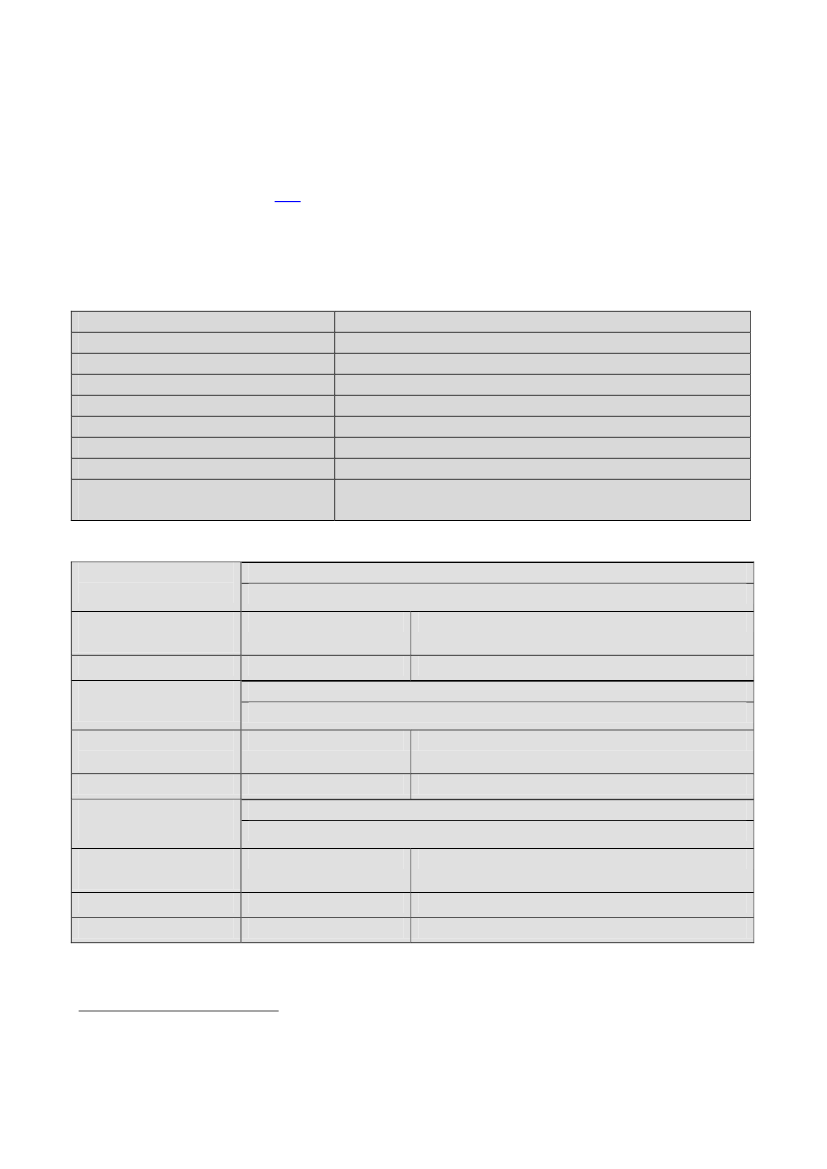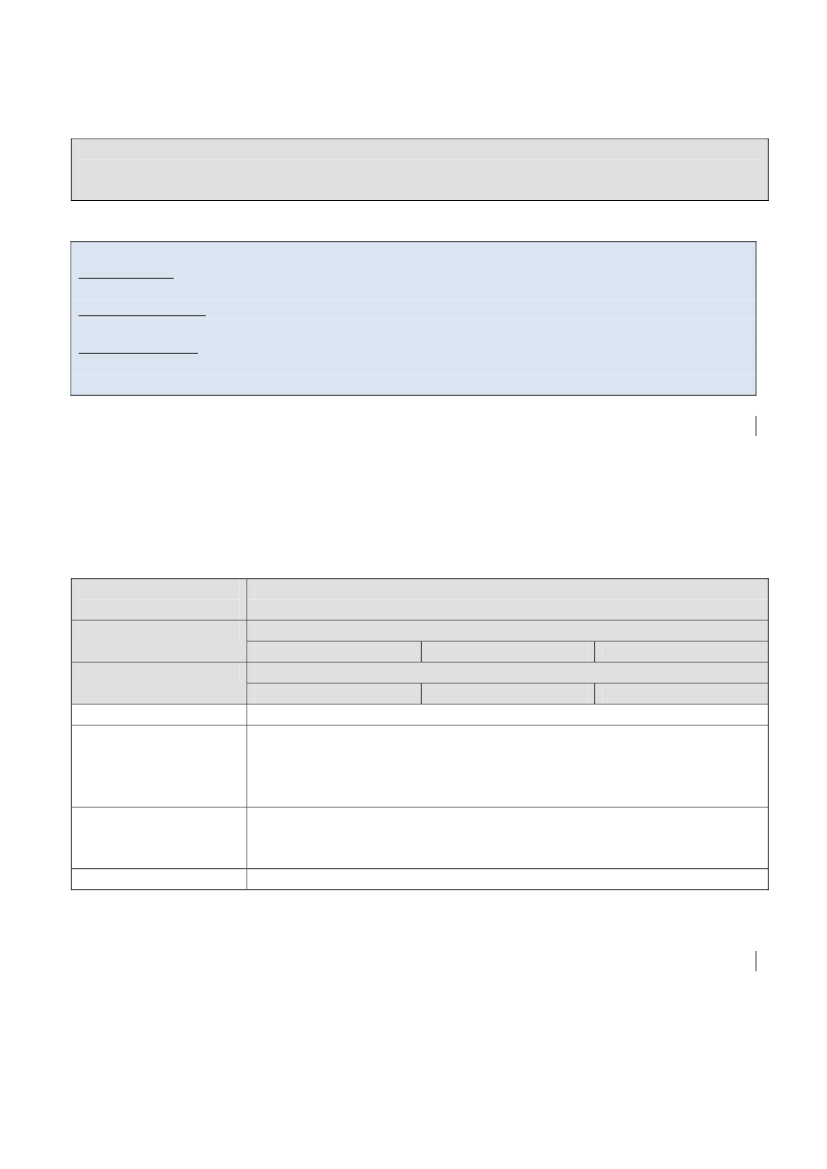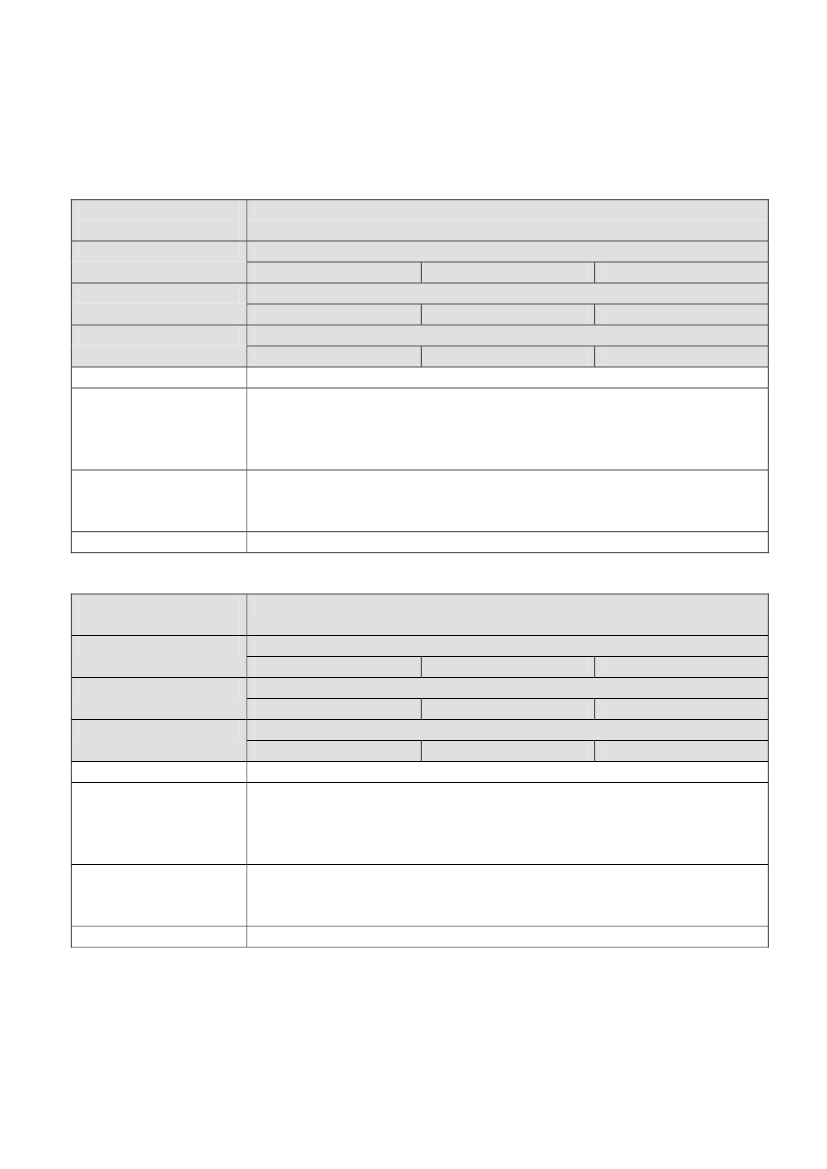Udenrigsudvalget 2013-14, Finansudvalget 2013-14, Klima-, Energi- og Bygningsudvalget 2013-14
URU Alm.del Bilag 42, FIU Alm.del Bilag 26, KEB Alm.del Bilag 74
Offentligt
GUIDELINES FORPROGRAMME MANAGEMENT
September 2011
1
Table of ContentsPART IAcronyms .................................................................................................................................................. 31. Introduction ......................................................................................................................................... 52.The Preparation Phase.................................................................................................................. 112.1 Step 1: Planning of programme support preparation, formulation and appraisal ............ 122.2 Step 2: Analysis of the sector or thematic area and its national context ........................... 132.3 Step 3: Deciding and developing the programme support proposal ................................. 142.4 The Concept Note .................................................................................................................... 203.The Formulation and Appraisal Phase..................................................................................... 223.1 Further definition of programme support ............................................................................. 233.2 Preparation of programme support documentation ............................................................ 243.3 The appraisal process ............................................................................................................... 274.Financing Decision........................................................................................................................ 324.1 Danida appropriation procedures ........................................................................................... 324.2 Danida Appropriation Committee (projects between 5 and 35 million DKK) ............... 334.3 Presentation to the Board of Danida (major programmes above 35 million DKK ........ 334.4 Ministers Approval ................................................................................................................... 334.5 Formal agreement with partners ............................................................................................. 345.The Implementation Phase......................................................................................................... 355.1 Inception period ........................................................................................................................ 355.2 Joint decision-making arrangement ........................................................................................ 365.3 Planning, budgeting and reporting ......................................................................................... 385.4 Progress monitoring ................................................................................................................. 395.5 Accounting ................................................................................................................................. 405.6 Auditing ...................................................................................................................................... 415.7 Review ........................................................................................................................................ 426.The Completion Phase.................................................................................................................. 466.1 Preparation of exit strategy ...................................................................................................... 466.2 Completion of programmes and projects .............................................................................. 476.3 Closure of accounts .................................................................................................................. 486.4 Implementing partner’s final report ....................................................................................... 496.5 Danida programme/project completion report (PCR)........................................................ 496.6 Evaluations ................................................................................................................................ 49PART II Annexes1. Checklist for programme registration ............................................................................................ 532. Template for Process Action Plan .................................................................................................. 553. Template for Gender Equality Rolling Plan .................................................................................. 564. Climate change and environment screening note ......................................................................... 585. Contents of Assessment according to the ten budget support principles ................................ 616. Contents of Concept Note ............................................................................................................... 647. Contents of Programme Support Document and Component Description ............................ 668. Template for summary of recommendations of the appraisal report ........................................ 739. Template for terms of reference for Steering Committee ........................................................... 7610. Template for Annual and Semi-Annual Progress Report .......................................................... 7811. Template for Assessment of Programme Support ..................................................................... 8412. Templates for Programme Completion Report (PCR) .............................................................. 892
AcronymsBSCRSDACDKKEUGPMIASINTOSAIIPSASJFAKVAMDGsMFAMoUNGOPAPPCRPDBPEFAPFMPIUPPOPRSPSBSTASToRUMFVPABudget SupportCredit Reporting SystemDevelopment Assistance CommitteeDanish KronerEuropean UnionGuidelines for Programme ManagementInternational Accounting StandardsInternational Organisation of Supreme Audit InstitutionsInternational Public Sector Accounting StandardsJoint Financing AgreementDepartment for Quality AssuranceMillennium Development GoalsMinistry of Foreign AffairsMemorandum of UnderstandingNon-Governmental OrganisationProcess Action PlanProject and Programme Support Completion ReportProgramme and Project DatabasePublic Expenditure and Financial AccountabilityPublic Financial ManagementProgramme Implementation UnitProject and Programme OrientationPoverty Reduction Strategy PaperSector Budget SupportTechnical Advisory ServiceTerms of ReferenceMinistry of Foreign Affairs’ Accounting systemMinistry of Foreign Affairs’ Annual Business Plan
3
GUIDELINES FOR PROGRAMMEMANAGEMENTPART I
4
1. IntroductionThe purpose of the Guidelines for Programme Management (GPM) is to provide tools and aframework of reference for the preparation, implementation and monitoring of Danish bilateraldevelopment assistance, including sector and thematic programme support, the SpecialEnvironmental Assistance, the Region of Origin Programme, The Danish Stabilisation Fund,the Neighbourhood Programme and projects receiving Danish support of DKK 5 million ormore. General budget support is covered by specific Guidelines for the provision of budgetsupport but is based on the same general principles as the GPM. Multilateral support, DanidaBusiness Partnerships and Danida Business Finance are covered by separate guidelines.The GPM primarily target the Representations and other MFA units responsible for Danishbilateral development assistance. As such, this guidance will also be relevant for other partnersand for consultants involved in programme preparation and implementation. The GPM havethree functions:Provide flexible guidance and a framework of reference for Danish Representationsparticipating in joint programming processes and in dialogue with partners and co-donors regarding national programmes.Lay down the requirements relating to internal approval and administrative proceduresof Danish development cooperation. Mandatory requirements are highlighted with greyshading.Provide templates and recommend contents for key documents in cases where partnerformats and/or joint-donor formats are not appropriate.The following terminology is used in these guidelines:Partner planning framework: An undertaking with specified objectives, strategy, budget, implementationmechanisms, etc. It could be sector-wide, involving several institutions, or becarried out at the level of a single organisation (public or non-public), or a jointsupport framework such as a civil society or private sector support facility.Programme support:(Danish) support for the national partner’s programme, whether it be sectorbudget support, a sector programme or a thematic programme. A programme isusually a collection of components, projects and other related initiatives that aremanaged together for a longer time period in order to achieve specific results,broader user effects or impacts in society. Danish programme support is usually3-5 years in duration and normally above 35 million DKK.A more limited type of endeavour often with a single partner, with fairly specificobjectives/outputs, a defined timeframe and budget. In Danida the duration ofprojects are normally limited to three years and a budget below 35 million DKK.A national policy area benefiting from support. In this document it could alsocover a sub-sector or a thematic area. It is often, but not necessarily, clearlydelimited in terms of national institutions involved and expense items on thenational budget.Embassy, representation or other MFA unit responsible for programme supportpreparation and implementation.
Project support:
Sector:
Representation:
5
(Danish) Aid instrument:
The financing source related to a distinct budget line in the Danish Finance Act.In general the principles, terminology and overall programme cycle described inthis document apply to all Danish bilateral aid instruments. Some aid instrumentsare subject to specific regulations due to accountability obligations. Examplesinclude “Humanitarian Assistance”, “Regions of origin programme”, “Partnershipfor dialogue and reform” and “The Stabilisation Fund” and others.Is the specific mechanism for transferring fund or channel resources to partnercountries. General examples as applied in the OECD/DAC typology includegeneral budget support, sector budget support, project support, technicalassistance and debt relief etc.
Aid modality or type of aid:
The GPM is the overarching guidelines and methodological framework for Danida programmeand project implementation. Assistance to specific thematic areas may have specific guidelines.The GPM are regularly updated but may not always reflect the latest versions of the technicalnotes and issue-specific guidelines that complement it. Users should therefore consult thespecific guidelines also.The GPM build on a number of general principles:
In line with the commitments of the Paris Declaration and the Accra Agenda forAction, the GPM are designed with the aim for Danish assistance to strengthen thecapacity of country and partner systems and align with the systems to the maximumextent possible in the implementation of the development assistance.
The maximum alignment principle means that sector budget support (SBS) or core-funding is the default and preferred modality for support to public sector partners andin case of support to private non-profit organizations (e.g. CSOs, NGOs, private sectorassociations, unions) core funding is the preferred modality: Where full SBS or corefunding of organizations is not possible the level of earmarking should be minimized asmuch as feasible. SBS and core funding are not relevant for support targeted at marketbased for-profit operators (e.g. financial service providers).Thorough and systematic assessment of the country and sector context to determinewhat represents the maximum feasible level of alignment and a clear justificationprovided for the proposed level of use of country systems.Clear and time-bound outline of the path towards further alignment towards SBS orcore-funding in cases where full alignment is not possible from the outset.
Support to partners’ programmes or planning frameworks preferably as a whole, oralternatively in part. The GPM outline how to assess the partner programme or planningframework, systems and capacity to determine the adequacy of the planning frameworksfor full alignment. The key criteria concern i) the quality and feasibility of theprogramme or planning framework supported in its national context, ii) consistency ofthe programme or planning framework with the overall poverty reduction objective andstrategic focus of the specific Danish programme support, and iii) implementation6
capacity of partner(s), including management and administrative systems, capacity,efficiency and quality of governance.
Active lead by the partners in the process of preparing the programme or planningframework using the partners’ own resources and systems (donors may contribute inclose consultation with the partner.). Implementation is always the sole responsibility ofthe partner, with donors lending support as requested
To supplement the GPM on the planning, management and funding decisions in Danishdevelopment assistance other relevant Danida strategies and policy papers describe the policy-level and technical considerations to make. Seewww.amg.um.dk.The “Technical Note onProgramme Support Preparation” complements the GPM with guidance on certain issues andmethods that can only be briefly addressed here.The GPM are divided into two main parts: Part I accounts for the process throughout theprogramme support cycle, and is organised in five chapters: Preparation phase, formulation andappraisal phase, financing decision, implementation phase and completion phase. Part IIcontains recommended contents and templates to be used in programme management.Responsibility for programme support processWithin the Ministry of Foreign Affairs, responsibility for undertaking each step in theprogramme cycle is assigned to different entities depending on the size of the appropriationand on the country of cooperation.Preparation and administrationof bilateral development assistance has been decentralised to theRepresentations in partner countries. In partner countries, the Representations are responsiblefor all steps of the programme cycle, except for the decision to move from the preparationphase to the formulation and appraisal phase (which pertains to Danida’s ProgrammeCommittee), most appraisals (TAS), the appropriation (Minister, Danida’s Board or DanidaAppropriation Committee), and some reviews (TAS). For bilateral assistance to other nonpartner countries, the relevant unit in MFA is responsible.In connection with the drawing-up of an Annual Business Plan (‘MRS’ from its acronym inDanish), the Representation may request advisory TAS participation in parts of the preparationprocess.Responsibility forappraisals and reviewsdepends on the size of the appropriation and the countryof cooperation. TAS is responsible for appraising and reviewing appropriations of more thanDKK 35 million1. In partner countries where the administration of development assistance hasnot been decentralised, TAS is in charge of appraising appropriations of more than DKK 20million. Below these limits, the Representation (or the responsible MFA unit) should ensurethat appraisals and reviews are undertaken by external consultants.
However, in nationally-led sector reviews, the Representation is responsible for coordinating Danish participation, whileTAS provides advice to the Representation.1
7
The programme support cyclePhaseTimingProcessLinks to document guidelines and templatesMin. 18 monthsbefore Ministers Planning of programmeGPM Part II: Template for PAP [link]*approvalsupport preparationAddressing Capacity Development in DanishDevelopment Cooperation [link]Sector analysesGuide to Political Economy and StakeholderAnalysis at Sector Level [link]GPM Part II: Assessment according to the tenAnalysis of budget budget support principles[link]* and Technicalsupport principlesnote on programme support preparation [link]Guidance note on Danish support for capacitydevelopment and Technical Assistance [link]support and Technical note on programme supportpreparation [link]
Preparation
Programmedesign
Min. 12 monthsConcept note andbefore MinistersMFAProgramme GPM Part II: Contents of concept note[link]approvalCommittee
Formulation and Appraisal
Guidance note on Danish support for capacitydevelopment Addressing Capacity DevelopmentFurther definition ofin Danish Development Cooperation [link]programme supportGuidelines for technical assistance [link]ProgrammedocumentationGPM Part II: Contents of Programme Supportsupport Document [link]
Finalised min. 6months beforeMinistersAppraisal processapproval.
GPM Part II: Template for Summary ofappraisal recommendations [link]
Project approval byGuidelinesforDanidaAppropriationDanida AppropriationCommittee[link]CommitteeProgrammepresentation for Danida Guidelines for Board presentation [link]Board
Financing decision
Programme approval byMinister
Guidelines for Ministers approval [link]
Guidelines for Government ProgrammeAgreement[link]and Nordic Plus PracticalFormal agreement with Guide to Joint Financing Arrangements[link]partners
8
Phase
Timing
ProcessLinks to document guidelines and templatesJoint decision-making GPM. Part II: Contents of ToR for SteeringarrangementCommittees [link]
*)Documents that are not mandatory for appropriations below DKK 35 million.
Independent evaluations constitute a key mechanism for learning on what works and whatdoesn´t work in different contexts and under different conditions as well as for documentationof results. They may be conducted at various stages of the programme cycle, e.g. towards theend of a phase of a programme or after completion of a programme.TheGender Equality Rolling Planmust be annexed to the concept note, appraisal report andreview aide memoire.The Climate Change and Environmental Screening Note(see also p. 59)is a mandatory annex to the concept note and the appraisal report. Stage gates in theprogramme cycle are approval of concept note in the Programme Committee, presentation ofthe appropriation note to the Danida Board and the Minister’s final approval.
Completion
Max. 6 monthsProgrammesupport Nordic Plus Practical Guide to Joint Financingafter agreementinceptionArrangements[link]with partnerPlanning,budgeting, GPM Part II: Template for Progress reportreporting[link]Accountingand General Guidelines for Accounting andauditingAuditing[link]GPM Part II: Assessment of ProgrammeReviewSupport [link]Climate Change and Environmental ScreeningExit strategyNote - [link] (see also annex p. 59)Anytime in theprogrammeEvaluationSee separate Guidelines for evaluation[link]cycleMin. 3 monthsbeforeCompletionGPM Part II: Template for Completion ReportCompletion report[link]
Implementation
9
Overview of political priority areasTo be considered in programme support Links to useful toolspreparation and managementStrategy for Denmark’s Development Cooperation, Freedom from Poverty – Freedom to Change, 2010PoliticalpriorityareaGrowth and employmentFreedom, democracyand human rightsWhere relevantAlwaysStrategic Framework for Growth andEmployment (2011)Democratisation and human rights (2009)Effective and Accountable Public SectorManagement (2007)Strategy for Danish Support to CivilSociety (2008)Strategy for Danish support to IndigenousPeoples (2004)Strategy for Gender Equality in DanishDevelopment Assistance (2004)Strategy for Denmark’s support to theinternational fight against HIV/AIDS(2005)Danida Gender toolbox (2008)The promotion of sexual and reproductivehealth and rights - Strategy for Denmark’sSupport (2006)Annex 3 (Genderequality plan)Peace and Stability, Denmark’s Policy forInterventions in Fragile States (2010)Strategy for Danish Humanitarian Action2010-2015Environment Guide (2009)Environmental Strategy (2011) (in prep).Danish Climate and Development ActionProgramme (2005)Guidelines for occupational health andsafety (2004)Annex4(ClimateChangeandEnvironmental Screening note)
Gender equality
Always
Stability and fragility
Where relevant
Environment and climate
Always
10
2. The Preparation PhasePurpose, timing and responsibilityThe preparation phase spans from the start of the planning of a new (phase of) programmesupport until presentation of the concept note to the MFA Programme Committee, whichshould take place no later than 12 months prior to the Minister’s approval.The purpose of the preparation phase is to establish the necessary foundation for taking andjustifying the overall strategic decisions on the design of the envisaged programme support.The emphasis in this phase is on the analysis of the support area and overall design questions.The need to undertake new studies depends on the degree of previous knowledge and existingdocumentation.By the end of the preparation phase, thefollowing aspects of the programmesupport will have been identified:Objectives supported, nationalpartners and partner planningframeworks, and intended finalbeneficiariesEnvisaged results, targets and waysof measuring and monitoring atprogramme levelJustification, approach and overalldesign of the support programme.Preliminary assessment of risksIndicative support modalitiesThe Representation is the unit responsiblefor all stages of the preparation phase.
DocumentsThe following documents are producedduring the preparation phase:Process action plan for programmesupportpreparationandformulation(→Templatein Part II).Assessment according to the tenbudgetsupportprinciples(→Contentsin Part II).Gender Equality Plan (→Templatein Part II).Environmental Screening Note(Templatein Part II).Concept note for presentation tothe MFA Programme Committee(→Contentsin Part II).
11
The preparation process encompasses the following steps:1. Elaboration of a process action plan (PAP) planning all steps of formulation andappraisal2. Analysing the sector, thematic or support area3. Develop the programme support design including justification, and indicate the supportmodality4. Concept note presentation to the MFA Programme CommitteeThe preparation phase always starts with a PAP and ends with the presentation of the conceptnote to the Programme Committee.2.1 Step 1: Planning of programme support preparation, formulation and appraisalThe process of preparing and formulating the programme support should be thoroughlyplanned by the Representation. It should involve and build on continuous dialogue withpartners and other donors. The pace of the local consultation and strategy processes is normallybeyond the control of the Representation and not always in sync with the Danish formulationprocess. The Representation’s planning should account for the partner involvement and thepace of the local processes. The analysis should be based on existing information to the extentpossible, including a judgement of its usefulness for the process ahead. Any additional studiesneeded should be listed in the PAP for subsequent implementation.As part of the planning exercise, it is recommended that the Representation draw up a one ortwo page PAP for the preparation of programme support above DKK 35 million, covering theperiod from the start of the preparation of a new phase or new programme support until theagreement with the partners has been signed.The PAP should always be discussed with the relevant partners including national partners,other donors, and/or any joint-formulation group that may be set up for the occasion.The PAP could include the following elements:A description of planned activities for the preparation and formulation, such as preparationof terms of references, analyses, studies, stakeholder workshops including dialogue withcivil society, key meetings to be held, milestones for presentation of documents, approvals,etc.A clear definition of the various actors’ roles and responsibilitiesTable indicating activities/outputs, timing and responsible unit (template in Part II)The PAP may include narrative sections, elaborating on the context of the PAP, previous steps,expected outputs, and major causes of uncertainty relating to the timetable.
12
2.2 Step 2: Analysis of the sector or thematic area and its national contextThe preparation should be based on analysis of the sector or thematic area in question,covering the themes listed below. It should build on the on-going dialogue with partners andother donors. Where information from existing studies or from the present Danish support isconsidered insufficient, the analysis needed to fill the information gap should be undertaken.This should as far as possible be done jointly with other donors and relevant national partners.The need to prepare a separate document that consolidates the results of the analysis can bedecided on a case-by-case basis. The document should be brief and include a summary ofconclusions of specific studies as well as an outline of the main issues and strategic implicationsto consider for the design of the Danish support.A separate document is mandatory when no previous Danish co-operation has been givenwithin the envisaged area of support (sector or sub-sector). If not the analysis is only arecommended procedure. The report should be brief (max. 10 pages); it should synthesize theresults from other more specific studies and outline the main issues and strategic implicationsto consider for the design of the Danish support.The conclusions derived from the sector analysis and the implications for the Danish supportshould always be summarised in the concept note to the Programme Committee (see Part II).Checklist for analysis of sector/thematic areaThe significance of the sector/thematic area for poverty reduction, for the nationaleconomy, for social and political development, etc.The sector/thematic area assessed from the perspective of end users/beneficiaries:Track record of service provision and/or other types of performance, includingsustainability, governance and capacity issues.The challenges confronting the country within the sector/thematic area (e.g. in terms ofachievement of MDGs, PRSP objectives, sector strategy objectives; or particularconcerns regarding democracy, human rights and good governance, gender equality andenvironment and climate change).The development vision in the national and sector/thematic policy framework(including objectives and results, how the policy framework addresses capacitychallenges and relevant cross-sector reform efforts, such as decentralisation, civil servicereform, etc.) and the actual implementation.Domestic as well as external funding of the sector/thematic area, composition ofrelevant budgets and expenditures, degree of value-for-money being achieved.The sector/thematic area in light of the overall strategy for Danish developmentassistance and thematic strategies.13
The stakeholders that would support or resist changes in sector performance, theirstrengths, commitments and interests (see Guide to Political Economy and StakeholderAnalysis at Sector Level [link] Technical Note).The institutional and organisational set-up of the sector/thematic area, the changemanagement and implementation capacity in the sector/thematic area and criticalcapacity constraints of all relevant development actors. [link]The map of existing and planned donor interventions, including their operationalmodalities, the quality of partnership and dialogue with national and sector/thematicpartners, degree and quality of collaboration and harmonisation between donors.The risks pertaining to the sector and the Danish engagement in the sector
2.3 Step 3: Deciding and developing the programme support proposalThe aim in this step is to conclude on certain parts of the analysis and make decisions withregard to key elements of the proposed support. The tasks include:-------define the objectives for Danish support and the results envisaged (outcomes)decide on the design including components, partners, partner planning frameworkssupported, support approach, and other design elementsdecide and indicate - based on an initial analysis - the modalities for supportoutline of the management set-updevelop the preliminary risk assessmentPreliminary overall budget.decide and outline the justification for the proposed support, incl. design and modalities
The concept note is the actual place to present and justify the decisions and analysis that resultfrom completing these tasks (the issues are further elaborated in the Programme SupportDocument)..Objectives, results, partners and partner planning frameworks to be supportedObjectives for Danish support should be determined based on the sector analysis, earlierexperience in the sector, and the Danish priorities for development cooperation (incl. countrystrategy). In most cases, the objectives of Danish support should be aligned to the nationalsector objectives, but there may also be cases where Denmark supports a national partner witha purpose not directly linked to national strategies. The Danish objectives should always referto a partner planning framework, i.e. a sector strategy, organizational strategic plan, multi-actorprogramme, or equivalent.The results should be defined in and decided on based on the frameworks supported. Inparticular the causal chain of events leading to the desired change should be explained i.e. theintervention logic or theory of change that is plausible, meaningful, doable with the availableresources.14
The first selection of partners has normally been done during the analysis (step 2) but it mayhappen later, even during formulation stage. A partner institution is a national institutionresponsible for implementing the partner planning framework. Preferably, the partner planningframework should be supported in its entirety. However, the support may be ear-marked tospecific objectives within the partner planning framework if the framework is considered toobroad, or part of it is not in line with Danish priorities and policies. The contribution of eachpartner institution towards achieving the overall objectives should be clear and the outputs andoutcomes that the partner institution is responsible for should be specified.The structure of the programme support should avoid the imposition of roles and functions(e.g. in planning, reporting, monitoring) that are not within the ordinary duties and mandates ofthe organisation(s) in question (e.g. monitoring or reporting on other organisations’ activities).The partner institution should rely on its own management structure and implementationprocedures. A preliminary assessment of the partner’s implementation capacity should beundertaken during the preparation phase. This assessment will be further elaborated in theformulation and appraisal phase and will form the basis for including elements of capacitydevelopment (including technical assistance) in the programme support design. Strong partnerswho can ensure achievement of outputs even beyond the period of programme support areessential to ensure sustainability of the interventions.Design of the proposed supportThe decision on the proposed programme support requires striking a balance between severalsometimes conflicting priorities. Such conflict could be between the need for assistanceidentified and the available resources at the representations, which often means that thenumber of relevant components or partners will have to be reduced. In order to ensure aideffectiveness and limit risks the overall concerns for the programme design are a clear strategicfocus, manageable in terms of size and composition, and promotion of alignment and nationalownership. The more specific principles to follow are summarized in the box.
15
Guiding principles for designing programme supportDenmark has focused its development cooperation to fewer countries. For country programming Denmarkwould normally elaborate a country strategy after a uniform format (see guidelines for country strategies [link]This strategy is becoming less important as compared to the Joint Assistance StrategyThe EU recommends that EU member states are engaged in fewer sectors and has proposed a maximum ofthree major secors for each bilateral donor. See EU Code of Conduct on Complementarity and Division ofLabour [link], EU Operational framework [link].The following operational principles should apply for the design process across sectors and thematic areas:The number of planning frameworks and partners should be limited in order to strike a balancebetween a manageable programme and a design that attempts to cover all aspects of the developmentobjective. Some relevant planning frameworks and partners may not be included in the support if thiswould imply that the support becomes too difficult to manage and follow.Alignment to national frameworks and complementarity with work of other donors takes precedenceover internal synergies in Danish support.To keep the programme support at a manageable level the following principles should be considered:oThe number of partner planning frameworks supported should be limited to three.oMaximum three components and three sub-components in each component, while also respectingthe limit on number of partners below.oThe number of direct implementing partners should be limited to as few as possible, preferablynot more than five. The main criterion is that the Representation is able to maintain an informedand focussed policy dialogue with each of the partners and follow developments relevant forresults in each of the partner institutions. To limit the number of funding channels is typically notenough.Previous Danish support and involvement with a particular partner institution is an important factor inthe choice of partners but a long-standing relationship should not in itself justify continued support in anew phase. The justification should be based on demonstrated results and positive change processesand the likelihood that the Danish support can continue to contribute to the positive developments in anew phase.The division of labour with other donors in the sector should also be considered. If other donors arealready seen as effective partners to particular institutions that are relevant for the strategic objectivepromoted by the Danish support programme, the value-added of a Danish partnership with theseinstitutions may be limited and hence not justify including them in the Danish programme support.
If a division of labour cannot be achieved, delegated cooperation is seen as the best alternative, albeit normallyas a temporary arrangement until a full division of labour can be agreed. The Nordic Plus countries haveapproved each other’s procedures for aid administration, which means that delegated co-operation can beentered into with these development partners without further analysis of the procedures. The same applybetween the EU and some of its member countries.In delegated cooperation, it is recommended that the delegating partner refrain from attending meetings withthe national partner, receiving only monitoring information from the donor partner. However, the arrangementcan be negotiated on a case-by-case basis. Danish participation in the appraisal process would normally berequired. Nordic Plus Practical Guide to Joint Financing Arrangements should be used[link].
16
Indicate support modalitiesThe main task during the preparation phase is to make the best possible indication of thesupport modality which will be used. This first requires determining which modality is relevantto aim for and next to assess how more exactly the relevant modality should be designed in theparticular case. Which modality is relevant in turn depends on the type of partner and partnerplanning framework being supported – particularly whether it is a public or private, and non-profit or for-profit partner.The indications should be more final and detailed where the support is a new phase of anexisting programme, or adequate analysis is already available, but more preliminary indicationscan be given if the preparation stage has focussed mainly on design and definition of newpartners. The detailed assessment and definition of support modalities will be carried out in theformulation and appraisal phase.The following outlines the broad principles for deciding on modalities - but the Technical Noteon Programme Support Preparation should be used for detailed guidance[link].Overall the core principle in Danish development assistance of making maximum use ofcountry system to promote aid effectiveness means that SBS or core funding is therelevantmodality to aim for in case of support to public sector partners. SBS specifically is relevant incase a sector wide planning and budget framework is in place while core funding is relevant forpublic sector partners represented only as individual entities in the national budget andplanning framework. Core funding is the relevant modality (possibly through joint-mechanisms) for support to non-profit private organisations such as NGOs, CBOs,associations, etc. Other modalities than SBS and core funding are relevant for private for-profitand other market based organisations.The relevance of different aid modalities – typical casesA sector-wide partner planning framework typically exist in sectors dominated by a single or a fewministries with mandates over a substantial and clearly defined line and part of the national budget andsector plan such as health, education, roads, water etc. In these cases SBS is directly relevant for thesupport targeting the public sector partners. Some sectors/thematic areas consist of a multitude of actors,some public and some private, with no natural “lead ministry” (e.g. private sector, agriculture,environment, and good governance). They may include actors that coexist in a system of checks-and-balance, which need to preserve autonomy (including budget), or for-profit actors for which public fundingmight be considered inappropriate.In the many cases where these sectors/thematic areas do not have a comprehensive sector strategicframework or programme or a clear “sector” line in the national budget then SBS is not the right modality– though core funding would be relevant for the individual public sector entities or NGOs as long as theyhave clear institutional plans and budgets. But it may be possible to provide SBS to one of the partners inthe support programme e.g. Ministry of Environment while other modalities are used for other partners.SBS or core-funding are clearly not relevant for instance in case of financial service providers.
Where SBS or core-funding are found to be relevant thefeasibilityof using these in part or infull must be assessed based on the principle of maximum use of country systems. During the17
preparation phase, a first indication should be made of the extent of use of country systemsthat is feasible. The detailed principles and approach are set out in the Technical Note onProgramme Support Preparation but the overall basis is as follows:An analysis of the ten general budget support principles (see PART II). If not alreadyavailable from the annual country assessment by the Embassy within the past two years,the assessment should be done as part of the programme support preparation. Theconclusions must be presented in “Assessment according to the ten budget supportprinciples” for all programme support appropriations above DKK 35 million (see PartII) and submitted with the concept note.Five of the ten principles for general budget support should be analysed with respect tothe sector/thematic area supported or the relevant sub-sector or organisation. The boxbelow lists the five principles to be assessed at sector level.Budget support principles to be assessed at sector level to determine SBS feasibility*:The sector/thematic plan/strategy/programme and the commitment and capacity to implement it(Principle no. 3)The previous poverty reduction results in the sector/area and the monitoring/performancemeasurement system at sector/thematic level (Principle no. 4)Key aspects of PFM at sector/thematic level as a supplement to available general assessments (PEFA,etc.)(Principle no. 8)Procurement rules and practice in the sector broadly in accordance with international standards(normally assessed as part of the PFM-assessment) (Principle no. 6)The partnership situation at sector level and any existing joint financing arrangement in the sector(Principle no. 10)
*Besidesthe 10 budget support principles a stable macro-economic situation is a requirement for SBS in all casesas verified for instance by the partner country being “on-track with the IMF”.
There are no pre-set minimum standards at which the principles can be considered to be met.The feasibility of SBS is judged on the basis of an overall assessment combining the currentlevel (e.g. quality of sector programme; standard of PFM; etc.), past performance and, inparticular, the strength of national commitment and expected further improvements.The analysis of the feasibility of SBS at sector level will often point to some concrete risks thateither requires mitigation or use of a less aligned modality than SBS for some time. These risksshould be highlighted (see Part II) as a preliminary risk identification and assessment.In cases where the analysis leads to the conclusion that SBS or core funding are not fullyfeasible the focus should turn to determining the maximum level of alignment that is feasible.This should be done by identifying the specific elements in the (national) systems that areassessed as adequate and hence can be used even if the overall system cannot be relied on (e.g.national mechanism for funding transfers may be adequate even if the entire PFM system18
cannot be relied on). Where any earmarking of the support is involved, this should as aprinciple match the structure of the partner budget.Based on the above assessments, the Representation should:Conclude on the relevant modalityWhere SBS or core-funding is relevant indicate the feasibility of using SBS/core-fundingfrom the outset of the support, or the extent to which country systems will be usedOutline the further assessments needed to reach a final conclusion on level of feasibilityof SBS, core funding or a less aligned modality to be made during formulation includingto define safeguard measures and the specific level of alignment feasibleIf the Danish support rely on aid delivery mechanisms outside country systemsDenmark will transparently state the rationale for this and establish additional safeguardsand measures in ways that strengthen rather than undermine country systems andprocedures.The choice of modality should also take other donors’ position into consideration. In certaincases it may be more strategic and effective for Denmark to join a less aligned donor basket ifDenmark in this way is able to promote a joint move towards a more aligned use of countrysystems rather than Denmark providing sector budget support on its own. A clear justificationthat directly considers the risks should be presented.The Representation will indicate the recommended modality and justify its choice in theConcept Note.Programme Implementation UnitsA PIU is a dedicated management unit designed to support the implementation and administration of aprogramme. According to the Paris Declaration’s framework for monitoring, a PIU is parallel when it hasbeen created and operates outside existing institutional and administrative structures of the recipient countryat the behest of a donor. By subscribing to the Paris Declaration, Denmark is committed to abolishingparallel PIUs that manage cooperation with public-sector entities.In certain cases where the support aims to develop a broader environment of non-public entities (e.g. civilsociety or private sector) it may out of concern for harmonization be desirable to work through a jointfunding mechanism (e.g. a thematic civil-society basket or private-sector challenge fund).If a PIU is required to undertake the administration of such a fund, it is important to observe the following:The PIU should have clear organisational attachment, most properly in a non-public local institutionOrganisational structures and procedures should be in place to ensure good governance and properfeedback of management information to donors and partners, including a clear separation ofexecutive authority and oversight functions (e.g. through a board).If the PIU is placed outside national institutions, other means of strengthening national ownershipshould be pursued, for instance by establishing a national board or complementing the compositionof the decision making body ensuring transparency and contributing to sharing of experiences at thenational level.Joint funding with other donors is encouraged to promote a more effective and transparentadministration of resources.An exit strategy should be considered, whether it be aimed at terminating the unit, maintaining it as aseparate entity, or integrating it into national structures [Link].
19
Justification for Danish support, design and modalitiesOverall the justification should explain why – from a Danish perspective – support should beprovided to the sector/thematic area and the identified partners, and why it should be providedin the proposed way. It should also be argued why the support is justified in view of theparticular risks involved and balance risks against the expected results.A primary part of the justification should normally focus on the opportunity for Denmark topromote national or partner objectives and strategies for the sector or area which match thepriorities for Danish development cooperation in a country.A second part of the argument should focus on the broader strategic reasons, which mayinclude: Why does the proposed way of providing the support represent the best way forDenmark to promote the expected results given Danish comparative advantages and aideffectiveness considerations? Why does it represent the maximum level of influence or impactof the Danish support? Why does it offer a cost-effective way for Denmark of providingsupport in view of the resources of the Representation?Where significant risks are involved in the proposed support, why should Denmark engage inthe support in spite of the risks?2.4 The Concept NoteThe purpose of the concept note is to present, to the MFA’s Programme Committee, overallstrategic considerations in the proposed programme support, as well as an updated processaction plan for further formulation and appraisal. The Programme Committee endorse (orreject) the transition from preparation phase to formulation and appraisal phase. TheDepartment for Quality Assurance of Development Assistance is secretariat for theProgramme Committee. For details on the role of the Programme Committee see specificguidelines [Link]The recommendations in the summary of the Programme Committee meeting will guide theappraisal process. The concept note must be presented by the Representation no later than 12months before the programme support appropriation is due to be approved by the Minister.The concept note should be presented after the sector analysis, justification and programmesupport design have been defined, and the programme support has been sketched out, butbefore preparing the actual programme support documentation.Based on the analysis undertaken during the preparation phase and previous experience in thesector, the concept note should include the strategic considerations, overall conclusions andoutline of the proposed programme support, as well as posing a few strategic questions toguide the discussion in the programme committee.The process action plan should schedule any additional preparatory studies, assessments orevaluations identified as necessary in the preparation phase, including those required inaccordance with the Gender Equality Plan and the environmental screening process.Preparatory studies could also be needed for the assessment of specific technical, financial orinstitutional aspects of the envisaged programme support (e.g. studies regarding proposed, new20
technologies, cost-benefit analyses, capacity development issues, environmental impactassessments, climate proofing etc). It should always be attempted to undertake such analyticalwork as a partner-led process and together with other donors.Throughout the programming process, the annexes to the concept note will be further refined,and will constitute important documentation for the appraisal.Details on the mandate of the programme committee, the content of the concept note and themandatory annexes can be found in “Guidelines for Programme Committee for Bilateral andMultilateral Development Cooperation” which can be found here[Link]
PDBAn envisaged appropriation should be established in PDB either as sector programme support,a framework agreement or a project no later than at the time of presentation to the MFAProgramme Committee using the initial registration sheet (GPM annex 1). The followingdocument should be uploaded to PDB:Concept Note including annexesUseful documents and guidelines for working with PDB are found on the MFA intranet.
Programming in Fragile States
When programming in fragile states understanding the political dimensions is extremelyimportant . The activities typically have overall political stabilization as their goal and allefforts must be viewed in this perspective. See Supporting state building in situations ofconflict and fragility[link].There is often a need to support the struggle for political conflict resolution involvingmarginalized groups. It may require a willingness to engage groups that we perceive asillegitimate, but which must necessarily be engaged in negotiations if a conflict should beresolved in a sustainable manner. It is also harder to achieve results in fragile states and therewill be relapses underway. This leads to increased risks. Such risks we must accept as a basiccondition of engagement. We must also recognize that if we are to make a difference in thefragile states, it requires a strong and sustained effort. See Guidelines on transition financingbuilding a better response[link].A technical note on programming in fragile states has been prepared in 2011 offeringadditional guidance beyond the normal programme cycle described in the present document[link]
21
3. The Formulation and Appraisal PhasePurpose, timing and responsibilityThe purpose of the formulation and appraisal phase is to finalise the programme supportdesign, as well as to prepare and ensure the quality of documentation needed for approval. TheRepresentation is the unit responsible from the Danish side. MFA Technical Advisory Service(TAS) is responsible for quality assurance through appraisal of major programme supportproposals, which is required before submission to the granting authorities.A distinction is made between formulationof the partner planning framework – anational programme, joint-facility or otherlocalmechanismsupported-andformulation of the Danida programmesupport. The former is incumbent uponnational authorities or other relevantnational partners, whereas the latter isprimarily a Danida or joint-donorresponsibility, although it must beundertaken in close collaboration withnational partners. This chapter specifiesDanida’srequirementsforpartnerprogramme documentation and the contentand appraisal criteria of the DanidaProgramme Support Document (templateis found in Part II of the GPM).The programme support formulation andappraisal phase starts just after presentationto the MFA Programme Committee andends when the agreement(s) with partnershave been signed.At some state after the start of theformulation and appraisal phase and at leastsix months prior to the presentation toMinister, the appraisal process takes place.The exact timing depends on the situationand character of the appraisal, and there isno requirement as to how far theformulation of programme supportdocumenttation should have advancedwhen the appraisal process begins.However, a programme support documentshould be available.22DocumentsTemplates and recommended contentsare provided for the following docu-ments produced during the formulationand appraisal phase:Programme Support Document(→Contentsin Part II)Summary of appraisal recommend-ations(→Templatein Part II)Note for Board presentation[link]Government Programme Agree-ment [link]Joint Financing Arrangements [link]In addition, three key documents arepresented for the appraisal in an updatedversion:I. Process action plan forpro-gramme support preparation andformulation(→Templatein Part II)II. Gender Equality Plan (→Templatein Part II)III. Environmental screening note[link]
The formulation and appraisal phase includes the following stages:1.2.3.4.5.Further definition of programme supportPreparation of programme support documentationAppraisal processPresentation to the Board of Danida / Danida Appropriation CommitteeApproval by Danish Minister for Development Cooperation and if necessary also theFinance Committee of the Danish Parliament6. Formal agreement with partners3.1 Further definition of programme supportBased on the decisions of the preparation phase regarding design and indicative modalities, thefollowing additional assessments must be undertaken by the Representation, preferably jointlywith other donors, before the preparation of programme support documentation and theappraisal process can be initiated:Detailed assessment to determine the exact level of alignment feasible to the sector orsub-sector/partners based on the principle of maximum alignment. The in-depthassessments should focus on key elements of the sector/thematic area such as: nationalor other plans , the monitoring systems, the public financial management systems, andthe general partnership. The assessment should to determine to what extent each ofthese can be aligned with in full, and if not which specific parts of each can be used. TheTechnical Note on programme support preparation [link] should be referred to fordetailed guidance.Refinement of the objectives and envisaged results. The goals and targets should beclear and there should be a plausible intervention logic, which will ensure that theoutputs will lead to the expected outcomes. The programme should have a solidbaseline and indicators from the beginning, based on which programme achievementscan be measured during implementation. To satisfy evaluation purposes and help ensureprogramme and project impact and usefulness for end-users, the identification ofbaseline information should also include possible indicators at outcome and impactlevel.A refined risk assessment allowing the identification of the support based on political,financial and operational risks, which includes consideration of the modality (SBS) andthe main risk mitigation measures. The refined risk assessment will detail the analyticalwork carried out as part of the preparation phase. [Guidance for the risk assessment inthe new technical note on risk management is under preparation]. See also“Technicalnote on programme support preparation”.Stock-taking of current capacity in the sector/thematic area to implement the planningframework. This should enable the Danish support to build on the stakeholder analysisand the information on change management and implementation capacity obtainedfrom the sector analysis (see the checklist in section 2.2 above). This is an essential basisfor assessing the resources (leadership, management and staff time) and ownership that23
the partner is likely to invest in capacity development and whether there is a realdemand for specific support in the area to be included in the programme support. Theassessment should preferably be driven by the partner organisation, and if such anexercise has been undertaken recently, its conclusions may be used instead (refer to“AddressingCapacity Development in Danish Development Cooperation", “Technicalnote on programme support preparation”and“Guidelines for Technical Assistance”available atwww.amg.um.dk).Other work that may be needed for formulating the programme support documentation andthe appraisal include studies identified as required in the Gender Equality Plan, theenvironmental screening note, and other relevant technical or financial studies. Any evaluationsand any other documentation pertaining to the assessments and any additional studiesundertaken should be made available for the appraisal process. The cost of additionalassessments should be balanced against the cost of the new programme. Funds for preparationof new programmes are normally sourced from the local grant facility of the representation(LGA).3.2 Preparation of programme support documentationThe programme support documentation consists of:The partner planning framework describing the rationale, intervention logic andcontents of the partner programme.Where relevant, a Memorandum of Understanding (MoU) or Joint FinancingAgreement (JFA) laying out the procedures and rules concerning donor support for theprogramme (in the following treated as part of national programme documentation).A specific Danish document describing the justification, design, risks elements andmanagement of agreed support for one or more national partner planning frameworks:The Programme Support Document.A Danida programme support appropriation will in some cases be directed towards more thanone partner planning framework, e.g. a sector strategy, one or more institutional strategies, ajoint-CSO or private sector support facility, or other. Each planning framework should usuallybe supported through separate components (sub-components) of the same programme supportwith clear reference in each case to which partner planning framework is targeted.Early considerations on evaluationMaking evaluations useful requires considerations about when and how they should be conducted in eachcase. Consequently, in the preparation of a national partner programme or Danish programme support, it isimportant to reflect on this aspect jointly with other partners involved in the project or programme concerned(partner country as well as other development partners). Given the opportunity to document programmeresults according to the established result chain of outputs, outcome and impact, evaluations are crucial tolearning. Ensuring adequate data for solid (impact) evaluations may require additional efforts from the outset.This might also save resources at a later stage.
24
Partner planning frameworkThe documentation of thepartner planning frameworksupported – a national partner programme,institutional strategy, joint-facility, or other - could consist of a complete planning documentand a MoU or a JFA linked to it. It could also be composed of several documents providing thenecessary information (e.g. an overall strategy, a performance assessment framework, workplans and budgets, MoU).It is important that the process of preparing a partner planning framework will be led by thepartner (s). Apart from making funding available where needed, the Representation should,however, not refrain from participating in the donor-partner dialogue around the new planningframework, and should be ready to contribute with expertise upon request.There are no specific Danish requirements regarding the form of documentation for thepartner planning framework. As regards the contents, the aspects listed below must beadequately addressed. If some of them are not, the Representation must request the partner todo so either by revising or supplementing the existing programme documentation.Description of objectives, intervention logic, strategies, expected outcomes and outputs,including the resulting capacity in the sector to manage and deliver expected results.Indicators with baseline figures and targets established (disaggregated by sex if thedatabase enables this) on several levels (i.e. objectives, outcomes, service delivery orregulatory outputs, capacity)Description of implementation mechanismsWhere relevant approach, specific measures and objectives as regards the mainstreamingof gender equality, as well as opportunities and risks in relation to the promotion ofdemocratization, human rights and good governance as well as to climate change andenvironmental issues (including disaster risk reduction) through follow-up on theGender Equality Plan and the Climate change and Environmental Screening Note.Clearly described assignment of key roles, responsibilities, decision making body andprocedures for management and donor-partner dialogue.Specification of financial management procedures to be used, if these differ from thepartner’s own rules.Key assumptions and risksClear indication of inputs and resources, including a budget related to planned outputs,and the funding distributed by source.Credible procedures for annual work planning, monitoring, reporting and reviewsExit strategyIf the existing partner documentation does not come close to covering the list and there is noprospect of the partner elaborating a genuine programme and/or drafting adequatedocumentation in the near future, a component description will be needed if theRepresentation wishes to go ahead and support the sector/thematic area.A partner planning framework will only rarely be developed at the same time as the preparationof Danish support for it. If the documentation has yet to be completed at the time of25
preparation of Danish programme support, the latter may allocate funds to the process offinalising it, but not to the actual implementation of the planHowever, if the national process of preparing the documentation and approving theprogramme, as well as the donors’ appraisal, can be finalised no later than 12 months aftersigning the government programme agreement, part of the Danish appropriation can be setaside as unallocated funds intended for the partner planning framework The note forpresentation to the Minister should specify requirements for the release of these funds. Theamount of unallocated funds should never exceed 20% of the total budget for the programmesupport appropriation. Normally it would be 10 % or less.Once the documentation has been finalised, appraised by the donors and approved by thenational authorities or relevant boards, the unallocated funds can be definitively allocated toimplementation of the partner planning framework; a decision that must be approved by theUnder-Secretary for Development Policy. If the partner planning framework has not beenfinalised, appraised by the donors and approved by national authorities or relevant boardswithin 12 months as foreseen, the Representation should inform the Minister.Programme Support DocumentThe Programme Support Document is a short reference document on the core elements of theDanish programme support. It is signed by the Representation and the national implementingparties (each party in as far as its own area of responsibility is concerned) and is annexed to theGovernment Programme Agreement.The Programme Support Document is mandatory for all Danish bilateral appropriations.2Itmay be a joint donor document. If there is no other donor to take the lead in preparing thedocument, the Representation is responsible for this.The Programme Support Document refers to the planning framework supported and, incertain cases, to joint arrangements that constitute the framework for the Danish programmesupport, including succinct descriptions of the poverty reduction goal, objectives, strategies,implementation modalities (including budget, activities, and programme management), and set-up for monitoring and evaluation of the planning frameworks supported. In addition, itpresents the justification and the design of the Danish support in view of the risks involved andinforms about Danish funding, the funding mechanism, possible conditions, joint managementbodies, reporting, risks, and other donor-specific issues. Through theGovernment ProgrammeSupport Agreement,the Programme Support Document is given legal standing and can bechanged only according to agreed procedures.The Programme Support Document should specify in a Review Plan how and when reviewsare to be undertaken for the various components of programme support. Recommendedcontents of the Programme Support Document are indicated in Part II.
In circumstances where the entire Danish programme support appropriation is provided as SBS, a Programme SupportDocument may not be necessary if the national partner programme documentation, and MoU or JFA and the GovernmentProgramme Agreement cover the documentation requirements.2
26
In some cases, there may be a need to formulate a specific Danida component description, forinstance: Where the Danish support targets only a few select and/or dispersed results in thepartner’s planning framework; if a component targets a variety of partners; where complexarrangements or processes of capacity development are linked to the component; if the qualityof the planning framework supported is inadequate itself as basis for Danish support; or if theDanish support is not clearly based on a partner planning framework.The contents required in a Danida component description are the same as indicated below forthe documentation on the planning framework supported. If Denmark is the sole donor, thecomponent description should adhere to the table of contents indicated in Part II.3.3 The appraisal processThe overall purpose of the appraisal is to provide quality assurance of the programme supportdesign and documentation, and ultimately to substantiate the granting authorities’ fundingdecision. The appraisal process comprises all components of the programme supportappropriation, including an assessment of the partner planning frameworks to be supportedand of the design of Danish (or joint-donor) support. The appraisal process must remainflexible in order to enable the Representation to align it to national processes and harmonise itwith other donors’ procedures.The first choice should be to aim for the appraisal to be a one-off event that addresses allproposed elements of the support. The appraisal includes a mission to the country in questionand a draft programme support document should be prepared as the basis for any appraisalwhether it is early or more advanced.Where the national or joint-process runs in a different pace than the Danish supportformulation, the appraisal may be a process of intermittent quality-assurance interventions. Itcould be composed of an early appraisal focused on the overall support strategy and design ande.g. mainly assessing one part of the support with a later desk study looking into another. Or itcould be an early appraisal of strategic elements of the full support programme followed by adesk appraisal of the final support programme.In certain cases, a single support component may be appraised separately, or the partnerplanning framework may be assessed separately from the appraisal of Danish or joint-donorsupport. In case a programme or a component is undergoing a reformulation after theappraisal, a new appraisal possibly in the form of a desk appraisal must be undertaken of theprogramme or the component.There are thus various ways to combine fieldwork withdeskwork in addition to e.g. a video conference or other communication.All bilateral Danida appropriations must be subject to an appraisal3, preferably jointly withother donors. TAS is responsible for this when the appropriation is above DKK 35 million inDanida partner countries and in other countries where aid administration is decentralised to theRepresentations, and when the appropriation exceeds DKK 20 million in the case of otherSpecial rules apply to humanitarian assistance,the Regions of Origin Initiative and Danida Business Partnerships andDanida Business Finance; cf. specific guidelines.3
27
countries of cooperation. When joint appraisals are undertaken, TAS is responsible for theDanish participation. The Representation is responsible for appraisals below these thresholds,but the actual appraisal should be undertaken by external consultants.The appraisal process must be finalised no later than six months before presentation of theprogramme support appropriation note to the Minister. Programme support expected to bepresented to the granting authorities within a given calendar year will usually have to beappraised by the end of May in that same year. The Representation schedules and designs theappraisal process in close consultation with TAS through the process action plan and the VPAactivity plan. An exceptional decision to carry out the appraisal as a desk study rests with TAS,and will primarily be warranted by a modest size and low complexity of the proposedprogramme support.Terms of reference for the appraisal process are drafted by the Representation and finalised byTAS (possibly jointly with other partners) no later than three months before the appraisalmissionThe specific scope of the appraisal will vary depending on the timing, among other factors. Anearly appraisal will focus on the partner planning framework, the preparatory analysesunderpinning programme support formulation, any main elements of the support decided, andthe justification and management set-up for the support. An appraisal carried out at a later stageshould cover the full set of items below in adequate detail.The appraisal must focus on assessing the following aspects, which should structure the report:Adequacy of the preparation process of the partner programme and of the proposedsupport for it in view of current guidelines, including the quality of analyses carried out,consultations with intended beneficiaries and stakeholders, and requirements forsubsequent analytical work.Quality of the partner planning framework (s) to be supported as regards:-contribution towards poverty reduction, national sector objectives, relevantMDGs and relevant Danida thematic strategies-relevant sector-related technical criteria and international best practices;-clarity of envisaged results and the coherence of the goal hierarchy,intervention logic and result chain, indicators, assumptions,-feasibility considering the national and sector political, social, economic, legaland institutional context, ownership by key partners and stakeholders’ interest;prior national experience; change management and capacity to reach envisagedresults; financial, human and managerial resources available;-feasibility considering the findings of the Gender Equality Plan and theClimate Change and Environmental Screening Note previously prepared.-proposed partner management, including monitoring, performanceassessment, reporting and oversight.
28
Quality of proposed support as regards:-adherence to the aid effectiveness agenda, including alignment to nationalobjectives and partner planning frameworks, use of partner structures, systemsand procedures for implementation, scope of harmonisation with otherdonors, management for results, and level of proposed alignment in view ofthe assessments based on the ten budget support principles, and expected pathfor further alignment;-the proposed justification, and programme support design and the analysisbehind it, considering strategic focus, avoidance of institutional complexity,and manageability in terms of size and the number of partners, capacity ofpartners to absorb and manage the support, sustainability and future exitscenarios;-measures to support the partners’ efforts to address identified capacity needsin the sector and/or in partner organisation, and the possible demand for andcapacity to manage and utilize technical assistance;-the proposed programme support management, including decision-makingbody, Steering Committee, review plan and other possible monitoring andreporting arrangements;-follow-up to the recommendations of the MFA Programme Committee.-the proposed programme support budget, including budget allocations,expected efficiency, and costing;Measure of risks involved – both relating to the achievement of the expected results(including with reference to the objectives of the partner planning framework) and tothe level of alignment to the country and/or partner systems chosen - stating clearlywhether they are deemed acceptable and whether relevant mitigating actions have beenincluded.This scope of work is valid for any appraisal process, but depending on the form (field/deskappraisal) and timing (e.g. before or after the preparation of the Programme SupportDocument), the emphasis will differ from one case to another. In addition the terms ofreference must include all other elements necessary for announcing or tendering the assignmenti.e. proposal for consultants profiles and estimates on the necessary time and reimbursables.In appraisals carried out jointly between several donors, the contents will have to accommodatethe requirements of all parties involved, but the Representation should seek to have the aboveaspects included. In the case of a separate Danida appraisal of programme support, theappraisal report should be a brief management paper of 10 to 15 pages excluding annexes.When the appraisal is a process of more than one event, the appraisal report must account forthe whole process. When a mission has taken place, a debriefing note presenting findings andrecommendations will be presented to the Representation before the appraisal team departsfrom the country of cooperation.The final appraisal report must be completed within two weeks after the end of the appraisalprocess. It should include the table shown in Part II, summarising the recommendations andpresenting a process action plan (PAP) for the work required until the signing of an agreement29
with partners. The PAP should be agreed with the Representation. Furthermore, relevantrecommendations are included by TAS in the Gender Equality Plan.The Representation assumes full responsibility for follow-up to the appraisal report before andafter the programme support is presented to the Board. If an appraisal recommendation is notfollowed, the Representation must specify the reasons in the table summarising therecommendations (see Part II). A summary of appraisal recommendations and theRepresentation’s comments is forwarded by the Representation to the Under-Secretary forDevelopment Policy and TAS at least five weeks prior to the programme support appropriationbeing submitted to Danida’s Board. The documents to be submitted by the Representation tothe appraisal team depend on the timing and character of the appraisal. They will at leastinclude:i.ii.iii.iv.v.vi.vii.viii.ix.x.xi.xii.A registration checklist for characterizing the programme in PDBDraft Programme Support DocumentA review planA final risk assessmentMinutes of the meeting in the MFA Programme CommitteeAssessment according to the ten BS principles as submitted to the MFAProgramme CommitteeUpdated Gender Equality Plan and national/sector gender analyses – if relevantEnvironmental Screening Note and relevant environmental analyses – if relevantPartner planning framework(s) (final or draft version)Where relevant, additional national, joint donor or Danida preparatory documentsOther relevant national or sector documentation, donor analyses, etc.Updated proposed PAP covering the period from the appraisal until signing of anagreement with partners
The documents for appraisal should be submitted to the appraisal team at least one monthprior to the beginning of the appraisal process. The appraisal team prepares a missionpreparation note and discusses it with the Representation at least two weeks prior to themission.
PDBPDBIn the formulation and appraisal phase, the Representation should register the programmeIn the formulation and appraisal phase, the Representation should register the programmeaccording to the registration checklist and upload the following documents to the Programmeaccording to the registration checklist and upload the following documents to the Programmeand Project Database (PDB):and Project Database (PDB):Programme Support Document (draft, later final version)Programme Support Document (draft, later final version)National programme documentation or component description(s)National programme documentation or component description(s)Final Appraisal ReportFinal Appraisal Report
30
129876½ToR drafted three months beforeappraisalToR finalised and team contractinginitiated two months before appraisalDocuments submitted for appraisalteam one month before missionMission preparation note and videoconference two weeks before missionAppraisalLatest completion of appraisalprocess65Submission of board note andfollow-up note on appraisal fiveweeks before meeting4Presentation to Danida Board orDanida Appropriation CommitteeFinalisation of Programmedocumentation
The Appraisal Process (Milestones):
Presentation of Concept noteto Programme Committee:Revised PAP
Months beforeMinister’sapproval.
Months before Minister’s approval
3110MonthsbeforeMinister’sapproval
Submission of appropriation noteand comments on recommendationsof the Danida Board not followedMinister’s approval
4. Financing Decision4.1 Danida appropriation proceduresThe Danish Finance Act determines the overall allocation of resources to bilateral andmultilateral development assistance. The Finance Bill process will allocate funds for all theDanish aid instruments as well as give the overall financial frames for bilateral programmes inpartner countries. These are normally summarized for the next five year period in thepublication “Priorities of the Danish Government for Development Assistance [Link]. Giventhese overall frames projects and programmes are programmed by the representations andresponsible units.The identification of new programmes is based on the Strategy for Denmark’s DevelopmentCooperation and its five political priority areas and on the context in the partner country,including not least the partner country’s own development plans. The Policy Papers forDenmark's Relations with Partner Countries will among others analyze and identify wherewithin the five Danish priority areas Denmark can best support the local development processand local priorities) taking into consideration division of labour issues between donors in thepartner countries and the aid effectiveness principles (i.e. Paris Declaration, Accra Agenda andBusan outcome) This means that Denmark will be flexible and adapt to local conditions. Aregistration of all new interventions will ensure that the programme or project contribution tothe implementation of the priorities of the strategy will be monitored (see Annex 1).In order to reach a decision for financing new Danida projects and programmes will beassessed in two distinct advisory bodies: the Danida Appropriation Committee or the DanidaBoard. The Minster for Development Cooperation has the ultimate authority approve allprogrammes and projects above 5 million DKK. Detailed guidelines for the presentation ofproposals can be found here [Link].Responsibility for approving appropriations of Danish development assistance is assigned todifferent units within Danida depending on the amounts involved:Approving MFA unit /authorityAmountUp to DKK 5 million(not covered in these guidelines)DKK 5 to 35 millionAbove DKK 35 millionRepresentation/Responsible MFA unitDanida Appropriation CommitteeBoard of Danida and Minister for Development Cooperation and FinanceCommittee. The latter, when the contribution is registered as a frameworkappropriation(rammebevilling)in the Danish Finance Act
32
4.2 Danida Appropriation Committee (projects between 5 and 35 million DKK)An Appropriation committee has been established for the assessment of intermediate sizedprojects between 5 and 35 million DKK. The Danida Appropriation Committee comprises theSecretary of State for Development Policy (Chairman) and the Undersecretary of State forDevelopment Policy (Vice-chairman). Members are the centre heads of Ministry of ForeignAffairs centers dealing with development assistance (AAAM, JT, GU, GS and PD).It is the responsibility of the Representation/responsible unit to present proposals for allappropriations between 5 and 35 million to the Danida Appropriation Committee. The DanidaAppropriation Committee will receive a presentation note similar to that of the Danida Board.All Appropriation notes have to be uploaded to PDB.The final approval of intermediate projects is given by the Minister for DevelopmentCooperation, who will base his/hers approval on the advice of the Danida AppropriationCommittee. Guidelines for presentation to the Danida Appropriation Committee and theDanida Board are available on the MFA intranet [link].4.3 Presentation to the Board of Danida (major programmes above 35 million DKKIt is the responsibility of the Danida Board to advise the Minister for DevelopmentCooperation on issues of strategic importance to Danish development assistance and regardingthe appropriation of major programmes.The Danida Board consists of 9 members appointed in their personal capacity including theDanida board Chair and vice chair [link to Danida board members]. Its members aretraditionally appointed form a broad spectra of the Danish development community (includingprivate sector, civil society, research institutions etc.), which ensures sound strategic advice tothe minister, and constitutes a public “oversight” function regarding the Danish approach todevelopment assistance.The proposing Representation/responsible unit must present proposals for appropriationsabove DKK 35 million to the Board. The Representation /responsible unit should forward aBoard presentation note to the Department for Humanitarian Action, Development Policy andCivil Society (HUC) and upload it to PDB by Monday three weeks prior to the Board meeting.A guide for presentation to the Board is available on the MFA intranet [link].Programme appropriations of more than DKK 35 million that are registered in the DanishFinance Act (annual national budget) as framework appropriations (rammebevilling) should alsobe approved by the Finance Committee of the Danish Parliament. A guide for Appropriationfor the Finance Committee is available on the MFA intranet [link]The Department for Humanitarian Action, Development Policy and Civil Society (HUC) issecretariat for the Danida Appropriation Committee and the Danida Board.4.4 Ministers ApprovalThe Danida Board and Appropriation committee has an advisory role only. Based on theiradvice the Minister approves the grant. For grants above DKK 35 million the minister willreceive a brief appropriation note which will include information on the Boardrecommendations and how the Representation/responsible unit have addressed these. Based33
on this the Minister will take the final decision of approval of the grant. It is expected that thescheduled period of 4 months (see timeline on page 31) between the presentations in theDanida Board or Danida Appropriation Committee and the Ministers approval could bereduced if there are no or very few comments.4.5 Formal agreement with partnersFollowing approval by the Minister for Development Cooperation and – if necessary – theFinance Committee of the Danish Parliament, the Representation will enter into a ProgrammeSupport Agreement, typically with the Minister of Foreign Affairs, Minister of Finance or theminister responsible for the sector receiving Danish aid in the partner country. The ProgrammeSupport Agreement will make references to the bilateral Country Agreement, stipulating generalterms of Danish development cooperation to the country, and to individual agreements to besigned by implementing partners (government entities, NGOs, etc.), within the frame work ofthe programme support agreement. Guidelines for Agreements on Development Cooperationcan be found on the internet page for Aid Management Guidelines [link]All agreements entered into by the Danish Government, the Danish Ministry of Foreign Affairsor the Embassy on behalf of Denmark on the one side, and the government of a partnercountry, a state entity in a partner country, a government of a donor country, an internationalorganisation or a branch hereof on the other side, are to be considered international treaties,and should be registered and published accordingly (see guidelines for Agreements onDevelopment Cooperation) [link].The type of agreement to be signed with individual implementing partners within a programmedepends on the support modality. In connection with budget support, sector budget support,basket-fund arrangements or joint project financing, it is recommended to use the Nordic PlusPractical Guide to Joint Financing Arrangements [link]. Other templates have been developedfor delegated cooperation [link] and for Danish bilateral agreements with implementing partner.[link]. “Guidelines for Agreements on Development Cooperation” also apply for theseagreements.PDBIn the financing decision phase, the Representation should upload the following documents tothe Programme and Project Database (PDB):Minutes of the Danida Appropriation Committee (uploaded by HUC)Minutes of Danida Board meeting (uploaded by HUC)Grant authorisation document(s) (uploaded by responsible unit)Ministers approval (uploaded by HUC)Programme Support Agreement and Agreements with Implementing Partner(uploaded by responsible unit)
Furthermore, the Representation should record commitments, enter CRS data and registerweighted financial allocations to each of five political priorities, and to HIV/AIDS.34
5. The Implementation PhaseProgramme implementation is the responsibility of the national partner adhering to its ownprocedures to the extent possible and as agreed with donors. This chapter describes therequirements and guidelines in relation to Danish programme support aimed at ensuring goodadministrative practices and respect for regulations in the use of Danish public funds, whilepromoting the principles of aid effectiveness. The Representation is the MFA unit responsiblefor ensuring that these demands are met.
The following elements of programmesupport implementation are described inthis chapter:1. Programme support inceptionperiod2. Joint decision-making arrangement3. Planning, budgeting and reporting4. Accounting5. Auditing6. Review
DocumentsGuidelines and templates are available forthe following documents to be producedduring the implementation phase:Terms of reference for SteeringCommittee(→Templatein Part II)Annual and Semi-Annual Progress andFinancial Report(→Templatein Part II)Assessment of Programme Support(→Templatein Part II)In addition, the Gender Equality Plan isupdated in connection with reviews.
5.1 Inception periodIt is considered good practice to include an inception period in all new Danida programmesupport and in programme support components within areas that have not been previouslysupported and where management routines and procedures have not already been set up. Aninception period is therefore often not relevant when entering into an existing SBS or basketfund arrangement where procedures are in place.The purpose of the inception period is to allow programme management to draw up the firstannual work plan; formulate the details of the monitoring system and detailed procedures forprogramme management and accounting, if relevant. Furthermore, the terms of reference forthe Steering Committee, if any, should be developed no later than during the inception period.The final product of the inception period is an inception report prepared by the programmemanagement of maximum 15 pages plus annexes, if any. The inception report is an importantinput for the subsequent review, future evaluations and it also serves learning purposes. The in-ception report may cover the entire Danida programme support, or only one component of it.35
The paper may substitute for a progress report. An aggregated report at programme supportlevel is not a requirement.The inception period could last up to six months. The following documents should beproduced or integrated into the inception report:A description of the (national) planning and monitoring system, (baseline data andtargets for the indicators should already be in place at this stage).The first annual work plan and budget (see below).Detailed procedures of programme support management, if relevant in the form of aseparate manual.Detailed financial management procedures, if relevant in the form of a separate manual.As a guiding principle, the programme management procedures should be those of the partnerand may vary between components of the same programme support. Only deviations from thepartner’s own systems should be indicated in an inception report, but the Representationshould ensure that documentation of partner procedures are kept on file (e.g. the partner’saccounting manual).5.2 Joint decision-making arrangementA guiding principle for Danish programme support is to make maximum use of partnersystems. This implies that day-to-day management of programme activities is undertaken by thepartner organisation.In addition to the set-up for routine programme management, there must be an arrangementfor joint consultation and decision-making between the partner organisation and Danida (andother donors where relevant) at programme support level. This should ensure that decision-making relating specifically to the donor input into the programme is transparent andformalised. Among the responsibilities of this forum are possible reallocations of fundsbetween programme support components, use of unallocated funds and other decisions atprogramme support level.The joint decision-making arrangement could take the shape of:a permanent partner-donor dialogue forum (possibly combined with reviews),a programme support Steering Committee (perhaps jointly with other donors), oragreements made by ad-hoc meetings or by exchange of letters.The type of joint decision-making arrangement to be applied depends on the structure of theprogramme support and the mandate of participating partners. A guiding principle is that itshould involve all relevant donors and partners, be transparent and formalised, and keeprecords of decisions taken. The arrangement for joint decision-making should be indicated inthe Government Programme Agreement and the Programme Support Document.In some cases, a permanent joint partner-donor dialogue will have a consultative nature, whileimportant donor-partner decisions will only be taken on the occasion of regular joint reviews.36
When Danish programme support consists of both a contribution to a joint donor fund andbilateral support, the joint partner-donor dialogue forum will rarely satisfy the need for adecision-making set-up for the separate Danish support, a specific arrangement shouldtherefore be considered.Steering CommitteeA programme support Steering Committee may be established, if there is no existing forum forjoint decision making. The Steering Committee may cover only Danish programme support,but should, whenever possible, function as decision-making entity for other relevant donorsupport as well.However, an overall programme support Steering Committee is not normally recommendedwhen the various programme support components are implemented by very diverseorganisations, e.g. by a mix of public and non-public actors. In that case, Steering Committeesat component level may supplement a decision-making arrangement at programme supportlevel. If decision-making arrangements exist at several levels, the division of responsibilitiesbetween these should be clear.The Steering Committee will normally be composed mainly of representatives of implementingorganisations and of the Danish Representation (and representatives of other donors, if any).As a guiding principle, partner organisations involved in implementation should be representedby persons positioned at a higher level in the hierarchy than the level responsible forprogramme implementation.A partner organisation should chair the Steering Committee and appoint a secretariat. TheRepresentation should either be a member of the Steering Committee or be represented byanother donor (delegated representation). Other forums composed of a broader array ofstakeholders may be useful for discussions at the strategic level, but cannot replace thenecessary joint decision-making entity.The mandate of the Steering Committee should normally include:Approval of work plans and budgets.Monitoring of programme implementation.Approval of ToR for audits and of audit reports, as well as monitoring of audit follow-up.Approval of ToR for reviews. Endorsement of review recommendations.Commenting on TOR for evaluations and follow-up on evaluation recommendations onwhich the steering group has the mandate.Decisions regarding deviation from plans laid down in programme supportdocumentation, including reallocations, changes in outputs, indicators, activity plans, etc.Approval of process action plan for preparation of any new programme support phase.A Steering Committee should preferably be established during programme support preparation,thus enabling it to guide the preparation process. In any case, specific terms of reference should37
be drawn up no later than during the inception phase. Template for terms of reference for aSteering Committee is presented in Part II.Appropriation-related issues during implementationWhen participating in Steering Committee meetings, the Representation should ensure that it has a clearunderstanding of its mandate. In general, the Representation is authorised to approve changes in programmecontents up to the level of outputs, but not to alter the objectives of a component or of the overall programmesupport.As for budget reallocations, a decentralised Representation has the following mandate:Approval of reallocations between components up to 10% of budgeted expenses (as registered in UMFinans) for the Danida programme support in that year.Approval of allocation of maximum DKK 10 million of unallocated funds for the Danida programmesupport in that year. Unallocated funds can only be allocated to new activities within existingcomponents and objectives of the programme support.Beyond these limits, the Under-Secretary for Development Policy should be consulted. Decisions regardingreallocations and use of unallocated funds should always be taken and documented in a Steering Committee orsimilar body.In relation to the use of contingencies (budget margin), the Steering Committee (or similar body) can decide tocover unforeseen expenses for planned activities/outputs, e.g. increased upon extraordinary price increases,losses etc. Contingencies can be utilized for the above-mentioned reasons within the same component withoutlimits. Should this be insufficient, the rule of allocation between components as described above must beadhered to.Major changes in strategies and in aid modality involving sector budget support can only be agreed to by theRepresentation if these have been anticipated at the time of formulation and mentioned in the appropriationnote to Danida’s board. A review with TAS participation would normally be required to decide whether theprerequisites for a modality change are in place. In case the modality change has not been anticipated, such adecision requires the approval of the Under-Secretary for Development Policy.
5.3 Planning, budgeting and reportingThe annual planning and reporting process should be aligned with or fully integrated into theplanning and reporting cycles of partner institutions responsible for implementing the partnerprogramme. In the case of public institutions, such planning will normally be linked to thenational budget preparation process.Danida-supported activities should preferably be integrated into the partner institution’s plan,incorporated into the partner institution’s budget and, in the case of public institutions,reflected in the national budget (or, if relevant, in the budgets of involved local governments).In the case of (sector) budget support, Danish funds will by definition be fully integrated intothe national budget.A single plan and budget for the entire partner organisation, encompassing all external fundingsources and own contributions, should be promoted. When a national partner programme38
covers the activities of several institutions, a complete plan and budget composed of thevarious institutions’ shares is recommended at an aggregate programme level.Work planning and budgeting must be consistent with the budget items of the Danishappropriation. Therefore, to be able to align planning, budgeting and reporting to nationalsystems, it is important to aim for such a match from the conception of Danish support.Work planning and budgeting at activity level is primarily of concern to the programmemanagement responsible for day-to-day implementation. The Representation in its capacity ofoverseer of Danish funds in a Steering Committee or other joint decision-making forum,should primarily focus on outputs and outcomes in both planning and reporting, as work plans,budgets and progress reports at output level should be submitted for endorsement in theSteering Committee or similar body. Separate planning and reporting documents should beavoided if partner procedures cover Danish-funded activities and are of an acceptable standard.If the partner institution is unable to produce output-based financial reporting, Danida shouldconsider assisting the partner in developing this capacity.The management (in charge of the organisation or of the programme) is responsible forplanning, budgeting and reporting. For the purpose of Danida programme support, plans,budgets and progress reports are not required at an aggregate level comprising all components,if programme support components are implemented separately. The Danish minimum demandfrom each programme support component is one annual plan and budget, as well as one annualprogress and financial report, but it may be necessary to request semi-annual planning andprogress reporting or quarterly financial reporting in some cases. The exact requirementsshould be agreed with the partner organisations and aligned with the meeting frequency of theSteering Committee and indicated in the Programme Support Document.Templates for progress reports are presented in Part II. Their use is mandatory for activitiesfunded separately by Denmark, if the use of partner’s procedures is not possible.5.4 Progress monitoringDanish development cooperation is focussed on results. Monitoring progress duringimplementation is important to ensure that the programmes and projects achieve what theyhave set out to do (also called success criteria related to outcome and outputs).The day to day monitoring is done by the implementing partner. The Steering Committee isresponsible for overseeing that activities lead to the expected outputs and outcomes. To thisend it is important that the partner is capable of providing sufficient information and able touse SMART4indicators and established baselines.Progress reporting should always be balanced against the resources spent (physical progressreporting on activities and outputs against financial reporting) and it is the responsibility of theSteering Committee to discuss deviations and mitigating measures during the entireimplementation phase.
4
(Specific,Measurable, Achievable, Realistic, Timebound )
39
For new types of interventions, mid-term evaluations might be a useful tool in assessingrelevance and effectiveness etc. of these and help adjust the interventions.5.5 AccountingIn order to produce reliable work plans and budgets, proper accounting must take place. Thepartner’s procedures for financial management are used insofar as they comply withinternationally acceptable principles and standards5. In cases of shortcomings, the partner’sprocedures must be strengthened as needed to ensure acceptable fiduciary standards.The accounts must be kept in accordance with international standards, ensuring:That the Danish grant is entered into the accounts as income.That reporting on expenditures is of at least the same level of detail as in the grantbudget.That all expenditures are documented by vouchers, original invoices and original, signedreceipts.That a register is maintained of equipment and other assets financed from the grant.That acceptable control procedures are put in place, and that accounts are signed byresponsible programme management.That the administration adheres to established written procedures.The partner country’s financial year should be followed. If the implementing partner’saccounting period is different from that of the partner country, the programme can opt to usethe accounting period of the implementing partner. This may entail that the first and lastreporting period of a particular programme is shorter than 12 months.Accounting as well as financial reporting should be conducted in the currency of the partnercountry. Any payments made in other currencies will be converted into local currency in theaccounts at the time of transaction. It is important to note, however, that the Danishappropriation is in DKK, and the Representation should monitor currency fluctuations’influence on commitments and disbursements insofar these are made in other currencies.Currency fluctuations will result in increased or decreased expenditures within the ongoingprogrammes, but the balance of the grant will always be measured in DKK.In the case of (sector) budget support or pooled funding, Danish funds are not kept separatefrom other donor funds, and hence there is no requirement of separate bank accounts. If thereis earmarked funding, it is recommended to keep Danish funds (or pooled donors funds) in aseparate bank account unless otherwise agreed.In the case of (sector) budget support, the Joint Financing Agreement (or other agreement withthe partner) will specify the conditions under which funds will be transferred.
International Public Sector Accounting Standards, IPSAS [link] or – for non-public partners – International FinancialReporting Standards, IFRS [link].5
40
For earmarked funding, the conditions for transfer are:Satisfactory financial reporting has been submitted on previous periodsNo other accounts are unsettled with the same partnerThere is an approved work plan and budget for the period to be financedThe transfer of funds to the programme will be carried out on the basis of a written requestfrom the relevant authorities to the Representation. The transfer can cover foreseenexpenditures for up to six months. The transfer request must include information on theamount and the bank account into which the money is to be deposited. A copy of the bankstatement with a reconciliation of the bank account will be attached to the request. A receiptshould be submitted by the implementing partner to the Representation as soon as the fundshave been received.Whenever it is possible to calculate, interest accrued from bank holdings are returned to theRepresentation on an annual basis, immediately following the end of the foregoing fiscalperiod, for onward transfer to the Danish Ministry of Finance.The accounting documents and records must be kept for five years after the completion of theprogramme. The documents and records shall be made available for control purposes to theDanish Auditor General and/or to the Ministry of Foreign Affairs or their representatives,upon request.More guidance on requirements for accounting and auditing can be found in the “GeneralGuidelines for Accounting and Auditing [link].5.6 AuditingDanish contributions to public sector institutions should preferably be audited by the supremenational audit institution. If that is not possible due to resource or capacity constraints, or if therecipients are non-public organisations, the Representation may appoint and pay for an externalauditor of international repute. In some cases, there could also be a combination of the two.The supreme audit institution should preferably be involved in formulating the terms ofreference and in selecting the external auditor.The accounts must be audited annually in accordance with either International Standards ofAuditing (ISA) or audit standards issued by the International Organisation of Supreme AuditInstitutions, INTOSAI [link].The annual audit must encompass – but not be limited to – inspection of accounting records,including examination of supporting documentation of the transactions, confirmation of cashand bank holdings, checking of bank reconciliation, direct confirmation of accountsreceivables, and verification of physical inventories and fixed assets. The audit will also testcompliance with the accounting manual and examine the procurement function.DAC’s Guidelines on Harmonising Donor Practices for Effective Aid Delivery [link] includeguidance on selection of a private sector audit firm and specimen terms of reference forexternal auditors of donor-supported projects and sector programmes. These should be used as41
a reference when selecting the auditor and preparing the audit terms of reference. The SteeringCommittee must approve the specific terms of reference as well as the appointment of theauditor.Other audit tools could be included, such as value-for-money audits, procurement audits andtracking studies. Such studies look beyond financial audits, and can be used to assess whetheroutputs and outcomes were achieved efficiently and effectively. Such audit tools are consideredmost effective when they are partner-led and undertaken jointly with other donors.The final annual audit report, including a financial statement for the period audited and amemorandum of examination must be forwarded by the implementing partner to theRepresentation no later than six months following the end of the accounting period.5.7 ReviewThe purpose of a review is to undertake a periodic joint donor-partner assessment ofprogramme performance (results, progress, challenges, developments in risk factors, need foradjustment) and of developments in the programme context. The review also serves as a qualityassurance of the overall monitoring. Against this background, the review issuesrecommendations on further programme implementation. The scope and procedures of areview depends on its character.There are three distinct types of periodic reviews:A sector-wide review organised by the government partner as a special event within theannual cycle of the donor-partner dialogueA joint review involving the partner(s) and several donors contributing to the samepartner planning framework.A separate Danida-partner review focusing on the implementation of the partnerplanning framework and on Danish support for this processIn addition, ad-hoc reviews of particular aspects (also called technical reviews) in preparation ofperiodic reviews can be undertaken on the initiative of partners, the Representation or otherdonors. Through the MRSprocess, the Representation may request TAS assistance to carry outor participate in such reviews.All Danish-supported programmes must be reviewed annually, preferably as part of a partner-led process jointly with other donors. If nationally-led joint reviews are not established,Denmark will work for this. The entire programme support should preferably be reviewedtogether, though this may sometimes be impossible, e.g. when individual components aresubmitted to different review processes involving different partners. The review plan preparedduring programme support formulation should ensure that reviews are undertaken for allcomponents. The review frequency and participants are indicated in the review plan, andshould ensure that TAS takes part in reviewing each component preferably every second year,and at least twice during a five-year programme support phase. TAS participation is notrequired in programme support below DKK 35 million in partner countries (DKK 20 millionin other countries of cooperation).42
The Representation is responsible for ensuring that reviews are undertaken, and will requestTAS participation in accordance with the agreed review plan. TAS’s role varies according to thetype of review: In nationally-led sector reviews, the Representation is responsible forcoordinating the Danish participation and position, while TAS (including TAS-recruitedconsultants) has an advisory role to the Representation. In other types of review, TAS isresponsible for the Danish participation and position. In joint reviews the team leader may be arepresentative from another donor and TAS may accordingly not always be the team leaderIn nationally-led sector reviews, the partner-donor dialogue forum or Steering Committee willusually approve the terms of reference for the review. When TAS participates, it should beconsulted by the Representation during this process. In addition to the joint terms of reference,terms of reference must be prepared for TAS participation, unless otherwise agreed betweenTAS and the Representation. These ToR should detail the input expected from TAS (andpossibly TAS-recruited consultants) and outline the main issues from a Danish perspective,including issues related to programme support management. These should be drafted by theRepresentation no later than three months before the review, and will be finalised by TAS.In other types of review, the terms of reference are prepared jointly by the Representation andthe partner, possibly together with other donors, where relevant in the joint SteeringCommittee. TAS must approve the final terms of reference.A review must include the following elements:Sector development of relevance to the partner planning framework, including progressin relation to key sector indicators and target groupsAssess follow up on recommendation from the last reviewProgress compared to plans within an agreed performance assessment framework orother relevant implementation plans and indicators including assessment of the set ofoutput indicators registered in PDBAssessment of assumption and risksPartner programme disbursements and expenditures, as well as the relationship betweenphysical and financial progress, (or in case the Danish funds are not integrated in thenational systems the assessment should be made of the Danish programme).Programme management, including financial managementAssessment of developments in the partner planning framework context, includingassumptions and risks as formulated at programme inceptionProgress in capacity developmentConsiderations of gender and environmental issues with reference to Gender EqualityPlan and Climate Change and Environmental Screening note.The aid modalities applied and possibilities for further alignment.These issues could – depending on the focus of the review – cover the entire programmesupport or be confined to specific components/themes. In nationally-led sector reviews, theDanish side should work to include these issues. Other aspects could also be addressed asrelevant, but a limited number of specific concerns should be emphasised for the review inorder to focus the recommendations. When new phases of support are being prepared, thepreparation process should be reviewed as well.43
In consultation with the Representation, TAS may recruit external consultants for reviewparticipation depending on the terms of reference and the tasks at hand.The review will be based on the following documents to be forwarded to TAS at least threeweeks before the review:Progress reports (including, where relevant, an account in relation to the partner’sperformance assessment framework),Financial reportsDraft annual work plan and budget (including performance targets)A table indicating follow-up to the process action plan of the last reviewUp-dated risk analysis (table)Technical reports prepared for the review, if any.Any other studies which are considered relevant for the review e.g. PEFA reports etc.This material should also be uploaded to PDBThe responsible TAS staff member must prepare a mission preparation note to be received bythe Representation one week before the review team arrives. The mission preparation noteoutlines the main issues of concern within the frame work of the TOR for the review. This willremain an internal document, unless otherwise agreed.The responsible TAS staff member should also organise a video conference with theRepresentation approximately one week before the review in order to discuss the main issuesfor the review and the programme on the basis of the terms of reference and the missionpreparation note. As part of the preparation process, the responsible TAS staff member shouldcheck whether there are relevant recent evaluations that should be made use of in the review.Review outputsThe findings, conclusions and recommendations of the review will be documented in a seriesof outputs, which may vary depending on the character of the review (joint or separateDanida).The output of a sector-wide review and a joint review is normally a Joint Review Aide Memoiresigned by the lead donor (and possibly the other donors) and by a high-level partner-government official. While the specific format and status may vary between sectors andcountries, it is usually a negotiated decision document that does not necessarily reflect allconcerns and issues raised by the Danish side. The subsequent follow-up to recommendationsof a Joint Review Aide Memoire should be documented by the Representation.This joint document may be supplemented by a TAS Review Aide Memoire signed by the teamleader addressing additional issues indicated in the specific ToR of TAS. This document shouldbe a brief management document of maximum ten pages and it should include a ProcessAction Plan as described above.44
In the case of separate Danida-partner reviews, a TAS Review Aide Memoire signed by theTeam Leader will be the main output. The recommendations included in such a paper shouldbe presented to the Steering Committee (or similar body), preferably before the team leaderdeparts from the country of cooperation. It should eventually be endorsed (or rejected) by theSteering Committee (or similar body), and subsequently be followed up by the same entity inkeeping with the decisions taken.The Review Aide Memoire should be a management document of maximum 15 pages andissue a maximum of ten recommendations. The document should include a Process ActionPlan (PAP) outlining the main issues, targets and follow-up actions to be pursued by theSteering Committee, by the Representation or by national partners on the basis of therecommendations of the review. It is the responsibility of the Representation to document thefollow-up of the Process Action Plan following the review.All reviews with TAS participation must result in an additional internal Danida document:The Assessment of Programme Support is a mandatory internal Danida document linked to theperformance management framework of Danish Development Cooperation. It covers the samestandard review issues as the other review documents, but from a Danish perspective. Itprovides an opportunity to record special Danish concerns that may not be covered by a jointReview Aide Memoire. The Representation prepares a draft version of this assessment prior tothe review, which will be finalised by TAS during the review. The TAS representative and theAmbassador/Head of Representation must co-sign the final version, which must, uponcompletion of the review, be uploaded to PDB by the Representation.If a review reveals major problems or success stories in a particular programme, arecommendation to conduct an in-depth evaluation may be made. Likewise, the review shouldcheck if ongoing monitoring is insufficient to document results from the interventions atvarious levels and recommend action if this is the case.The Gender Equality Plan for the programme support will be updated by the team leader.PDBWhen implementation is initiated, the following actions are required in PDB:Change the status of the appropriation from ‘preparation’ to ‘implementation’Update of the PPO text annually (upon instruction from KVA)Update of Programme Progress Indicators output targets annually. Three (preferablyoutcome) indicators for each programme above DKK 35 million and three (output)indicators for each component of programme support (annual instruction from KVA)Upload review reports (Review Aide Memoire)Upload inception reportUpload progress reportsUpload Assessment of Programme SupportRegister annual audit data in the accounting module (Programme Officers and ChiefFinancial Officer)45
6. The Completion Phase6.1 Preparation of exit strategyWhen a decision is taken not to continue support for a partner programme beyond the currentphase, it is actually too late to consider how cooperation should be phased out. The exitstrategy should ideally be prepared at an earlier stage during implementation. The earlier theissues related to a phase-out are addressed by the Representation, the better the chances are ofensuring sustainability of the achievements. The scope of the exit strategy should match thevolume of support provided, and a realistic timeframe should be set for the phase-out. A noteoutlining general considerations related to phase out has been prepared and can be found here[link]As stipulated in the EU Code of Conduct on Complementarity and Division of Labour [link],the exit should always be undertaken in a responsible manner, including full participation of thepartner country and good communication with all stakeholders throughout the process. Theexit strategy should be discussed in the programme Steering Committee, or similar body, andduring the last reviews of the programme support. It is considered good practice to activelypromote that other donors take over the cooperation in case there is a need for this.In some cases, the exit amounts to a transformation of cooperation with the country or withinthe sector from being primarily aid-related to becoming, for instance, more trade-related. Inthose cases, the exit strategy should take into consideration how best to pave the way for thenew type of cooperation.The issues to consider in the preparation of an exit strategy include:What will be the procedure for handing over equipment and works?What are the alternative resources available for activities to continue (user fees, revenue,grants etc)Could funding of continued support be obtained from other sources?If the sustainability is jeopardised by phasing out cooperation, can some activity areas besupported under other programmes?What are the human resource implications for the partner of the phase out.How should the partner ensure or strengthen capacity to sustain the activities supportedor to uphold the achievements?Is there a need to refocus capacity development support in the remaining fundingperiod in light of the phase-out?Is there a need to undertake reallocations between programme elements in order toensure certain results before completion?Has there been sufficient focus on the last part of the results chain from outputs andoutcomes for beneficiaries to potential impacts in society?Should specific communication efforts be considered to partner staff concerned and inorder to facilitate dissemination of lessons learned and results obtained?Should an46
evaluation of the programme be promoted to document results and collect lessons foruse in future development cooperation?It is recommended that the Representation ensure the preparation of a note describing the exitstrategy, and take up discussions with partners in the relevant forums.The present guidelines address phasing out of programme activities. A guidance note has beenmade for situations where, for one reason or the other, Danida plans an overall phasing out ofbilateral development cooperation in a partner country (seelink).Some of the generalreflections and principles can however also be useful guidance for programme phaseout/exiting.6.2 Completion of programmes and projectsAll programmes and projects which has a Danish bilateral contribution of more than DKK500.000 must undergo a formal completion process with a Programme Completion Report(PCR). This applies to all bilateral and multilateral activities, sector programme support, otherprogrammes and projects, activities funded by the Regions of Origin Programme, The DanishStabilisation Fund, the Environment and Climate change fund and the Wider Middle EastInitiative.A large part of the Danish development cooperation is designed, monitored and evaluatedjointly with other development partners. In these cases the PCR assess to what extent theDanish support has contributed to reaching the objectives defined in the project or programmedocument and summaries the most important lesson learned from all relevant sourcesThe completion process starts at least three months before the agreed programme/projectsupport period ends(As defined in the appropriation note - e.g the programme supportagreement), which ensures that key staff involved in the programme or projects will be able tocontribute to the PCR-process.The purpose of the completion phase is to ensure:That development results are documented and accepted by all involved parties.That documentation for the use of Danish funds in accordance with general principlesfor financial management of public resources is provided.That lessons learned are generated, discussed and integrated in future programming;That the process contributes to the overall Danish reporting on results;That the administrative, financial and technical closure of a programme or project iscompleted in a coherent work flow.A programme can only be extended in time up to a maximum of 50 pct. of the original plannedtime frame All extension arrangements shall be confirmed by letter of exchange between thesignatories of the programme / project agreement.
47
New phases of a programme will always be considered a new programme, which requires a newprogram documentation, and a new appropriation. Normally simultaneously implementation oftwo phases of the same programme should be avoided.The Representation is responsible forensuring proper completion of programmesupport.(Separate guidelines for completion ofprogrammes and projects has beenelaborated [link]The completion phase includes the following:Implementing partners submit final reports on results and lesson learned to decisionmaking arrangement (e.g steering committee at component and/or programme level).Based on implementing partners final reports the decision making arrangement assessthe overall results and lesson learned. The conclusions are documented in minutes.The representations produce and upload the Programme Completion Report in PDB.The representation/department makes a financial closure of accounts including finalauditIt is mandatory for the representation to ensure that the implementing partners final reports,the minutes from the decision making arrangement and the Programme Completion Report isavailable in the PDB .6.3 Closure of accountsWhen a programme is about to end, a final audit must be conducted. The audit will normallycover the latest year, but the period can in some cases be extended with a few months. Whenthe audit has been received the representation must register the received accounts in PDB(accounting module) and fill out the cover note. Unspent funds must be returned before theaccount can be closed.When interests and unspent funds have been returned and the final audited accounts, as well asthe project completion report, has been received and approved, the programme can be closedin financial terms. Prior to the closure, it must be ensured that no more expenses (advisorsalaries, audit fees etc.) will occur. The closure is done by using the Termination ofCommitment form, entering the original commitment and total spending as in the approvedfinal accounts in PDB. The calculated remaining amount will then be registered as a cancelledcommitment.DocumentsThe following documents are producedin the completion phase:Implementing partners finalreportProgramme Completion Report(→Templatein Part II)
48
6.4 Implementing partner’s final reportThe partners final reports documents the assessment of effectiveness and efficiency obtainedby the donor’s investment (Danish or joint), measured against the original envisaged results inthe programme documentation. The report generates lesson learned and evaluates theprospects for continued sustainable progress.The format for the final report should to the extent possible follow the format of the partner’sown report format. However, the content of the report should comply with a minimum set ofrequirements presented in “Guidelines for Completion of Programmes and Projects”.The final report is submitted to the joint decision making arrangement three months before theletter of commitment expires (e.g. government agreement).6.5 Danida programme/project completion report (PCR)The PCR is a briefer document than the partner’s final report. It is a Danida document and itsummarizes the financial status of the programme/project, rates and assess the results of theinvestments at output, outcome - and if possible - impact level (development and immediateobjectives) and highlights main lessons learned. It is made at the programme- or project-leveland therefore there will be no individual Danida reporting for components in a majorprogramme. The template for the PCR can be accessed here [link]It is the responsibility of the representation/department to produce the PCR and upload thedocument in the Danish PDB system [link to guidelines and template]. The PCR is made basedon the implementing partners final reports and the assessments at component and programmelevel provided by the decision making body and documented e.g. by minutes from relevantmeetings. The PCR must be uploaded no later than six months after the expiration of theprogramme agreement. Often this will be done together with the financial closure of theaccounts.The Quality Assurance department will make the initial quality assessment of the PCR aftercompletion and the Evaluation Department will at regular intervals undertake cross-cuttinganalyses of selected issues in the PCR’s for accountability and/or learning purposes as relevant.6.6 EvaluationsTo complement the monitoring activities and the reviews a more comprehensive evaluation ofthe programme, sector or particular topics relevant to the activities may be carried out.Evaluations are in-depth analyses of results and processes focussing on relevance, effectiveness,efficiency, impact and sustainability of the activities supported (see the separate DanidaEvaluationGuidelinesattheevaluationwebsite:http://um.dk/en/danida-en/results/eval/reference-documents/.
Evaluations serve to help document results (not least at outcome and impact level), but are alsoused as inputs to adjustment of ongoing activities; the preparation of new activities or thepreparation of new phases of support and as such they can take place at all stages of theprogramme cycle. To help ensure that evaluations are useful, relevant and timely, embassiesshould discuss possibilities for (joint) evaluations with their partners and suggest topics and49
projects/ programmes for (joint) evaluations to the Evaluation Department (EVAL). This canbe done either in connection with the annual hearing on EVALs rolling evaluation programme(two year coverage) or on an ad-hoc basis.Evaluations are conducted by independent, external consultants with EVAL acting as thecommissioning body and evaluation manager. Where relevant, evaluations are conducted jointlywith partner countries and/or other donors/development agencies. Evaluations commissionedby Danida are published at the evaluation website mentioned above, in DEReC (theOECD/DAC database on evaluations) and at other relevant web-sites e.g. of partners in thedevelopment process.In some partner countries national capacity to conduct evaluations is emerging and Danida aimat making use of national evaluation capacity. Danida also supports the development ofnational evaluation capacity e.g. through cooperation with partner countries on specificevaluations and through limited support to capacity development in the form of scholarships.When an evaluation has been finalized, a Follow-up Note is usually prepared and discussed inthe internal Programme Committee dealing with development cooperation. The discussion ofthe evaluation in the Programme Committee serves a dual purpose: Firstly, to help promoteinternal knowledge sharing regarding findings, conclusions and recommendations of theevaluation and secondly to discuss the draft Danida/MFA comments to the evaluation(including the more specific implications and follow-up actions) as prepared by the responsibledepartment and/or embassy/embassies.The Follow-up Note is usually comprised of:a. a brief introductionb. overall findings, conclusions and recommendations of the evaluationc. Danida/MFA comments to the evaluation, its recommendations and issues for thefuture.EVAL is responsible for initiating the process of developing the Follow-up Note. This is doneby sending the final report and the draft follow-up note excluding the Danida/MFA commentsto the relevant department or embassy, which then adds on a proposal for section c) of thenote and returns the note to EVAL for presentation to the Programme Committee.The Danida/MFA comments (section c) should include reactions to findings andrecommendations (including whether MFA agrees or disagrees with these) as well asconsiderations for follow-up on individual recommendations and the evaluation at large. Aspecific department or embassy may be asked to coordinate the preparation of theDanida/MFA comments on behalf of all relevant entities. In case of doubt about who isresponsible, the Undersecretary of State for Development Policy (Head of UVP) decides onwhich entity shall take the lead.The Danida/MFA comment section of the Follow-up note may be revised by the responsibleunit in view of the discussion held in the Programme Committee. Examples of follow-up notescan be found at the MFA Intranet under Programme Committee. Final versions of themanagement response are archived by EVAL.50
A four-page summary in Danish is also prepared by the Evaluation Department and a shortversion of the management response (in Danish) is included in this summary. The relevantembassy or department is responsible for the preparation of the draft of the Danish version ofthe management response. The Chair of the Programme Committee ensures coherencebetween the English and the Danish short version of the management response. Final approvalof the short management response in Danish is the responsibility of the State Secretary forDevelopment Policy and the Minister for Development Cooperation .The Quality Assurance Department is responsible for reporting (on an annual basis) to theProgramme Committee concerning follow-up to evaluations completed within the past twoyears.PDBIn connection with the completion of programme support, the following steps are requiredin PDB:Register final accountsApprove final accounts (Chief Financial Officer)Final report(s) from partner(s) and minutes of Steering CommitteeEnter Programme Completion Report no later than six months after the end of theprogramme or component phase
51
GUIDELINES FOR PROGRAMMEMANAGEMENTPART II
ANNEXESChecklist for programme registration 1.Template for Process Action Plan 2.Template for Gender Equality Rolling Plan 3.Environmental & climate screening note 4.Contents of Assessment according to the ten budget support principles 5.Contents of the Concept Note 6.Contents of Programme Support Document and Component Description 7.Template for summary of recommendation of the appraisal report 8.Template for ToR for Steering Committee (or other joint decision making forum) 9.Template for Annual and Semi-annual Progress Report 10.Template for Assessment of Programme Support 11.Template for Programme Completion Report (PCR) 12.
52
1.Checklist for programme registrationInitial registration in PDB is to take place when submitting the concept note and correct registration to be confirmed after appraisal.J.nr.:Title of programme:Grant amount(DKK):DACcode:sector
I.
Danish political priorities and issues covered by the proposed programme:3.Gender equalityWomen’s freedom and equal rightsEqual access to educationGender sensitive health care systemsSexual and reproductive health and rightsHIV / AIDSProtection of women in conflict and disastersituationsWomen’s participation in peace building4.Stability and fragilityInternational and regional capacity forconflict prevention, peacekeeping andreconstructionCivilian security, protection and deminingNation and peace building, and basic servicedeliveryFighting radicalisation and terrorismHumanitarian interventionsPrevention of conflicts and disasters5.Environment and climateEnergyNatural resource managementEnvironmental managementClimate changeDisaster risk reduction
1.Freedom, democracy & human rightsRule of law, well functioning legal systemsFreedom, human rights, democraticdevelopmentFighting discrimination against marginalizedgroups incl. indigenous peoplesDecentralisation, Public Financial ManagementGood governance in tax systemsPolitical partiesFree mediaAnti-corruptionChildren and young peoples’ rightsCivil society2.Growth and EmploymentFree trade, market accessLocal framework for market based growthEmployment creationYouth education programmes,technical/vocational trainingPrivate property rights and consumer rightsIncreased productivity, improved value chainsAccess to new technology and innovativesolutionsCorporate Social ResponsibilityTax systems, including international levelInsurance schemes, micro-finance, safety nets
II.Other areas addressedOther, please indicate and justify:…………………………………………………………………………………III.Priority areas not addressedGender (Gender plan will not be elaborated and attached with concept note)Environment & climate (Screening tool will not be elaborated and attached with concept note)IV.Proposed aid modalities:General Budget SupportSector Budget SupportSector Programme SupportOther type of support (above 35 mio.DKK)Project support (up to 35 mio.DKK)Joint Financing AgreementDelegated cooperation to other donorsDanish managed support from other donorsTechnical AssistanceTwinning arrangement
53
V.Proposed funding, bilateral aid instruments:Bilateral country programmeSpecial environmental assistanceSpecial climate fundHuman rights and democracyNeighbourhood programmeWider Middle East initiativeGlobal frame for civilian-military cooperationRegions of Origin programmeResearch GrantVI.Proposed funding, multilateral aid instruments:Support to UN system, Core fundingSupport to UN system, ProgrammesSupport to World Bank GroupSupport to Regional BanksMultilateral Environmental AssistanceMultilateral Climate Assistance
B2B programmeNGO support, frame agreements (DK)NGO support, Mini-programmesNGO support, Humanitarian (DK)NGO support, otherRelief and humanitarian assistanceMixed Credit facilityDebt relief facilityOther funding: ………………………………
Multilateral relief and humanitarian assistanceEU (through core budget funding)EU through the development fund (EDF)NGO, frame agreements (international)NGO, Humanitarian (International)
The supporting electronic procedure inside PDB is under preparation and is expected to be in place end of 2011The above checklist will be revised during appraisal and PDB registrations changed accordingly.
54
2. Template for Process Action Planfor programme support preparation and formulationTitle of programme support:Activity/OutputTimingUnit responsible
Date:Status(Available /to be prepared)
Preparation phaseSector/thematic studyAssessment according to the ten budgetsupport principlesGender Equality PlanEnvironmental screening noteOther preparatory studies(List the need for additional preparatorystudies )Concept noteProgramme Committee Meeting(Min. 1 year before Board presentation)Formulation and appraisal phaseOrganisational capacity assessment(s).(List the specific capacity assessmentactivities)Draft partner programme documentation/ Component descriptionsDraft Danida Programme SupportDocumentAppraisal process- Appraisal mission- Other appraisal activitiesMeeting of the Board of Danidaand minutesAppraisal reportFinal partner programme documentation/ component descriptionsFinal Danida Programme SupportDocumentBoard Presentation Note forwarded tothe Board of DanidaMinisters cover for AppropriationsFormal agreement with partnersGoX, other donors, jointdonor, RepresentationPartnerRepresentation/ resp.unitRepresentation/ Resp.unitGoX/Partner,Joint donor, RepresentationRepresentation/ Resp.unitRepresentation/ Resp.unitGoX/Partner, other donors,joint donor , Representation,resp.unitRepresentation/ resp. unitKVA/MFA
MFA/HUCTAS or jointRepresentation/ resp.unitRepresentation/ resp. unitRepresentation/ resp. unitRepresentation/ resp. unit
55
3. Template for Gender Equality Rolling PlanThe preparation of a Gender Equality Rolling Plan (GERP) is mandatory for all relevant Danishprogramme support. Preferably, the GERP should be developed in collaboration with the partnercountry and relevant donors. The GERP will be updated throughout the programme support cycle(preparation, formulation and appraisal, implementation and completion), accounting for theintegration of gender equality aspects into key documents pertaining to these phases. The GERP will beannexed to the concept note, the appraisal report and review aide memoire, and, if relevant, to theProgramme Support Document. Findings and results of the GERP should be included in theprogramme document concerned.Exceptions:In programmes where gender equality issues are not assessed to be relevant, this should beadequately argued for in the concept note of the relevant programme, and documented inprogramme committee minutes.When a Memoradum of Understanding or Joint Finance Agrement and the GovernmentProgramme Agreement cover the documentation requirements, and gender equality aspects aresufficiently covered (meeting the same requirements as those of a GERP) a GERP will notneed to be prepared.Purpose:(i) serve as a reference guide to gender equality issues at international, national and sector levelin the partner countries concerned; (ii) specify how gender equality will be addressed in partnerprogrammes and in Danida programme support;6and (iii) identify indicators to facilitategender-conscious monitoring and evaluation.At the operational level, the GERP sets out a strategy for ensuring that women and menparticipate and benefit from the planned interventions by identifying specific gender activitiesand purposes to be built into the design of programme support. Finally, it draws up indicatorsto monitor implementation of identified activities.The GERP template presented below is intended to facilitate the required mainstreaming of genderequality throughout the programme support cycle. The template is organised according to the stages ofthe programme support cycle, and includes an “action required” column indicating the information tobe inserted into the GERP and/or other documents, as well as a column assigning responsibility for thestep being taken.
Gender Equality Rolling PlanBasic informationProgramme titleSectorCountryBudget (Danida’s contribution)Starting date and durationIt needs to be specified how the programmes will contribute to ensuring men’s and women’s equal rights, equal access toand control over resources, and equal opportunities to achieve political and economic influence.6
56
Phases in theprogramme cycleand documentationPreparation phase
Action required
Responsibility
Include the following information:Donor harmonisation and alignment in the area of gender.GERP annexedAvailability of sex-disaggregated data.to the concept noteAssessment of major gender issues at national and sectorlevel.Opportunities/constraints for addressing these issues.Gender Studies to be used/up-dated/prepared includingCountry Gender Analysis (Gender Toolbox booklet 4), SectorGender Analysis (Gender Toolbox booklet 5).Proposed gender equality objectives/outputs to be addressedby the programme.FormulationandDescribe how gender issues will be addressed in theappraisal phaseprogramme, Specify gender specific purpose, strategy,activities, expected outputs and financial allocations ofGERP and programmeplanned interventions (Gender Toolbox booklet 5 providessupport document,examples of how to mainstream gender in selected sectors).partner document/List identified gender equality indicators aligned with nationalcomponent descriptiontargets on gender.List how gender equality will be included in proposedmonitoring and evaluation systems.Appraisal report
The DanishRepresentation
The DanishRepresentation
Include the scope of gender-specific work in TOR for the The appraisalteamappraisal mission.Assessment of the proposed objective, strategy, activities andexpected outputs as regards mainstreaming of gender in theprogramme.The DanishRepresentationAssess whether gender has been considered in the preparation The Danishof action plans and in the reporting format as part of regular Representationreporting and monitoring mechanisms.Revision of the draft programme document as needed.Assess progress achieved in addressing gender issues in the The reviewteamprogramme; achievements of relevant outputs/activities etc.Recommend changes as required.The reviewteam
ImplementationphaseReview Aide Memoire
Completion phaseCompletion report
Document whether the programme has achieved its gender The DanishRepresentationobjectives using specific data.
57
4. Climate change and environment screening noteBasic InformationProgramme title:Country/region:Estimated allocation:Brief description of the Programmesupport:Dates (expected):Programme committee:Appraisal:Million DKK
Screening of Country Climate Change FrameworkAssess the adequacy of policies and strategies to respond to climate change in the country andsector For OECD/DAC guidance document see [link]. If the issue is inadequately dealt with(indicated by a tick in the “no” box), please add comments and indicate further work to beundertaken (see also “next steps” section, below).Issue:Yes No Comments and furtherwork to be done:1. Are the processes andimpacts of climate changeunderstood and documented(e.g. in nationalcommunications to the UNFCCC)?2. Is there anational climate change policy or strategy,including estimates of the economic costs of adaptation?3. Havenationally appropriate mitigation actions(NAMAs)been identified (e.g. targets for renewableenergy production)?4. Has anational adaptation programme of action(NAPA)been approved identifying key sectors whereadaptation is required?5. Are there effective and operationalmeteorologicalanddisaster preparedness organizations?Summarize the overall assessment of climate change impacts and responses:
Screening of Country and Sector Environmental FrameworkAssess the adequacy of legislation, policies and procedures for environmental management andimpact assessment in the country and sector. If an issue is inadequately dealt with (indicated by atick in the “no” box), please add comments and indicate further work to be undertaken (see also“next steps” section, below).
58
Issue:1.2.3.4.5.Do national procedures and legislation forStrategicEnvironmental Assessment (SEA) andEnvironmental Impact Assessment (EIA)exist?Are there operationalnational environmental actionplans or environment sector programmes?Are there regularly updatedstate of the environmentreportsandenvironmental monitoring systems withindicators?Is environmental management sufficiently integrated intothesector plans?Is there sufficientinstitutional and human capacity forenvironmental managementin the sector concerned?
Yes No Comments and furtherwork to be done:
Summarize the overall impression of the Country and Sector Environmental Framework:
Opportunities and risks of the programme related to Climatechange and the environmentAssess how climate change and environmental opportunities and risks will arise through theprogramme:Will the programme ...1. ... have an impact on thepollution of soil, water or air as a resultof emissions or discharges?2. ... lead to changes in land and resourcetenure and accessrights,including therights of indigenous peoples?3. ... include activities within or adjacent toprotected orenvironmentally sensitive areas?4. ... result inlivelihood changes (includingresettlement) that canincrease or reduce the pressure on available natural resources?5. ... have direct or indirect impact onoccupational health andsafety?6. ... have direct or indirect impact onenvironmental health?7. ... have direct or indirect impact onclimate change(e.g. throughincreasing or reducing emissions of greenhouse gases)?8. ... have direct or indirect impact on theresilience of communitiesin the face of natural disasters?Oppor-tunity:Risk: None:
59
Summarize and explainclimate change and environmental opportunities:Summarize and explainclimate change and environmental risks:Identify requirements for undertaking an Environmental Impact Assessment (EIA).Categories are: [ A ] Full EIA required; [ B ] Partial EIA required; [ C ] No EIA required7.Component Name:1:2:3:Category A, B or C:Select category:Select category:Select category:
Will national regulations and procedures for EIA be applicable to activities of the programmethat have potential environmental impacts? – Yes- NoWhen will the EIA be undertaken?:Next Steps – process action planNeed for further work during the preparation, appraisal and implementation of the programmearising from the climate change and environment screening:Suggested activity:1. Assessment of Environmental Management insector development plan.2. Assessment of capacity for EnvironmentalManagement in the sector.3. Prepare ToR for and conduct Country AnalyticalWork.4. Prepare ToR for and conduct SEA(s) of sectorpolicies or plans.5. Prepare ToR for and conduct EIA(s) forprogramme support activities.6. Initiate donor harmonisation in the sector onenvironmental assessment and management.7. Other...?Signature of Screening NotePlaceanddate……………………………………………………….(name)Danish Representation inAction needed Comments and elaboration:
Category A = Intervention is likely to have adverse environmental impacts that may be sensitive, irreversible, andsignificant in scale/scope; B = Intervention is likely to have negative impacts, but which are less significant, not as sensitive,numerous, major or diverse; C = The environmental risk of the intervention are of little or no concern.7
60
5.
Contents of Assessment according to the ten budget supportprinciples
1. Assessment according to the ten principles at country level:This can be a copy of the latest assessment (e.g. in the “Assessment of Country Programme”form or as anad hocexercise), if carried out within the past two years.If the latest version is older than that, or non-existent, an updated or new assessment should beprepared.8There are no particular requirements regarding form or comprehensiveness, but the situationregarding each principle should be explicitly assessed.2. Assessment according to relevant principles at sector/thematic levelThe following table indicates what to assess according to principles #3, 4, 8, 9, 10 as adapted tothe sector/thematic level. Regarding the other principles, no sector-level assessments arerequired.Assessment according to the budget support principles in the context ofsector/thematic programme supportSpecific SBS relatedPrincipleanalysisCommentsPoverty reduction policies3.Solid poverty reduction strategy and a.Assessmentofthe will to implement itsector/thematicplan/strategy/programmeb.Assessmentofcommitment and capacityto implement it4.Positiveexperienceswithdevelopment cooperation generallyand budget support specifically, aswell as ongoing documentation ofconcrete development resultsa. Assessment of recentpoverty reduction resultsin the sector/area.b. Assessment of themonitoring/performancemeasurement system atsector/thematic level
8
The Guidelines for Provision of Budget Support include checklists and other useful information.
61
PrinciplePublic financial management8.
Specificanalysis
SBS
relatedComments
Expert appraisal of quality and Assessment of certaincapacityinpublicfinancial aspects of PFM atmanagementsector/thematic level as asupplement to availablegeneralassessments(PEFA, etc.)Partnership
Thispointwillinclude principle #6“Rulesforprocurement broadlyin accordance withinternationalstandards”
9.
Mutual observanceobligations
of
agreed Assessmentofthepartnership situation atsector/thematic level
10. Consensus among all budget support Assessmentofanydonors regarding approach (incl. rules existing joint financingfor transfer and monitoring) and arrangement in the sectorconditions for general budget supportAs far as possible, information should be sourced from the sector/thematic analysis (see Part I,section 2.2) and other existing documents (national, donor). If there is readily availableinformation on the situation regarding principles #1 and 2, referring specifically to thesector/thematic area at hand, this should be included.There are no particular requirements regarding the form.Approximate volume: Max 2 pages per principle assessed. The presentation must be sufficientlyspecific and comprehensive to substantiate the risk assessment below.See the Technical Note for guidance.3. Preliminary risk assessmentMajor risks with implications for SBS effectiveness should be assessed and presented in relationto each of the 10 principles.-Assess theprobabilityandpotential seriousnessof each risk in terms of implications for SBSeffectiveness
62
-Assess the prospects for each risk diminishing or increasing in terms of probability andseriousness over the period of the envisaged programme support-Summarise the above assessments in an argued conclusion regarding the feasibility ofSBS, choosing one of three options:oSBS appears to be feasible from the outset of programme support (with orwithout appropriate safeguards9)oSBS is likely to become feasible in the course of programme supportoSBS is not feasible at present and is unlikely to become so over the period ofprogramme supportThe conclusion may apply to the whole sector (or sub-sector, if this is the envisaged level ofsupport), or it may distinguish between sub-sectors or in certain cases even individualorganisations, for which the feasibility of SBS is found to differ. See the Technical Note forguidance.
Possible safeguards need not be specified at this point. They will be formulated during the formulation and appraisalphase.9
63
6. Contents of Concept NoteThe purpose of the concept note is to present the overall strategic considerations and choicesregarding objectives, expected results, justification, strategy, partners, modalities and risks of theenvisaged Danish support, as well as an updated process action plan for further programmeformulation to be endorsed by the MFA Programme Committee. For a full description of thework of the Danida Programme Committee see [link] The concept note should not exceed 8pages (excluding annexes), and must include:1. IntroductionA few strategic questions to guide the discussionSummary of conclusions regarding the envisaged support2. Conclusions from preparatory analyses justifying the envisaged supportKey experiences of previous support in the sector to consider for the future support.Strategic conclusions from the sector analysis in the light of overall Danida objectivesand specific Danish priorities in the country supported (country policy paper),significance of the sector; key sector issues and opportunities; its stakeholders and theirinterests, change readiness and capacity; partner planning programme; other bilateraland multilateral donor support; expected special value-added from Danish support tothe development process.A summary of the conclusions of the assessment according to the ten budget supportprinciples regarding governance, development strategy, public financial management,and partnership3. Preliminary overview of envisaged programme supportBrief justification for the support, expected results and risksBrief outline of the support strategy and short description of design, including envisagedimplementing partners, and their programmes, plans or other initiatives to be supported.Other alternatives considered for supportIndication of envisaged support modalities including technical assistance and (ifrelevant) expected changes in support modalities in the course of implementation. Briefstatement on further assessments to make during the formulation phase to reach finalconclusions on modalities.A preliminary budget with indicative amounts per componentThe envisaged managent structure of the proposed programme, as well as an assessmentof the quality of indicators (monitoring system) and initial suggestions of key indicatorsof success and possibilities of documenting results at the outcome and impact level e.g.through early planning of impact evaluation.Relation to other donors’ assistance and efforts undertaken to harmonise programmepreparation and formulationRisks, assumptions and prerequisites in relation to the envisaged support
64
The concept note is presented with four mandatory annexes:a. Updated process action plan for further programming including analysis requiredbefore appraisaltasks aheadb. Assessment according to the ten budget support principlesc. Gender Equality Rolling Pland. Climate change and Environmental Screening Note
65
7. Contents ofProgramme Support Document and Component DescriptionThe Programme Support Document (PSD) should contain sufficient information to serve as astrategic and management instrument for the Danish authorities [and the national partners]. Itshould normally not exceed 20-25 pages, referring to other more elaborate, and preferablynationally formulated, documents as needed (suggested length of each sections is indicatedbelow).Unless otherwise indicated, the sections set out below are mandatory contents of a ProgrammeSupport Document. However, in cases where multiple donors jointly provide support to apartner programme, the contents indicated below should serve as a reference in negotiationsabout a joint format. Other contents or sections may be added to the document, if relevant.The same outline can be applied to a Component Description, albeit adapting the exactcontents to the subject and situation at hand. A Component Description should be drawn upwhen adequate partner programme documentation is not available.Cover PageThe cover page should include the following: country, title of programme support (component),national implementing partners, starting date and duration, total budget of overall programmesupport and of each programme support component. The cover page is signed by the nationalimplementing partner(s) (each one vouching for its own area of responsibility) and theRepresentation.Introduction[max. 1/2 page]Emphasis on the background and process leading to the support.Justification[1 page]Brief explanation of the rationale for why - from a Danish perspective - support should beprovided to the sector, thematic area and/or partners, and why it should be provided in theparticular way proposed. It should argue why the support is justified in view of poverty reduction,the particular risks involved and refer to the expected results insisting on measurable outcomes.Particular attention should be made to explaining what difference Danish support is expected tomake.Summary of design[1-2 pages]Summary of the overall approach behind the Danish support to promote the objectives andresults, including: Strategic objectives of the support based on national and Danish developmentobjectives targeted; rationale for the composition of components, partners and nationalframework(s) supported in view of the strategic objectives and justification; envisaged links andsynergies between the components/sub-components in the national context; outline of how theprogramme support will be used in combination with other entry-points by Denmark to promotethe achievement of the development results – e.g. policy dialogue, on-going following andmonitoring of the support by the Representation, role of technical assistance, etc; outline of how
66
risks overall will be managed during implementation. The main elements and process of the exitstrategy should also be outlined.National sector context [Only for Component Description][max 3 pages]The contents should be based on findings and conclusions of sector assessments and analyses,policy papers, etc, and include:The significance of the sector in the national economic and social context, and specificallyin the poverty reduction strategy of the country of cooperation;The institutional, political and social drivers and constraints in the sector and widercontext;sector policies, legislation and programmes, and their relevance as part of the povertyreduction strategy;key sector institutions, their capacity and their core mandates, civil society groups, privatesector, NGOs and other stakeholders;domestic inputs to the sector; sector investment plan and budget;donor involvement, donor coordination mechanisms and capacities;ongoing and planned reforms, effectiveness of previous and current policies andprogrammes;where relevant other issues like gender equality, environment, democratisation and respectfor human rights;Development objectives[max ½ page]The development objective(s) of the programme support (i.e. the expected long-term or finaloutcome to which the programme support will contribute), relation to and consistency withnational partner programmes and/or partner planning frameworks, PRS and MillenniumDevelopment Goal.Immediate objectives[Max. 1 page per component]Whereas development objectives are only defined at the level of the entire programme support,immediate objectives are to be defined at the level of each component. This section shoulddescribe the concrete outcomes expected of the components and the relationship between them.For each component the following should be covered:the immediate objective (and expected outcome for the intended final beneficiaries);a summary of the partner programme pertaining to the component;the component strategy;national indicators at outcome level, including targets and baseline;reference to underlying national programme documentation or component descriptionsand where relevant, to other donor support.
67
Description of component [Only for Component Description][max3 pages]A brief summary statement of the component (aim, scope and levels of support, maincontents);immediate objective (i.e. the expected concrete outcome) and link to overall developmentobjectives (including linkages to PRS and Millennium Development Goals);strategy behind component activities;output(s) and an outline of activities, including capacity outputs resulting from jointactivities of partners and e.g. Danish funded technical cooperation;Specific measures to address other issues[max 1 page]This section describes issues relating to democratisation, human rights and good governance,gender equality, environment and climate change, disaster risk reduction, and how these might beintegrated into the activities. Where other issues are relevant, specific measures to address thesewill also be presented in this section. Special plans, such as a Gender Equality Plan andEnvironmental Management Plan should be annexed.Budget[max. 2 pages]This section should show the budget (for the whole programme period) of each national partnerprogramme/component broken down by output10and, to the extent possible, according to theimplementing agency’s chart of accounts (may be referred to an annex). See annex A for aproposed format.There should also be a presentation of the total budget for the Danish programme support andfor each national partner programme/component, for the programme period as a whole as well asfor each calendar year, and if different, for each of the partner country’s fiscal years. If possible,the budget table should account for the various sources of funding. See annex B for a proposedformat.The budget may show national funds and other sources, as well as Danish and other donor funds,anyany technical assistance, and a reserve for contingencies. The contribution from each sourceshould be easily distinguishable.Management and organisation[max. 2 pages]This section describes the organisational set-up and management of the programme support andof its components. It specifies the responsibilities of national partners, Danish authorities andothers, both at the level of each partner programme/component and at the level of the Danishprogramme support.The section includes descriptions of:Structures of day-to-day management of the programme and of each component (i.e.organisation(s), authority, responsibilities, and tasks, composition and role of any SteeringCommittees etc.);
10
Not required for sector budget support.
68
formal procedures for joint decision-making by partners, the Representation and possiblyother donors, including role and use of any sector working groups.. If no overall SteeringCommittee is envisaged, the mechanism or process for inclusion of relevant partners indecisions on reallocations among components and possible utilisation of unallocated fundsmust be described;key administrative procedures;decision-making and approval procedure for revision and adjustment of the programmeand of its components, including procedures and scope for budget adjustments.Financial management and procurement[max. 3 pages]The procedures for financial management and procurement should either be specified in therespective partner programme/component descriptions, or in an annex to the ProgrammeSupport Document. This section should specify to which extent partner systems are used,describing financial management and procurement procedures only when these differ frompartner systems. The section should make clear where separate processes and safeguards areapplied.Monitoring, reporting, reviews and evaluations[max. 3 pages]The section should describe the following:Overall organisational set-up of the monitoring system(s), including a clear description ofdivision of responsibilities for the various elements of the system and for following up onmonitoring information.Main sources of monitoring data;The reporting system of the programme support, including main contents, frequency andprocedures (preferably using partner systems);A Review Plan indicating when and how each programme support component will bereviewed (including when TAS is participating);Monitoring of other relevant issuesIn the Component Description or partner programme documentation, more detailedinformation on the monitoring system can be indicated; if it is not, it must be annexed tothe Programme Support Document.Considerations on evaluation of the activities.Exit strategyKey assumptions and risks[max. 2 pages]This section provides a summary of the risk assessments made during the programme supportpreparation and formulation. It assesses key risk factors (political, financial and operational risks)and describes important assumptions. In addition, possible conditionalities – to be met duringimplementation or before certain support elements can be initiated – are presented. A riskmitigation plan should be stated, clearly indicating who is responsible for following up on thevarious actions. As regards the conditionalities, procedures to be followed in the event ofnoncompliance should be presented.
69
The assessment comprises key assumptions and risks in the following areas:Commitment and potential participation of sector stakeholders, including any areas wheredivergent opinions or disagreements existinstitutional arrangements of the programme (if these involve a range of partnerinstitutions, a more elaborate analysis of risks and assumptions is needed)factors at national and sector level (macro-economic conditions, general political situation,national policy framework, sector budget situation)accountability issues (financial, political, administrative and local procurement)sustainability, replicability and capacity development issues (financial, institutional, technicaland local procurement)Vulnerability towards natural disasters (see Hyogo framework for action on disaster riskreduction [link]risks and assumptions related to the achievement of programme objectives
Annexes:The budget for the whole programme support period, broken down by component andby output. See annex A for a proposed formatThe total budget for the programme support and for each component, for theprogramme support period as a whole as well as per calendar year, including the nationalcontribution and contributions from other donors. See annex B for a proposed formatThe partner and joint programme documentation referred to as the basis for the DanishsupportPossible component descriptions.Possible gender equality plans, environmental management plans and other specialmeasures to ensure attention of other relevant issues.Other information deemed necessary for proper decision-making and/or managementof the programmeA process action plan for further alignment of the programme support (if not integratedin the Programme Support Document)
70
Annex AProposed format for output-based budget presentation11Components and outputsComponent AImmediate objectiveSub-component A.1Output A.1.1Output A.1.2Contingencies (normally not exceeding 5 % of the above)Sub-component A.2Output A.2.1.Output A.2.2.Output A.2.3.Contingencies (normally not exceeding 5 % of the above)Component BImmediate objectiveOutput B.1.1.Output B.1.2.Output B.1.3.Contingencies(normally not exceeding 5 % of the above)Technical assistanceSub-totalUnallocated funds (normally not exceeding 10 % of total)Other costs (reviews, etc.)Grand totalBudget in DKK million
In this presentation, ‘outputs’ are to be aggregated to a level where the number per sub-component does not usuallyexceed five. More details can be provided in component descriptions.11
71
Annex BProposed format for programme budget by component and by calendar year122011Component A- Denmark- Partners- OthersComponent B- Denmark- Partners- OthersComponent C- Denmark- Partners- OthersTechnicalassistance- Denmark- OthersSubtotalUnallocatedfundsOthercosts(reviews, etc.)Grand total2012201320142015Total
12
The budget must also be presented according to the partner country’s fiscal year, if this differs from the calendar year.
72
8. Template for summary of recommendations of the appraisal reportThe final appraisal report13must include this table summarising the recommendationsregarding the further preparation of the programme support. All major recommendations ofthe appraisal report requiring action from the Representation must be specified in the leftcolumn below, and the table must be signed by the team leader/TAS representative andreceived by the Representation no later than 14 days after the end of the appraisal process.“N.a.” is indicated in case there are no recommendations regarding the issue concerned.The right column is filled in by the Representation, when the final programme supportdocument has been prepared, and the table must be forwarded to the Under-Secretary forDevelopment Policy and TAS as soon as possible, and no later than five weeks before theplanned presentation of the programme support appropriation to Danida’s Board, i.e. twoweeks before the request for inclusion of the programme on the Board’s agenda is forwardedto HUC.Title of programme supportFile numberAppraisal report dateBoard meeting dateSummary of possible recommendations not followed(to be filled in by the Representation)
This table is only mandatory for programme support appropriations when TAS is involved in the appraisal, but may alsobe useful in smaller instances of programme support, when the appraisal is undertaken by external consultants.13
73
Overall conclusion of the appraisal
Recommendations by the appraisal
Follow up by the Representation
1. Adequacy of the preparation process of the partner programme and of the support1.11.21.11.2
2. Quality of the partner planning framework and its alignment to national and sector strategies2.12.22.12.2
3. Consideration of relevant Danida thematic strategies3.13.23.13.2
4. Proposed programme support design including justification, strategy and partner choices.4.14.25. Adherence to the aid effectiveness agenda5.15.25.15.24.14.2
6. Measures to address identified capacity needs in the partner organization6.16.26.16.2
74
Recommendations by the appraisal
Follow up by the Representation
7. Management, monitoring, reporting, steering committee arrangements7.17.28. Budget8.18.29. Identified risks and risk mitigation9.19.29.19.28.18.27.17.2
10. Follow-up to the recommendations of the MFA Programme Committee10.110.211. Other recomendations11.111.211.111.210.110.2
I hereby confirm that the above-mentioned issues have been addressed properly as part of theappraisal and that the appraisal team has provided the recommendations stated above.Signed in………………… on the ……..……………….…………………….….Team leader/TAS representative
I hereby confirm that the Representation has undertaken the follow-up activities stated above.In cases where recommendations have not been accepted, reasons for this are given either inthe table or in the notes enclosed.Signed in……………….….on the…………….….………………………………..…Ambassador/Head of Representation
75
9. Template for terms of reference for Steering Committee(or other joint decision-making forum)1. BackgroundBackground linking the Steering Committee (SC) to the programme support.The SC is the formal mechanism for joint decision-making concerning [name of programmesupport/component] between the [partner institution], the Danish Representation in [name ofcountry], and [names of possible other donors].Any other background information relevant to the SC.2. Mandate and scope[To be adapted to the specific mandate and scope described in the programme supportdocument and government programme agreement].The SC decides on the overall priorities of the programme in accordance with the programmesupport document, government programme agreement, and other legal documents. Wheredeviations from the programme support document are considered necessary, the SC takes thedecisions. The SC cannot alter overall programme objectives, but may recommend changes inimmediate objectives.The mandate of the SC includes [approval of major planning documents, progress reports,work plans, budgets, audit reports, and decisions regarding major implementation issues suchprocurement, technical advisers, short-term consultants, studies, etc.].3. CompositionMembers of the SC are:[representatives of partner institution(s)][representative of the Danish Representation][representatives of other donors involved in the programme, if relevant]Resource persons, who may be asked to participate in the meetings, are:[programme management][other relevant resource persons, e.g. from partner institution, university, civil society, theRepresentation, component managers and technical advisers]A good size SC is around 6 members. Too few members will limit the value of exchange of viewsand too many will impair good functionality.4. The specific tasks of the SC comprise:Strategic decisions to ensure the continued coherence between the programme supportand sector developmentDecisions concerning deviations from the programme support document76
Endorsement of Review Aide Memoires and ensuring follow up, including decisionsconcerning proposed reallocations among componentsApproval of timing and ToR of reviews and commenting on ToR for evaluationsEnsure follow up on reviews and evaluationsApproval of [annual work plans and budgets, revised semi-annual plans and semi-annualbudgets, semi-annual requests for funds14] presented by programme managementMonitoring of overall progress of the programme with a special focus on indicators,delays, problems and bottlenecks [approval of progress and financial reports, decisions onfollow-up activities presented by programme management]Overseeing the implementation of particular Danida policy issues as identified in theprogramme support documentOverseeing audits [approval of the terms of reference for the annual audit, overseeingfollow-up on recommendations in the annual audit report presented by programmemanagement]Approval of revised job descriptions for technical assistanceApproval of terms of reference for short-term consultants, if relevantDecisions on local procurement issues5. Working proceduresThe SC meetings will be chaired by [highest ranking official from partner institution][Programme management] will act as the secretariat for the SCProcedures for joint decision-making [decisions are made by consensus]Frequency of meetings [e.g. the SC meets corresponding to frequency of progressreporting (quarterly or twice a year) or according to needs, but extraordinary meetings maybe called at the request of any member]Standard annual agenda for the SC including scheduling the approval of the annual auditreport, the annual work plan and budget, review of progress reports and other milestones.Notice and procedures for announcing meetings [e.g. the secretariat will announce themeetings with at least two weeks’ notice. All documentation for the meetings(plan/budget, reports, proposals for adjustments, etc.) shall be distributed to the membersat least one week in advance together with a draft agenda]Procedures for documenting decisions [e.g. the secretariat is responsible for drafting theminutes of the SC meetings and distributing these to all participants within a week afterthe meeting. The SC approves the minutes at the next meeting]
These and other documents must be presented by the programme management in a brief, concise and executive form tofacilitate the strategic decision making by the SC.14
77
10. Template for Annual and Semi-Annual Progress ReportThe specific format of the progress report may vary. Separate planning and reportingdocuments should be avoided if partner procedures cover Danish-funded activities. In jointarrangements, the contents indicated below should serve as a reference in negotiations withpartners and other donors about a format for joint reporting. If joint arrangements cannot beestablished and the reporting is separate for Denmark, the templates indicated below should beused, or adapted to the partner institutions’ own reporting. The templates indicated below mayapply both for reporting at the level of the programme support, and at the level of individualcomponents.Progress reports must be based on and clearly reflect the agreed documentation for theprogramme, i.e. partner programme documentation or component descriptions, thegovernment partner agreement, approved annual work plans, decisions of the SteeringCommittee (or similar body), recommendations of reviews, etc.The annual progress report should preferably include:An assessment of the development of the national framework during the past year(This issue may be covered in other national documents (PRS annual reports or similar),in which case they may not be included in progress report)Progress as compared to the defined (original and revised) output targets for thereporting period, including brief explanations of problems encountered and how thesehave been handledProgress to date compared to output targets for the entire programme periodReporting on expenditure as compared to budgetsReporting on the linkage between output and expenditureSpecification of recommended changes and adjustments (including budget re-allocations) for approval by the relevant authoritiesProposed Format for Annual Progress Report and Financial ReportProgramme:National Partner(s): [institution(s)]Programme Manager: [name]Reporting period:Components:[x][y][z]Programme support starting dateCompletion date (expected)Previous reports[Month/year][Month/year][List dates for submission]78[Name of programme support][Contact details][Contact details][Month/year to month/year]:Implementing agency/agencies [name andcontact details]:
Executive summaryKey developments in the national environment, including the strategic framework sincethe last report.Summary of progress compared to objectives since the last report.Summary of progress compared to objectives since the beginning of the programme(phase).Summary of the development in output/expenditure since last report.Summary of the development in output/expenditure since the beginning of theprogramme (phase).Problems encountered and suggested solutions.Critical issues, incl. previous decisions not followed-up.1. Assessment of the development of the national environment, including the strategicframework, since the last report[Brief assessment, which may be based on relevant reporting instruments such as the PRSreports or other local reporting mechanisms, or assessments and recommendations made inconnection with the sector review].
2. Progress compared to immediate objectives since the last reportKey annual outcome and (if possible) Progressimpact indicators
3. Progress compared to immediate objectives since the beginning of the programmeKey outcome and impact indicatorsProgress
79
4. Progress during the year compared to output targets and budget for the yearOutput Output Budget Expenditure Comments(incl. Proposedtargetresultreasonsfor actionpossible delays)Component 1Output 1Output 2TechnicalAssistanceContingencySub-totalComponent 2Output 1Output 2TechnicalAssistanceContingencySub-totalComponent 3Output 1Output 2TechnicalAssistanceContingencySub-totalTotal
80
5. Progress to date compared to output targets and budget for the entire programmeperiodOutput Output Budget Expenditure Comments(incl. Proposedtargetresultreasonsfor actionpossible delays)Component 1Output 1Output 2TechnicalAssistanceContingencySub-totalComponent 2Output 1Output 2TechnicalAssistanceContingencySub-totalComponent 3Output 1Output 2TechnicalAssistanceContingencySub-totalTotal6. Status of outstanding issues and follow-up on decisions made by the SteeringCommittee (or similar body)IssueDecision (incl. timeframe Responsibleagreed for follow-up)Status on follow-up
Most recent quarterly financial report to be attached.
81
Proposed Format for Semi-Annual Progress Report and Financial ReportProgramme:National Partner(s): [institution(s)]Programme Manager: [name]Reporting period:Components:[x][y][z]Programme support starting dateCompletion date (expected)Previous reportsExecutive summarySummary of developments in output/expenditure since last report.Problems encountered and suggested solutions.Critical issues, incl. previous decisions not followed-up (e.g. recommendations byreviews).1. Progress during the six months period compared to output targets and budgetfor the yearOutput Output Budget Expenditure Comments (incl. Proposedtargetresultreasonsfor actionpossible delays)Component 1Output 1Output 2TechnicalAssistanceContingencySub-total[Month/year][Month/year][List dates for submission][Name of programme support][Contact details][Contact details][Month/year to month/year]:Implementing agency/agencies [name andcontact details]:
82
Component 2Output 1Output 2TechnicalAssistanceContingencySub-totalComponent 3Output 1Output 2TechnicalAssistanceContingencySub-totalTotal2. Status of outstanding issues and follow-up on decisions made by the SteeringCommittee (or similar body)IssueDecision (incl. timeframe Responsibleagreed for follow-up)Status on follow-up
Most recent quarterly financial report to be attached.
83
11. Template for Assessment of Programme SupportThis form should be completed in connection with reviews with TAS participation ofprogramme support above DKK 35 million.15The assessment is a supplement to the Review Aide Memoire. Its purpose is to ensure that keyproblems are highlighted in a short format, and that decisions are taken to address these. Thedocument is used to generate performance information for the management of theRepresentation and a basis for rating the programme in the annual Assessment of the CountryProgramme.The form should be drafted (in English) by the responsible desk officer at the Representationprior to the review in order to serve as part of the briefing of the incoming mission. The finalform must be signed by the Head of Representation and co-signed by the TAS representative atthe end of the review.Country:Name of programme support:File number:Time frame for current phase:Grant amount:Period covered by the review:Last assessment made (date)Team leader:Rating a/ Satisfactory:Progress largely according to plan (>95 pct.) No need to adjust plansand strategy.Rating b/Less satisfactory:Embassy management attention needed. Adjustments to plansand/or strategy are being addressed.Rating c/Unsatisfactory:MFA management attention needed. Relevance/sustainability ofthe activities is endangered. Major adjustments/reorganizations are necessary.Overall principles for rating:a. Ratings inPart A refer to statusand inPart B to the advance of changeof theparameter in question.b. Assessments of progress should bebased on achievements in terms of results(output indicators) rather than in terms of activity implementation.c.Assessments justifies the ratingsand should concentrate on the changesaccomplished, refraining from factoring in expected or promised improvements.d. If issues are deemed irrelevant, please indicate this with ‘not applicable’ (n.a.).e. Only one of the ratings (a,b, or c) can be applied.Support for Poverty Reduction Strategy through General Budget Support should be assessed in the form “Assessment ofCountry Programme”.15
84
f. When rating b or c is applied, follow-up actions should be mentioned under section E.The form distinguishes between assessments of the general partner country context (Part A)and assessments of Danish-supported activities (Part B). The assessment should notautomatically equate changes in the sector with the effects of Danish support. The nationalcontext may well be difficult, even deteriorating, while the Danish-supported programme isassessed in a positive manner, as long as it is well targeted in pursuit of the objectives ofimproving the situation in the given sector, and provided it responds flexibly to the challengesposed. Conversely, the national sector context could be favourable, while the Danish-supportedprogramme has, for a number of reasons, demonstrated serious shortcomings.A. CONTEXTPrinciples for rating:In this Part A, ratings should reflect an assessment of the status of the national context and theextent to which changes of national policies, strategies etc. are needed. Less satisfactory orunsatisfactory ratings refer to a need for follow-up actions at the national level (e.g. policydialogue, harmonised approaches, etc.).1. Sector policyThis focuses on the overall national sector approach.Rate the partner country’s national strategy for the sector, based on an overall assessment of:(i) relevance, (ii) consistency, and (iii) the existence of well-defined targets and indicators.Ratinga[ ]Assessmentof the16nationalsectorstrategyb[ ] c[ ]
2. Willingness of the government partners to pursue and implement strategiesThis focuses on how the government partner approaches development cooperation.Give an overall assessment of the government’s partner17’ efforts to: (i) coordinatedevelopment assistance within the sector/area of intervention, and (ii) ensure that strategies areboth institutionally and financially integrated into the national systems.Ratinga[ ]Assessmentofthe16
b[ ] c[ ]
I cases where the programme is composed of several different components guided by different strategies, the commentshould elaborate in detail on each component.17Partners will in many programmes be the Government but can also be NGO’s and private sector organisations
85
government’sefforts3. The approach of other donors to sector programming – or programming within thearea of interventionAssess the approach of the 3-4 most important donors in the sector/area of intervention fromthe optic of promoting harmonisation and alignment within the sector (i.e. donor coordination,joint reviews, regular meetings with the government).Ratinga[ ]Assessmentof harmo-nisation andalignmentwithin thesectorb[ ] c[ ]
4. Assessment of eligibility for sector budget supportComment briefly on the Representation’s latest assessment according to the ten principles ofbudget support with special reference to the sector/area of intervention, covering in particularthe five principles where specific sector budget support-related analysis is required see section2.3 in the first part of this document: (Item 3) Sector strategy, (Item 4) previous povertyreduction results and monitoring system, (Item 8) public financial management, (Item 9)partnership situation and (Item 10) existing joint financing arrangement in the sector.18Ratinga[ ]Assessthecurrentconditions(opportunitiesandcon-straints) forgrantingsector budgetsupportB. PROGRAMMEPrinciples for rating:This section refers to the partner programme(s) receiving Danish support or to programmesupport components based on component descriptions19. In this Part B, ratings should be1819
b[ ] c[ ]
See further guidance in “Technical note on programme support preparation”.Component descriptions being required i.a. where there is no well-developed partner programme on which to base the
86
based on progress in terms of achieving results. They should not seek to estimate the state ofaffairs as measured against an ideal situation, but must reflectthe overall change occurred since the lastreview.5. Fulfillment of objectivesAssess the progress towards fulfilling the immediate objectives of the partner programme/component. If a significant change in the context has an impact on the programme, this shouldbe specified in section 9 and 10 below.Ratinga[ ]Assessmentoftheprogresstowardsachievingimmediateobjectivesb[ ] c[ ]
6. Fulfillment of indicators defined to measure the progress of the partnerprogramme/componentAssess the extent to which the annual targets have been met. If there is any need toreview/identify new indicators and annual targets, this should be specified below under section10(The full table of programme and component progress indicators as registered in PDB to be attached).Ratinga[ ]Assessmentof progresstowardsmeeting thetargetsb[ ] c[ ]
7. Assess follow-up on recommendation from latest annual review and evaluations(where relevant)Ratinga[ ]Assessment ofhow theprogramme hasimplemented orrejected therecommendationfrom the latestreviewsb[ ] c[ ]
Danish support or where Denmark does not support the partner programme broadly.
87
8. Assessment of risk managementAssess whether there has been a change in the “risk & assumptions” elements indicated in thepartner programme documentation, the programme support document and the componentdescriptions (if any). If new major risk elements are identified, these should be listed, and riskmanagement measures should be informed under section 10 (follow-up).
9. Summary of areas where follow-up/decisions are necessaryClear proposals for action should be given regarding issues rated b or c, setting out the timelimits and units responsible for the follow up (programme staff, Representation, or Ministry ofForeign Affairs).Issue no. Follow-upDeadlineResponsibleunit.
Signed in:
date:
-------------------------------------TAS representative
-------------------------------------------Ambassador/Head of Representation
88
12. Templates for Programme Completion Report (PCR)A more detailed explanation can be found in the guidelines for completion reporting includingformats for minor projects [link].PROGRAMME OR PROJECT COMPLETION REPORT20
(Activities more than 5 mio. DKK)
1.BASIC DATACountryName of Programme SupportFinancial Act account numberDAC purpose codeProgramme support periodPlanned:Total Danish contribution (DDK) Planned:Programme managerAll partner organisationsOtherdevelopmentpartners(donors)File Number _________________
Actual:Actual:
2.FUNDING DATA/Component1Funding modalities applied during programme/project implementation:(name)Total DanidaPlannedActualfundingTotal undisbursedComponent2Funding modalities applied during programme/project implementation:(name)Total DanidaPlannedActualfundingTotal undisbursedComponent3Funding modalities applied during programme/project implementation:(name)Total DanidafundingTotal undisbursedPlannedActual
The grey shaded areas represent information that eventually will be generated from PDB, UMF and other central sources.In an interim period this information will need to be filled in manually.20
89
3.SUMMARY OF PROGRAMME SUPPORT/PROJECT ACTIVITIESDescription of programme (to be copied from the most recent Programme and ProjectOrientation (PPO)4.RESULTS OF PROGRAMME/PROJECT INVESTMENT
Rating system:a/ Satisfactory: Actual achieved results are largely according to what was described in the programmesupport document or project document.b/ Less satisfactory: The achieved results are less than expected. Adjustment to plans and strategies arebeing addressed by the partner in order to ensure sustainability.c/Unsatisfactory: The expected results have not been achieved. Relevance and sustainability of theactivities can be questioned. Partner has to consider major adjustments and reorganisation in furtherimplementation of the activities.
4.a Fulfillment of development objectiveBilateral assistance: Assess and rate the extent to which the programme support/project hasachieved the development objective as defined in the programme support document/projectdocument.Multilateral assistance: Assess and rate the extent to which the core contribution or support to atrust fund has achieved the development objective as defined in the programmedocumentation.DevelopmentobjectiveIndicator 1Indicator 2
Ratingc [ ]Assessmentofeffectivenessandefficiency/commentsto ratingSustainability/Capacity Discuss how the partner government will ensure sustainability of thebuilding/Out-standing investments made during programme implementationissuesLessons learned
Indicator text:Baseline:Indicator text:Baseline:a[ ]b [ ]
Target:Target:
Result:Result:
4.b Fulfillment of immediate objectiveBilateral assistance: Assess the extent to which the programme support/project has achievedthe immediate objectives as defined in the programme support document/project document.
90
Multilateral assistance: Assess the extent to which the support has achieved the immediateobjectives as defined in the programme documentation.More indicators can be include if need be.Immediate objective1Indicator 1Indicator text:Baseline:Target:Result:Indicator 2Indicator text:Baseline:Target:Result:Indicator 3Indicator textBaseline:Target:Result:Ratinga[ ]b [ ]c [ ]Assessmentofeffectivenessandefficiency/commentsto ratingSustainability/Capacity Discuss how the partner government will ensure sustainability of thebuilding/Out-standing investments made during programme implementationissuesLessons learnedImmediateobjective2Indicator 1Indicator 2Indicator 3
Ratingc [ ]Assessmentofeffectivenessandefficiency/commentsto ratingSustainability/Capacity Discuss how the partner government will ensure sustainability of thebuilding/Out-standing investments made during programme implementationissuesLessons learnedAll relevant documents produced as part of the completion process, including implementingpartners final reports and minutes from steering committess are available in the PDB under thePDB File number :YESNO
Indicator text:Baseline:Indicator text:Baseline:Indicator textBaseline:a[ ]b [ ]
Target:Target:Target:
Result:Result:Result:
91
I hereby confirm that the PCR is based on and reflects the conclusion of the programmepartners assessments (Final reports and minutes from decision making bodies/ steeringcommittees meetings).
Signed in………………… on the ……..
……………….…………………….….Ambassador / Head of Department
92
